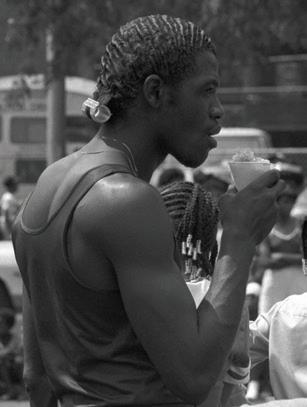

When the very presence of unhoused people on the CTA is considered a public safety concern, who is the public, and what are we keeping them safe from?
By KATIE PROUT p. 12
“Why you talking to a bum?”



When the very presence of unhoused people on the CTA is considered a public safety concern, who is the public, and what are we keeping them safe from?
By KATIE PROUT p. 12
“Why you talking to a bum?”
16 Cannabis Legacy operators with cannabis convictions face barriers to moving on.
04 Street View Style at EXPO Chicago
06 Research Chicago, birthplace of blood banks
08 Podcasts Otherworld looks at ghosts and other Chicago visitors.
10 Feature The CHAAD Project advocates for Chicago hospitality workers.

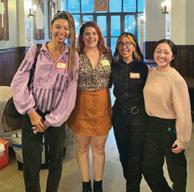
12 Cover Story | Public Safety
Katie Prout looks at the CTA
19 Joravsky | On Politics Karen Lewis would be thrilled.
20 Isaacs | On Culture More woes for Northeastern Illinois University
22 Books Catherine Lacey’s Biography of X tackles the mystery of personhood.

24 Art Gio Swaby’s vibrant textile portraits celebrate Black women.
25 Art Sarah Whyte makes space for transnational adoptees.

26 Shows of Note Recommended exhibitions at Compound Yellow, Iceberg Projects, and more
28 Preview London Road at Shattered Globe
30 Dance Visceral Dance visits Harris Theater

31 Plays of Note Recommended theater including Is God Is and Last Night and the Night Before

32 Feature Thai filmmaker Apichatpong Weerasethakul will appear in person at several upcoming screenings.
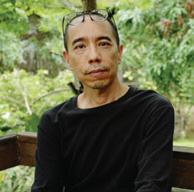
34 Movies of Note Renfield feels surprisingly fresh; Mafia Mamma should only be hate-watched with friends; and The Super Mario Bros. Movie finds its heroes humanized and overexplained.
36 No Sé Discos The Brighton Park-based label based on working-class values
40 Gr8 Thinkaz A Chicago hiphop collective including Mother Nature and Heavy Crownz
42 The Secret History of Chicago Music Art-school punks Poison Squirrel
44 Shows and Records of Note Previews of concerts by Lies, Kokoko!, Debby Friday, and others, plus reviews of new releases by Dorthia Cottrell, Jesus Piece, and SolarFive with Custom Made
50 Early Warnings New and upcoming concerts
50 Gossip Wolf Scene-powering fusion collective Cordoba celebrate a new album, and singersongwriter Hannah Sandoz levels up their atmospheric folk.
52 Jobs
52 Comics Thanks, Stormy!
54 Savage Love
CEO AND PUBLISHER SOLOMON LIEBERMAN EDITOR IN CHIEF SALEM COLLO-JULIN
PRODUCTION MANAGER KIRK WILLIAMSON
SENIOR GRAPHIC DESIGNER AMBER HUFF THEATER AND DANCE EDITOR KERRY REID MUSIC EDITOR PHILIP MONTORO
CULTURE EDITOR: FILM, MEDIA, FOOD & DRINK TARYN ALLEN CULTURE EDITOR: ART, ARCHITECTURE, BOOKS, LITERARY ARTS KERRY CARDOZA ASSOCIATE EDITOR AND BRANDED CONTENT SPECIALIST JAMIE LUDWIG SENIOR WRITERS LEOR GALIL, DEANNA ISAACS, BEN JORAVSKY, MIKE SULA STAFF WRITERS DEBBIE-MARIE BROWN, KATIE PROUT LISTINGS COORDINATOR MICCO CAPORALE COPY EDITOR AND DATA
ASSOCIATE SKY PATTERSON
VICE PRESIDENT OF OPERATIONS ANN SCHOLHAMER
DIRECTOR OF PEOPLE AND CULTURE ALIA GRAHAM
DIRECTOR OF MARKETING VIVIAN GONZALEZ MARKETING PROJECT STRATEGIST SHAWNEE DAY NEWSLETTER ASSOCIATE CHASITY COOPER SOCIAL MEDIA MARKETING
ASSOCIATE NIESHA DAVIS
TECHNOLOGY MANAGER ARTURO ALVAREZ OFFICE MANAGER AND CIRCULATION
DIRECTOR SANDRA KLEIN
DIRECTOR OF CHICAGO INDEPENDENT MEDIA
ALLIANCE (CIMA) SAVANNAH HUGUELEY
SENIOR VICE PRESIDENT OF GROWTH AND STRATEGY AMBER NETTLES
VICE PRESIDENT OF SALES AMY MATHENY SALES TEAM VANESSA FLEMING, TIM OGDEN, WILL ROGERS
DIGITAL SALES ASSOCIATE AYANA ROLLING MEDIA SALES ASSOCIATE JILLIAN MUELLER
ADVERTISING ADS@CHICAGOREADER.COM

CLASSIFIEDS: CLASSIFIEDS.CHICAGOREADER.COM
NATIONAL ADVERTISING VOICE MEDIA GROUP 1-888-278-9866 VMGADVERTISING.COM
JOE LARKIN AND SUE BELAIR
DISTRIBUTION CONCERNS distributionissues@chicagoreader.com 312-392-2970
READER INSTITUTE FOR COMMUNITY JOURNALISM, INC.
CHAIRPERSON EILEEN RHODES
TREASURER REESE MARCUSSON
SECRETARY KIM L. HUNT
DIRECTORS ALISON CUDDY, DANIEL DEVER, MATT DOUBLEDAY, VANESSA FERNANDEZ, TORRENCE GARDNER, ROBERT REITER, CHRISTINA CRAWFORD STEED
READER (ISSN 1096-6919) IS PUBLISHED BIWEEKLY BY THE READER INSTITUTE FOR COMMUNITY JOURNALISM 2930 S. MICHIGAN, SUITE 102 CHICAGO, IL 60616 312-392-2934, CHICAGOREADER.COM
COPYRIGHT © 2023 CHICAGO READER PERIODICAL POSTAGE PAID AT CHICAGO, IL ALL RIGHTS RESERVED. CHICAGO READER, READER, AND REVERSED R: REGISTERED TRADEMARKS ®





















EXPO Chicago inserts innovative fashion into the usually normcore crowd.

 By ISA GIALLORENZO
By ISA GIALLORENZO
Last week a peculiar crowd descended upon Navy Pier, not quite blending in with the spot’s usual and more conventionally dressed clientele. Tourists and local visitors sporting accidental normcore shared the looong path to Festival Hall with EXPO Chicago attendees, who never disappoint in serving the latest fashions.
Celebrating its tenth anniversary, it is fair to say EXPO is now a celebrated fi xture in our art scene calendar. This year the exhibition hosted 170 art galleries from 36 countries and 90 cities from around the world while promoting a wide variety of art-related events all over the city in a weeklong schedule.
It is an intense occasion for art enthusiasts, but their pilgrimage was made easier by the comfortable garments many of them chose to wear—without sacrificing style, of course. “I like it when comfort meets style,” said artist, fashion designer, and entrepreneur Marquinn Gibson, the owner of Woodlawn’s 7323 Chicago Cafe. He accessorized his custom-made and Nigerian-inspired suit with a Comme des Garçons sports hat and a pair of New Balance sneakers by local designer Joe Freshgoods.
Also wearing a pair of New Balance sneakers, fi lmmaker Curtis Taylor Jr. couldn’t have looked more comfortable or stylish, alongside his dazzling fi ancée Danielle Washington, whose favorite accessory was her jade engagement ring. Together they run lifestyle brand Pompeo Home.
Another lovely duo was Taina Cruz and Grant Strudwick, artists who exude fashion proficiency. In addition to thrifted garments, Cruz was donning knee-length socks by Vivienne Westwood, a bag by Maison Margiela, and elf shoes by Trippen, a German brand. Strudwick wore sneakers by Maison Mihara Yasuhiro and a shirt by Jacquemus.

The unexpected bout of late spring weather also influenced more casual fashion choices. Bojan Radojcic, who was wearing a matching

dress and bag by Etro, had a di erent outfit planned but decided to change directions at the last minute: “I was like, ‘Let’s be on a boat.’ It is literally a pier, so let’s do it.” A gold knot Phoebe Philo-era Celine bracelet complemented the nautical look.

Conceptual artist Gage Sixkiller went for a “relaxed chic” vibe: “I’ve got a couple of designer pieces, a couple of vintage pieces, all very comfortable. But you’ve gotta bring in the color and the uniqueness,” they said while sporting Loewe sunglasses, Y/Project jeans, a SC103 belt, Raf Simons sneakers, a Fendi baguette, and a T-shirt by local designer Petrichor. Sixkiller’s friend, Chloe Phoenix, wore a vintage Pucci dress and a pair of Nike Air Force 1s, “because I knew I was gonna do a lot of walking,” she explained. Her West African print tote bag is a prized possession given to her by her mom and Nigerian stepdad. “I’ve been really inspired by the [African] diaspora and trying to incorporate that into my outfits,” Phoenix added.


African accessories were the highlight of Kora Johnson’s look: “This necklace—my centerpiece of the night—is from Nairobi, Quenia, which was my fi rst trip to Africa. A Masai warrior was selling all these beautiful pieces, and she had this necklace on. She gave it to me, so this is something I hold dear to my heart.”
Johnson was sporting a hand-me-down jersey she got from an older cousin, and an orange bag she brought from New Mexico, hoping to call up spring weather. The bright hue of orange also graced the outfits of artist Lex Marie and journalist Emily Mack. “Orange is my color for the season,” said Marie, who mixed her orange accessories with light pink cargo pants and a thrifted multicolored couture jacket, perfectly embodying the easy chicness of the event. v

Dr. Bernard Fantus created a new standard in Cook County in the 1930s.
 By DILPREET RAJU
By DILPREET RAJU
Ch icago is home to deep-dish pizza, the first Ferris wheel, house music, and, to the surprise of many, the world’s first-ever full-scale blood bank.
Medicine took a massive leap forward on March 15, 1937, as Dr. Bernard Fantus opened the first official blood bank with regulated procedures for obtaining, storing, and using blood at Cook County Hospital, now known as the Cook County Health and Hospitals System.
“We couldn’t do half the things we do today, in terms of surgery,” without the invention of the blood bank, said Dr. Claudia Fegan, Cook County Health chief medical o cer since 2013.
“We couldn’t treat cancer patients if we didn’t have a blood bank,” Fegan continued. Chemotherapies “can be toxic to the bone marrow and then the patients need to be supported while their bone marrow recovers.”
It’s called a blood bank as various quantities of blood are “deposited” and “withdrawn” as needed, with a balance sheet to match.
Fegan noted that advancements in the nearly 90-year history of institutional blood banking now allow for blood banks to test for multiple contaminants and separate one blood donation into packaged blood, plasma, and platelets.

“When most people think about transfusions, they’re thinking about packed red cells, but after you give so many units of packed red cells, you also have to give some of the other things—platelets to help with clotting and plasma as well,” Fegan said. “We use it for di erent purposes depending on the needs of the patient.”
Through use of centrifuges, medical technicians are “able to spin the blood and separate it based on the weight, separating components, and really, out of one unit of blood, you can serve multiple patients,” she said.
Fegan said Cook County Health utilizes more than 10,000 units of blood per year.
After a few months of operating Cook County Hospital’s blood bank, Fantus wrote a groundbreaking article in the Journal of the American Medical Association documenting the procedures and demonstrating the value of refrigerated blood within the medical setting.
Alan Ho stadter worked as a certified blood banker for over 35 years in Chicago before retiring in 2009. He worked at the original Cook County Hospital, fondly called “County” by Ho stadter and medical sta ers. One day in the 1970s, he found a plaque commemorating Fantus hanging inside the hospital.
“It had tarnished considerably. I had never heard of Dr. Bernard Fantus. I did not know that the term ‘blood bank’ came from his concept, and it was then that I started trying to find out a little bit more about him,” Ho stadter said. It was around then that Ho stadter was found by Muriel Fantus Fulton, niece of Bernard Fantus.
“I dug deeper into it, simply because she pushed me. She said, ‘You have got to keep pushing it. Nobody seems to know, everybody’s forgotten my uncle was a famous guy,’” he said.
“[Fantus] looked at the work that preceded him and decided that [blood banking] should be codified,” Ho stadter said. “And that it should be organized so that people weren’t practicing medicine in an aberrant way from one hospital or medical setting to another.”
One doctor who utilized the advancements created by Bernard Fantus for decades is trauma surgeon Dr. Richard Fantus, Bernard’s great-nephew. Until becoming the Advocate Illinois Masonic Medical Center department of surgery chairman in 2019, Dr. Richard Fantus worked tirelessly in operating rooms, with routine 40-hour shifts, and “was a big consumer of blood from the blood bank over the years.”
From a young age, Fantus knew his great-uncle was an important figure. “One might say medicine is in my blood,” Fantus said. “He was my inspiration.”
Nearly 20 years after Bernard’s death in 1940, the Fantus Clinic, an outpatient center, opened as an arm of Cook County Hospital. Richard Fantus and his family were in attendance when it was torn down in 2018 and paved into a parking lot for the Cook County Health Professional Building.
“Back when I was four years old, I was at the dedication of the Fantus Clinic,” he said, “I still do remember posing there with my little red bow tie.”
Richard Fantus said a major milestone from his career was being a part of the hospital’s transfusion safety committee, “where we went and used evidence to reduce transfusions, and, over the years, thousands of lives have been saved due to reducing the number of transfusions.”
“People think it’s like a medicine IV fluid, but it actually comes out from a patient, so nothing is without complication,” Fantus said. If hospitals can reduce the number of transfusions or the amount of blood transfused, they can decrease patient complications, he said. His immediate family is heavily involved in medicine, too, as his sons decided to become
doctors. Richard “Jake” Fantus is an assistant professor at the University of Kansas Medical Center, and Robert “Josh” Fantus works as a corneal surgeon at NorthShore Health System. Dr. Fantus stresses he never pushed his sons toward medical school.
“They both have traits that stem back to Uncle Bernard. They’re dedicated to patient care. They’re in it for the right reason. It’s not a business; it’s a profession,” Fantus said. “It’s hard for them—for all of us—as medicine has become [such] a monetized industry and some of the humanistic qualities tend to get lost when we’re looking at things other than just patient outcomes.”
“Fortunately, they both practice in an oldschool way; they talk to the patients. It’s an important part of what they do, so I’m proud,” Fantus said.

Though anyone can receive the benefits of blood donation and blood banking, donation has long been an exclusionary process for gay men and men who have sex with men. In 2015, the Food and Drug Administration (FDA) removed the lifetime ban in lieu of a one-year deferral, which the Human Rights Campaign (HRC) criticized.
“Human Rights Campaign believes that the updated policy, like its precursors, does not treat persons with like risks in a similar way,” its webpage on blood donations reads.
“HRC has strongly encouraged FDA to revise the donor questionnaire based on an individual risk assessment of sexual behaviors upon which all donors are evaluated equally, without regard to sexual orientation or gender
identity.”
When going to donate blood, potential donors must first go through a risk-assessment questionnaire about the donor’s personal history. That questionnaire asks if potential donors have engaged in anal sex, received short-acting PrEP (pre-exposure prophylaxis), or gotten a tattoo from a non-state-regulated entity within three months of a donation date. Those who answer “yes” to any of those questions are automatically deferred, meaning they must wait to give blood. In January, the FDA issued draft guidance that recommends changes to the donor history questionnaire that would remove gender identity from questions and reduce deferral periods to three months from the current length of one year.
It is currently unclear whether these drafted changes, which have yet to be finalized and implemented, will have an impact on donor eligibility and participation rates.
Hoffstadter volunteers at Rush University College of Health Sciences as an assistant clinical instructor for the master’s program in medical laboratory science and at local blood donation centers.
“Every time I go to a bloodmobile and serve juice and cookies,” Hoffstadter said, “one of the things I do is [tell people], ‘Hey, did you know that blood banking got started in Chicago in the late 1930s? Have you ever heard of Dr. Bernard Fantus?’ That’s my schtick. That’s what I do when I’m serving juice and cookies.”
@dilpreetrajusubmissions came flooding in.
“I kept doing it every year, and instead of running out of stories from my audience, there would be more—and they would get more extreme,” he said. “My thinking is that, if I treat these stories seriously and try to tell them in a way that I would any other serious story, more people will come forward to talk about these things. Which has proven to be true.”
As Wagner collected more stories and interviews, he realized he had enough for a spin-o series. When he released the first episode of Otherworld in October 2022, he imagined the passion project as a six-episode season. But the podcast blew up, and stories kept overflowing his inbox. The plan had always been to retire Yeah But Still after its 500th episode, which aired in February. Now, Otherworld has aired 29 episodes and has become Wagner’s full-time focus.

Wagner’s earnest approach to unbelievable stories has been a hit with his listeners. In less than a year since its genesis, Otherworld has taken o in popularity. At one point, it showed up as number seven in Spotify’s top podcasts list. On Apple Podcasts, it has 4.9 stars from more than 1,800 reviews. A Washington Post article called the show the “This American Life of ghost stories,” and delved into the Gen Z fandom spreading across message boards and Discord servers.
The Otherworld podcast explores the city’s stranger side.
By MEGAN KIRBYWhen Jack Wagner was 15, he made a documentary about the haunting of Wheaton’s Grand Theatre. Built in 1925, the historic theater went through several identities over the decades (including an aughts-era punk venue where Wagner’s band played). When he showed up with his camera, the owner shut Wagner and his buddies in the empty theater—and turned out the lights. And Wagner swears that he saw something moving as he looked up toward the ceiling—some-
thing he couldn’t explain. He recorded the experience, but when he tried to upload the video files, his computer kept crashing.
“I remember getting myself scared in a way where I sort of left the paranormal behind,” he said. “I just opted out.”
That is, until he launched the paranormal podcast Otherworld in 2022. Now, researching supernatural stories is Wagner’s full-time job. Episodes chronicle first-person accounts about unexplainable phenomena: ghosts,
aliens, cryptids, and beyond. And even though Wagner left Chicago for Los Angeles in 2014, the show has told several Chicagoland stories, including a “Chicago Tales” episode that delves into three stories adjacent to the Windy City.
Otherworld began as a segment on Yeah
But Still, a popular Patreon show that Wagner hosted with Brandon Wardell. In October 2020, Wagner asked listeners to email him spooky stories for a Halloween episode, and
The podcast’s 14th episode, “Chicago Tales,” tells three stories from the area: a UFO sighting in Beverly, a Mothman encounter in Elgin, and a Chicagoland woman who has been haunted by the same ghost since she was a teenager. Sometimes, the podcast is the first time the subjects have discussed their stories in depth.
Wagner says that when something unexplainable happens to someone, they often want to forget it and move on with their lives. It took some finessing to convince the Mothman source to come on the air. “If you saw the Mothman one time, what do you do with that?” Wagner asked. “You just put it away in the filing cabinet.”
Ultimately, that reluctance made the story more authentic. The source didn’t seek out the unexplainable; the unexplainable found him. “That’s the funny thing about Chicago stories, to me—the power of the Chicago brain to ignore something bonkers right in front
of their face,” Wagner said. “It’s the midwest stubbornness, you know?”
Jessi Czarnowski appears in the third segment of “Chicago Tales,” describing a haunting she’s experienced her whole life. When she was a teenager, her family moved into a house in Glen Ellyn where strange things began to happen: odd sounds, disembodied voices, and nights when she would wake up with her sheets tucked tight around her body in bed. She learned that a teen girl named Christina had lived in the house before and had died in a car accident. And ever since then, Czarnowski swears that Christina has followed her through life—perhaps out of yearning for college, romance, motherhood, and the other worldly milestones she never got to experience.
Otherworld is the first time Czarnowski told her story on record, and she’s grateful for the experience. She feels a camaraderie with other subjects who have appeared on the show. “Even if you don’t believe it, this is still such a huge part of our lives,” she said. “It happened to us. We experienced it. Jack does a great job of getting the listener to understand that.”
Once, a medium approached Czarnowski in public to confirm Christina’s presence. She has spoken to the spirit in dreams. And she finds that the more she talks about Christina, the more things occur. In fact, after she recorded the podcast episode, she visited her parents to listen together. When they were standing in the living room, something strange happened. “There’s this old music box that plays a creepy little tune,” she said. “All of a sudden, it played
a few notes. So we go and look, and the little people are just spinning.” Just Christina saying hi.
Wagner credits Czarnowski’s story as a turning point in his paranormal journey. The further he dives into the show, the more he opens himself up to new beliefs. Now, he records the show with skeptics in mind. “There’s a di erence between being open-minded and believing everything you hear,” he said. “But being skeptical is not something to be proud of. It implies writing something off before even learning about it.”
Chicago historian and author Adam Selzer, who runs tours under the Mysterious Chicago moniker, says that Chicago is no more haunted than any other city. Instead, the ghost stories become a record of the city’s history. “We have ghosts from the Pullman Riots. We have ghosts from the Eastland Disaster. We have ghosts from the Great Chicago Fire,” he said. “In a lot of cases, that’s just how the history stories survive. After the history itself fades away, people remain interested in the ghosts of it.”
In fact, Wagner’s very first experience with the paranormal ties into one of Chicagoland’s famous hauntings. When he was in high school, a teacher claimed to have been in attendance when a famous ghost photograph was taken at Bachelor’s Grove Cemetery in Midlothian. In the photo, a pale figure of a woman perches on a headstone. The people in attendance claim that no one was sitting there when the camera shutter clicked. The story fascinated Wagner. In fact, that same teacher fi rst told him about the haunting of the Wheaton Grand.
So what’s next for Otherworld ? As the show expands, Wagner has plans for longer, stranger, more intense stories. He has a backlog of interviews from Chicagoland. He’d love to plan more multiepisode arcs and maybe even start reporting in person for certain stories. And he’d like to keep learning about things that, up until recently, he wouldn’t have believed. “There’s no shortage of these stories,” Wagner said. “As I put out better episodes, people continue to come out of the woodwork and tell me things that I never thought I’d be hearing.” v

a praise poem for Sukihana after Sukihana’s ‘Cornbread TV’ Interview
By E’mon Laurentiger under the eye. a tribal blaze, for all chocolate girls in the heat of melt. they want us, stable saterns, to a galaxy we would never return to. she holds us, accountable to all we deserve to be. drop gems out the coochie. and let that be enough. don’t let my mouth open. it’s stuffed with crab and lobster. chicken cauliflower when the crows come home to roost. i boost a n*gga up, dafuq? i can be Suki. i can be whoever i wanna be, da fuq. i’m exclusive. throw up on the last person i didn’t wanna become. the n*ggas i date could’ve been something more than ordinary people. don’t disgrace me because i’ve been a Delilah they’ve paid for. some n*gga, got his foot kissed before, and didn’t deserve the offer. now it’s coins up. tithes for titties. don’t play with who you think i don’t know i is. a national treasure. an over deserted country’s last chance at wet. we that good good. the type n*ggas love.
E’mon Lauren is a blk queer Scorpio, from the Wes and Souf side of Chicago, whose work unpacks her coined philosophy of “hood-womanism”. She was named Chicago’s first Youth Poet Laureate. She has been featured in Vogue Magazine, Chicago Magazine, and The Chicago Tribune. She is the host of her podcast “The RealHoodwives of Chicago, and her first chapbook of poems, COMMANDO, was published by Haymarket Books, Fall of 2017.
Poem curated by Chima “Naira” Ikoro. Naira is an interdisciplinary writer from the South Side of Chicago. She is a Columbia College Chicago alum, a teaching artist at Young Chicago Authors, and South Side Weekly’s Community Builder. Alongside her friends, Naira co-founded Blck Rising, a mutual aid abolitionist collective created in direct response to the ongoing pandemic and 2020 uprisings.
A biweekly series curated by the Chicago Reader and sponsored by the Poetry Foundation.

Free Programming from the Poetry Foundation!





Hours
Wednesday, Friday, and Saturday: 11:00 AM–4:00 PM
Thursday: 11:00 AM–7:00 PM
Join us for a reading and conversation with Renee Gladman, Eileen Myles, and Simone White as they celebrate their new book releases.
Thursday, April 20, 2023, 7:00 PM
Staff & Friends Reading
Join us for a reading celebrating new book releases by Poetry Foundation staff and friends: Adrian Matejka, Maggie Queeney, Charif Shanahan, and Patricia Smith. Get to know some of the people behind the Foundation’s programs, including Poetry magazine.
Thursday, April 27, 2023, 7:00 PM
Alex Katz: Collaborations with Poets
Experience the first exhibition to bring together the full range of materials that showcase renowned painter
Alex Katz’s extensive collaborations with poets.
Open through May 20, 2023
Learn more at PoetryFoundation.org
The CHAAD Project advocates for workers in Chicago’s hospitality industry.
By TESNEEM ELEWAIn March 2020, Raeghn Draper was one of the many people furloughed from a hospitality job in Chicago. Draper was accustomed to the instability of the industry, but this time was di erent. The COVID-19 pandemic came at a time when food service workers were increasingly standing in solidarity against their employers; the furloughs brought to the surface feelings that had been brewing for years. What began as a “whisper network” of industry people and places to avoid because of worker mistreatment eventually transformed into a hospitality workers movement. Growing dialogues about Black Lives Matter and other social justice movements empowered workers to advocate for safety, stability, and accountability. With nearly everyone out of a job and nothing to lose, they organized.
Draper and fellow coworker Leah Ball crafted a letter to their employer, a local hotel.
They asked for safety precautions and PPE, an increase in the hazard pay rate to $28 an hour, and acknowledgment of the interracial dynamics in their workplace. Half the employees signed the letter.
Before the pair submitted the letter, Draper’s employer had already put out a statement in support of Black Lives Matter and made a monetary commitment to a justice organization. Draper and their fellow employees used that as leverage in their letter. “Because if Black Lives Matter,” Draper tells me, “then you would do anything—you would actually protect your primarily Black and Brown sta by implementing these measures and by paying them a hazard pay.”
Ultimately their letter was met with “annoyance and concerns about an effort to unionize,” Draper says. The employer raised wages to $15 an hour instead of the requested $28 and implemented only some of the requested
safety precautions.
Draper and Ball began searching social media for statements made by other establishments. As they were collecting this information, curiosity from other workers began to brew, and industry folks began asking for the information Draper was gathering.
In June 2020, Draper and Ball founded the CHAAD Project, which stands for Chicago Hospitality Accountable Advocacy Database. Because there were suddenly no jobs to be had, workers felt they had no reason to stay quiet about things they hadn’t publicized for years out of fear of retaliation—anything from working in a harmful or threatening environment to being fired to being blacklisted in the industry by the employer.
“The difference now, with working on the CHAAD Project, is that it doesn’t function as a whisper network anymore. Those grievances are coming out,” Draper says. “Folks are more
comfortable speaking about abuse in their workplaces, either on platforms like CHAAD, through our network, or just taking it on social media themselves.”
The hospitality industry historically has played a part in facilitating and allowing problematic individuals to thrive. In the summer of 2020, the whisper network found an online community through sharing information. Social media accounts such as the @the86dlist gave hospitality workers a space to anonymously share their stories of injustice, racism, and abuse in their workplaces. In the wake of this movement, the CHAAD Project became a parallel e ort, not to call out abusers by name but to provide information to hospitality workers about what systemic justice in the industry can and should look like. The CHAAD spreadsheet functioned as a diversity and business ethics database. It included which restaurants were (and were not) making statements and promises regarding Black Lives Matter, the racial and ethnic makeup of the staff, and whether they were BIPOC-owned.
Draper and Ball began by posting the information to their own personal Instagram accounts, sharing what they’d collected.
“It kind of blew up, which we did not expect,” Draper says. “But I think workers finally felt like, ‘Oh! This is a place where we can be heard, where our voice matters, where we have strength,’ and it was received really well.”
People began reaching out with interest in the movement. Many contributed information to the spreadsheet; some contributed their skills, like therapist Emily McCoy, who aided CHAAD with resources on mental health and trauma-informed care, and Molly Pachay, who contributed her community organizing skills.
“While being involved in the CHAAD project, I think my ability to advocate for myself dramatically changed,” says Pachay. “So now, for me, I know what I will and will not accept in a job. I know how to advocate for myself and also to talk to other people about how to advocate for themselves and give them tools for that.”

Soon, the CHAAD Project outgrew the spreadsheet, which had become too large to keep up-to-date, and became a direct-action organization. In spring 2022, more than 100 workers attended CHAAD’s workshops on microaggressions, stress and trauma, boundary setting, and identity in hospitality spaces.

“Folks really like the conversations that we’re starting, and sometimes that’s what a lot of it is: let’s just have conversations and raise awareness so that when we are confronted with these things, we have the language to talk about them and to set clear boundaries,” Draper says.

Pachay credits these workshops with helping hospitality workers better understand and express what they are experiencing and how it needs to change. “I’ve heard a lot of folks talk about how they feel a lot more comfortable setting boundaries now. Because they have the language to do so, and they know what some of their rights are in a workplace,” she says.
Community and love for the industry are at the heart of the CHAAD Project’s work. For hospitality workers who are looking to improve their work environment, CHAAD founders reinforce that a collective of workers are more powerful than an individual, and they recommend finding comrades in the workplace when attempting to make systemic changes.
Alongside the workshops, in fall 2022, CHAAD hosted a hospitality workers’ town hall in partnership with Studio ATAO (All Together at Once). Workers came together at employee-owned bar Beermiscuous in
Lakeview to discuss and radically imagine what the future of accountability systems and sustainable systems based on mutuality could look like.
When asked if CHAAD would ever host a town hall or workshop for hospitality managers and owners, Pachay candidly explained the experience they’ve had in the last couple years. “I think once we get enough interest in management and ownership, we would develop more resources for them,” she says. “But in the handful of times when we reached out to groups or independent owners, we haven’t gotten the best response. They’re interested on a surface level, but when you get down to the nitty-gritty, they don’t engage, and they just kind of drop o . . . . Essentially, folks were more focused on protecting their image than actually engaging with the content.”
Draper agrees: “We are the ones who started creating systems of mutual aid and support. It wasn’t our businesses that protected us. So, if owners or managers want to come along for the journey, they’re welcome, but we’re not doing this for them; we’re doing it for the workers.”
And yet, Pachay says, some employers are taking note of workers’ newfound power and voice, and several are trying to honor their demands. “Some owners are very desperate for resources, not just for healthy communication styles and how to create a nontoxic workplace. But basic stu , like how can a very small business feasibly o er health insurance to employees when it is so wildly expensive,” she says.
“I think a lot of this has started conversations
[with members of] ownership who do want to do better by their workers, who do understand that longevity is very much dependent on their workers.”
Briana Hestad, owner of Nordic-inspired brewery and restaurant Ørkenoy, is no stranger to traumatic and noninclusive experiences in the hospitality industry. She describes her time teaching beer courses in London, after studying brewing production in Denmark, as nothing short of sexist and discriminatory. “Just the amount of people that would be like, ‘Why are you teaching me?’ Those are some of the same people who go on to own their own breweries,” she says.
Ørkenoy pays their front-of-house workers—who do everything from serving to hosting and bartending—above the city’s minimum wage and has a 20 percent automatic gratuity in place. They o er health insurance to all employees who choose to enroll and aim to o er more benefits, including paid time o and a 401(k), in the upcoming years.
Hestad has been following the CHAAD Project over the years, learning from their ed-

ucational content posted on Instagram, which currently has more than 5,000 followers. “I know what my team wants, but maybe they are also not telling me totally what they want. So maybe there’s some other answers here,” she says. In addition to the Illinois state mandatory sexual harassment training, Ørkenoy has implemented mandatory cultural competence training that covers unconscious bias, microaggressions, and body language. Hestad is also working with Pachay on an anonymous staff survey of her employees; CHAAD will analyze the results and provide Ørkenoy with recommended actions to take.
“Sometimes you need to step outside of yourself to kind of see things,” Hestad says. “You get so blinded by the day-to-day that you forget to think about . . . what can we do better to provide for our team, giving them the resources that they need. . . . It is di cult, both mentally and physically,” she says. “But those initial e orts are priceless if you want to have a successful space.” v @Chicago_Reader
One morning late in February, I was riding the Red Line, one cracked earbud in my ear, when a hoarse, good-natured voice boomed through whatever depressing podcast I was listening to.
By KATIE PROUT“Good morning! Good morning, fellow Chicagoans! I hope you all have a beautiful day.” A stocky middle-aged Black man, swaying slightly, had just boarded at the Sheridan stop. Standing near the door with a can in his hand, under the clang of doors and recorded CTA announcements, he greeted everyone who entered and exited, none of whom greeted him back. His expression was pleasant, hopeful. I watched as he tried mightily to make eye contact with anyone; a few of us smiled cautiously over our masks. “Good morning! How are you?” he asked one of us, a white man standing near the door. The man obliged.
As they fell into conversation, I felt the rest of the train begin to relax, and I began to zone back out. “I’ve been sleeping on the CTA for
six months. Can you believe that?” I sat up and took my earbud out.
This is how I met Tracy III, age 52, a former CTA worker, current resident of the Red Line, and a believer in both the Candyman and Christ.
“I be afraid to talk close to people because my breath don’t smell as good, but you got your face covered,” he said as we made our way to two open seats. I assured him he was fine. “I probably just smell like alcohol,” he chuckled. “But I ain’t mad about my drinking. Jesus came down, and he drunken the wine, though people won’t tell you about that.”
Last year, Tracy’s apartment caught fire after he tried to cook some french fries. “Me and my landlord fell out,” he said. “I went to court and tried to fi ght her, but she wanted me out.” He’s been homeless ever since. “I can go deep with you, young lady,” he continued. “I’m homeless for a reason: due to that landlord. How one person destroy somebody’s life like that, and cause me to be homeless?”
What’s it been like to stay on the CTA? I

asked.
“What has it been like?” he repeated back to me, a little incredulous. “To tell you the truth, like hell.”
The day before, someone stole his sunglasses. A few weeks earlier, Tracy was asleep on the train when someone else stole his whole bag, which included his ID, Social Security card, and birth certificate. “I should have never hid it all in one bag,” Tracy lamented. “I woke up with no identification.” After the theft, Tracy went to the Harold Washington Library in the Loop, where social workers and case managers set up o ce hours every Monday, Wednesday, and Thursday on the third floor. They provide free services like legal assistance, housing intake, and more: “They gave me all the papers to get my ID back,” Tracy told me, “but this is so sad—somebody stole that!”
The repeated thefts Tracy experienced fit into a pattern of anecdotes I’ve heard from other unhoused people who stay on the CTA. I was interested in talking to him about his
When the very presence of unhoused people on the CTA is considered a public safety concern, who is the public, and what are we keeping them safe from?
“It take a lot to live on this train for six months,” said Tracy.
experience using the CTA for shelter because, for a while now, I’ve no longer understood what we’re talking about when we talk about public safety on the CTA. By “we” I mean housed Chicagoans who ride the trains, but also media and local politicians.

“I defi nitely don’t feel safe,” one CTA rider told NBC Chicago in March. Another called for police o cers in every station so “we can feel secure.” I ride the CTA multiple times a week and have no shortage of experiences that, at some point, have made me feel tense or uncomfortable. But there’s a difference between feeling uncomfortable or unsafe and being in actual danger. Police might make some people feel safer, but there are many studies that demonstrate that an increase in police leads to an increase in misdemeanor arrests, which does not reduce crime, especially not the violent crime housed people are told they’re at risk of on the CTA. What do these arrests accomplish? They “keep people from jobs, housing, and welfare benefits” and “make it harder for police to investigate violent crime,” according to the Equal Justice Initiative. Another study from TransitCenter found that increasing police on public transit increases racial discrimination and disparities in enforcement of the law: “The overreliance on police for routine safety issues often makes riders less safe, as police response to ‘code of conduct’ issues like putting feet on seats, eating food, or not paying the fare is consistently discriminatory against Black and brown riders and regularly escalates into incidents of brutality.”
Especially around election times, “public safety” gets thrown around by politicians and government o cials as a buzzword. Who gets to be a member of the public in public safety, and who doesn’t? “They can’t be in our airports,” said Mayor Lightfoot (emphasis mine) at a press conference shortly before February’s general election, after city police swept unhoused people from O’Hare. In Meeting the Moment, the post-pandemic action plan released by CTA president Dorval R. Carter Jr. in August 2022, the very presence of unhoused people on the CTA is listed under “Security issues.” “CTA has also seen
growing concern from our customers about unruly behavior and crime near and on our system,” the memo reads (emphasis mine). “[I]ndividuals struggling with homelessness, mental health issues, and drug abuse are often utilizing CTA as a shelter of last resort, raising concerns around safety, cleanliness, and overall function transit [sic].”
Safety for who, and from what? What are we talking about here, exactly? To my knowledge, no evidence exists that shows unhoused CTA riders are more likely to commit crime or exhibit “unruly behavior” (whatever that is) than their housed counterparts, and yet this narrative linking the presence of unhoused people to dangers and discomforts for housed riders has been repeated over the last couple years: “CTA is developing plans with social service agencies to address issues of mental health and homelessness that also a ect safety on trains and buses,” reported WTTW after the memo’s release; “Enhance safety for riders by expanding police o cer patrols with the Chicago Police Department, increase the number of security guards from 200 to 300, reintroduce canine units, target fare theft with new tall fare gates and collaborate with social services organizations for unhoused people,” reported the Sun-Times.
“[The CTA is] . . . a big, crashing mess at the
moment, with the tubes filthy and stained with gra ti, elevators and escalators out of operation, cars converted into rolling homeless shelters, rules about eating and smoking seemingly forgotten, and police presence all but invisible,” wrote Crain’s Chicago Business ’s Greg Hinz in 2021, with the cadence and restraint of Peter Venkman terrifying the mayor in Ghostbusters. In the accompanying photo, taken by Hinz, a Chicagoan is curled up across four seats, huddled under a dirty jacket. “People just aren’t going to ride a system that is dirty, dark and scary,” he continued. “Are you listening, Mayor Lori Lightfoot?” A quick Google search of “Chicago CTA homeless” pulls up other photos of people—asleep, unconscious, and presumably unconsenting to being the example of all that is “dirty, dark, and scary”—in stories from CBS News, ABC7, WBEZ, Medill, and the Chicago Defender, among others.
Not every person who is homeless is mentally ill or uses drugs, and having one of those traits—or all three—doesn’t make you dangerous; it makes you vulnerable. Indeed, study after study demonstrates that people without homes are far more likely to be victims of violent crime than they are to commit it. “While suffering in plain sight, and making many housed people feel uncomfort-
able, the vast majority of homeless people, including people with mental illness, aren’t hurting anyone,” wrote Steve Berg, chief policy o cer of the National Alliance to End Homelessness, in a 2022 blog post. That truth didn’t stop the majority of us riders, myself included, from tensing up when Tracy boarded, beer can in hand, and tried so hard to get any of us to say hello. I focused on myself and a perceived threat to my emotional comfort. What if Tracy was so drunk that he made me feel sad, or what if he asked me for money and I felt guilty? What if he became verbally pushy, and I had to be assertive? What then?
What happened was this: The train kept moving, and Tracy and I rode it together. He told me a little about his life growing up in Cabrini-Green, raised by parents who were together until death. For about eight months in 2017, Tracy even worked for the CTA himself, cleaning the train cars. But his father’s unexpected death triggered a profound depression, exacerbated by family strife in the wake of the loss. “Sometimes you need a damn addiction dealing with people!” he told me when I asked him what he thought about others linking the presence of unhoused or addicted people on the CTA to a rise in crime. “If you’re really depressed, you want something to take the pain away. ‘Pain’—that’s
KIRK WILLIAMSON FOR CHICAGO READERA TransitCenter study found that “The overreliance on police for routine safety issues o en makes riders less safe, as police response to ‘code of conduct’ issues like putting feet on seats, eating food, or not paying the fare is consistently discriminatory against Black and brown riders and regularly escalates into incidents of brutality.” KIRK WILLIAMSON FOR CHICAGO READER
my nickname. My best friend named me that years ago, back in Englewood. It meant I could take some pain. It take a lot to live on this train for six months.”
My stop was Lake. As we neared it, I asked Tracy what public safety measures he needed to be safe on the CTA. His answer surprised me. It didn’t include more police, arrests, or cameras.
“The people need jobs!” Tracy exclaimed. “Don’t get no job, you gon’ see more evil. And it ain’t just Black people; it’s all people. If they don’t start hiring these people, man, it’s gonna get worser. I see young girls walk through here selling drugs. They ain’t got no job. They got nowhere else to turn.”
“There’s an irony in the public discourse around public safety,” Doug Schenkelberg, executive director of the Chicago Coalition for the Homeless, said to me over the phone. It was March 28, one week before a mayoral election largely defined, in both local and national media, as a referendum on whether or not Chicagoans felt safe.
“It’s framed—often within the media and particularly in relation to CTA—that the folks who are unsafe are the housed people using the CTA, and that their safety is threatened by the presence of people experiencing homelessness,” Schenkelberg continued. He and I spoke for almost an hour, and what follows is part of that conversation, lightly edited.
Doug Schenkelberg: Many folks are uncomfortable when they get on the el and they see someone they assume might be homeless. Many people, unfortunately, make a leap to thinking they’re unsafe, or their safety is compromised by their presence. But that’s what pushes us toward criminalization of folks experiencing homelessness and treating them as people who are doing something that’s against the law, or potentially are more apt to do something against the law—conflating discomfort with being safe.
If you’re someone who is unsheltered, you seek out whatever is the safest situation you can fi nd. That safety is about protecting yourself from the elements. It’s about being able to protect things you have. It’s about having some form of community that provides a feeling of safety, and CTA provides them with that.
On the CTA, who is the “public” in public safety?


I think that the common framing of it is the public is folks who are housed. Folks who are using the el to commute from home to work or home to an event, not people who are using it for temporary shelter.
There’s an idea that people experiencing homelessness and people that are maybe engaging in acts that are violent or constitute a crime are one and the same. But the reality is, the folks who are homeless are on the CTA because they’re seeking safety.
What, or who, is this discourse trying to keep a certain public safe from?
I think the reality is that race is a huge factor. Folks experiencing homelessness are predominantly Black and Brown.
The other factor is being confronted with poverty, being confronted with the failings of our society.
People who are visibly mentally ill, it shows the fault lines in our system.
There’s a tendency to want a quick solution. And that quick solution is about getting the problem out of the line of sight. The solution is for the person that feels uncomfortable. It’s not a solution for the person experiencing homelessness.
The fundamental issue driving homelessness isn’t going to be solved with more cops. Our mantra has been that we need a dedicated revenue stream like Bring Chicago Home. What’s it like to have a system that’s actually adequately funded and that you know is going to be adequately funded year after year? That’s a very di erent dynamic to addressing the problem than the way that we do it now.
What we hope for, with any administration, is that the focus is on people whose safety is really at risk. And those are the people experiencing homelessness. Resources and solutions have to be directed toward them: that’s permanent housing; that’s supportive services. Long term, that is a much better, smarter strategy, and a better investment for the city, than criminalizing people who are unhoused.
Five days after meeting Tracy, I ran into him again, on the same day news broke that Kevin Powell, a 54-year-old Chicagoan who relied on the CTA for shelter, was beaten to death by a CTA employee. Tracy and I were both at the Jackson Red Line stop; I boarded the train with him and rode to Roosevelt so we could catch up.
Tracy was distracted and sad. A friend of his had just passed away, someone who went to the same soup kitchen as him. On the Roosevelt platform, we walked near a group of Black friends in their late teens and early 20s. While I was recording, Tracy suddenly called out to them. “Hey, y’all want an apartment? Talk to her, man, she’ll hook you up.” I explained that I didn’t have an apartment connection, but that I was a reporter working on a story about public safety on the CTA.
“Basically, everyone is gonna die on the mothafuckin’ train!” the only woman in the
group said to me, sounding exasperated.





“People getting robbed, shot, killed, all that.” As she and I began talking, some of the young men began to interrupt excitedly, vying for her attention and my microphone.

“His ass live on the train,” one said and tilted his head to Tracy. “Why you talking to a bum?” Tracy tried to join in. “I was talkin’ to you fi rst,” he interjected over their voices.

“Can I tell you a story? It’s so funny.”
“What’s funny, your BO?” replied one of the guys. A few others laughed. Tracy is with me, I said. It’s important to interview people who sleep on the trains, too. “That’s who’s gonna attack your dumb ass!” one of the guys shot back. The rest of the group yelled at him to shut up, assuring me that their friend didn’t mean it. I didn’t mind, but everyone was talking at once.
This group conversation is good , I said, but can we take turns? A couple of the guys laughed, and for a minute or two, everyone
settled down to talk. I tried to include Tracy, circling at the edge, but he was still smarting from the comment about his smell. “You’re homeless too,” he muttered at the young man who said it. The man shot toward Tracy. “Fuck you, bro, what the fuck you talkin’ about! My momma have her own crib!” Pandemonium ensued as his friends started yelling too, most trying to get him to leave it be.

“I’m just messing with you like you messed with me!” said Tracy, edging away. “I’ll beat your ass!” shouted the young man, but he stopped moving closer. “We do NOT condone violence,” said one of his friends while looking at me. “We all just from Cabrini-Green.” A couple laughed. C’mon , I said. He wasn’t hurting you. Someone who is homeless isn’t necessarily hurting you, right? “No, no,” said the young woman, nodding in agreement. They’re just on the train. “His stench hurts me!” said the young man, still agitated, but less so.
“See, this is a prime example,” said one of his friends, “of the shit that just happens on the CTA. That was just ignorance.” You just wait for the summertime, they all assured me: it always gets worse then. Some of them had been jumped on the train; another knew a woman who had been sexually assaulted. And yet, they rode the train, just for something to do.
“We don’t, we don’t intend to hurt anyone,” said the young man now, earnestly and a little sheepish. Now that he was calm, he stood closer to me. He looked barely over 18. “We don’t wake up with bad intentions. Just trying to survive in this cold, cold world with these cold, cold niggas.” We talked a little longer. Before they boarded the next train toward Howard, I gave a few my card and said goodbye. After the train pulled away, I tried to fi nd Tracy, but he had disappeared. v @katie_prout
Craig Cesal was sentenced to life in prison for a cannabis offense before former President Donald Trump granted him a pardon.

Today he finds himself in a di erent position: director of advocacy and senior clemency case manager at his nonprofit, the Second Chance Foundation. Last year, the Oakbrook Terrace resident teamed up with attorney Huma Rashid, who wrote his clemency petition. Rashid has advocated on behalf of prisoners in situations similar to Cesal’s case. Cesal and Rashid collaborate to help those convicted on cannabis-related charges seek clemency and other judicial relief.
So far, the nonprofit is not representing any Illinois prisoners. Second Chance is in contact with an Illinois cannabis prisoner about possible representation, but Cesal said nothing has been confirmed yet. However, Cesal told the Reader that he’s planning to meet with Governor J.B. Pritzker’s o ce to ask what it will take to grant clemency for state prisoners with cannabis-related charges.
Though the public thinks Illinois has legalized cannabis, the truth is “if you get pulled over in your car with a pound of marijuana on the passenger seat, you face time in prison in Illinois,” Cesal said.
In the years following cannabis legalization in Illinois, weed has only been partially been decriminalized. Illinois has legalized recreational cannabis use, and the state’s legal cannabis industry has brought in billions of dollars in recent years, but the state still has cannabis prisoners incarcerated for o enses. And for free people with multiple cannabis convictions in multiple places and offenses involving more than 30 grams of weed, the process of expunging those convictions from one’s record remains cumbersome, sources told the Reader
According to the Illinois Department of Corrections prison population data set from December 31, 2022, there are 91 people incarcerated on offenses including cannabis tra cking and possession of cannabis of fewer than 5,000 grams, as well as producing less than 200 cannabis plants. The IDOC’s population data set also shows that 140 people were out on parole for cannabis-related offenses, including possession of under 5,000 grams of cannabis and cannabis tra cking. When the Reader reached out to Governor Pritzker’s o ce for comment on any additional cannabis criminalization e orts, his spokesperson did not comment as of press time.
The criminalization of cannabis doesn’t end with arrests and prison time for o enses involving more than 30 grams of cannabis. Cesal pointed out that people with cannabis convictions can’t apply to be a budtender, meaning a curator of cannabis.
“Let’s not forget the people like me who created the industry but are now locked out of it by Illinois law. That Illinois law should allow me to become a component of the industry, but it does not,” Cesal said.
Illinois NORML executive director Margo Vesely said that now that cannabis has been legalized in Illinois, her organization wants to begin raising grant funding to support organizations and providing interns for nonprofits such as Cesal’s that are helping to free cannabis prisoners, To start, the organization wants to host a fundraiser to support grant recipients. The advocacy group also has a program called Legacy to Legal that helps people who were involved with cannabis before it was legalized gain entry into the legal market, she adds.
“It’s ridiculous that we have legal operators doing the same thing that these people are doing. It’s just because you don’t have a li-
cense, you are behind bars,” Vesely said. “Had we not had the legacy operators here, where would [we] have been now? Would we [legacy operators] even be legalized? No . . . because there would have been less of a movement for it. So we have to honor it.”
Beyond being locked out of the state cannabis industry, people with cannabis convictions on their record also risk other consequences stemming from the federal prohibition of cannabis. For example, being convicted of a cannabis offense could impact one’s housing or immigration status, which are both regulated at the federal level, said Teri Ross, executive director of Illinois Legal Aid Online. Though Chicago has regulations prohibiting criminal records as the basis for denying housing, there are exceptions to the rule, she said.
And while cannabis prisoners remain incarcerated for offenses involving more than 30 grams of cannabis, legal operators have raked in $406 million in fiscal year 2020, $1.19 billion in fiscal year 2021, and $1.5 billion in fiscal year 2022, according to the Illinois Department of Financial and Professional Regulation’s 2022 Annual Cannabis Report.
As for Illinoisans with cannabis convictions on their records, the process for clearing their records can be time-consuming and complex, particularly for people with records across multiple counties, Ross said. To get rid of the records, they have to file petitions in each county where they have a record, she said, adding that many people have been arrested or convicted in more than one place.
In some cases, requesting those records requires the requester to get fingerprinted, which costs money, and sometimes personal information is entered incorrectly into the records, a problem that digitizing records could solve, Ross added. And once one files a petition to expunge these records, the petitioner has to notify the arresting authority, giving the state’s attorney the opportunity to object to an expungement, she said. Ross couldn’t say for sure how many people Illinois Legal Aid has assisted with their cannabis convictions.
“Of course, it’s the Black and Brown commu-
nities who’ve been devastated by mass incarceration. And I don’t think it’s any secret that the police, generally speaking, target Black and Brown people more than they target white people,” Ross said. “So it’s certainly those communities who have already faced multiple barriers to justice who are most a ected.”
For cannabis convictions that don’t qualify for automatic expungement, many Illinoisans may not know that they can get legal assistance to expunge their records, said Beth Johnson, coordinator for New Leaf Illinois. Her organization has done ad campaigns across the state, including bus ads in southern Illinois, CTA ads in Chicago, ads on Google, Facebook, and on the radio.

Ultimately, the best way to maximize the number of people who no longer have a cannabis conviction on their record is to implement an automatic non-petition-based system, Johnson said. But given that the state has 102 different counties with their own databases, processes, and systems, executing this will require a lot of resources, she admitted.
“If you’re putting the burden on a person, which has been the burden on people since
the beginning of time in terms of expunging or sealing and now expunging and vacating cannabis convictions, you are only going to get a fraction of the folks that are eligible,” Johnson said. “And until we shift that system . . . you’re going to see the same, only partial, results for people, not like systemic changes in people’s records, but it’s a huge investment of resources by the state to do that. But if they want this to happen, it’s the only way.”
Cook County State’s Attorney Kim Foxx confi rmed with the Reader that her o ce has expunged more than 15,000 cannabis convictions that qualified for automatic expungement under current law. There are some cases left dating back to the 60s that now qualify for expungement, but Foxx couldn’t say how many the State’s Attorney’s Office has left to clear. Doing so for cases from that long ago requires the o ce to search through very old records and fi nd the current address for qualifying residents.
The Cook County State’s Attorney’s O ce enlisted Code for America, a San Franciscobased civic technology nonprofit, to develop code for fi nding qualifying cannabis records within the Illinois State Police’s database
and generate the proper paperwork, Foxx said. Despite the COVID-19 pandemic slowing down the process as courts ground to a halt, working with Code for America helped the o ce automate the process, she said.
Reflecting on her childhood, Foxx recalled her mother, who suffered from bipolar disorder that was undiagnosed for many years, using cannabis to self-medicate. But had her mother been caught with the substance at any point, “there was a very real possibility that my mother would have went to jail . . . I have never forgotten what that could have [meant].”
Foxx said she hopes President Biden will take more action at the federal level to decriminalize cannabis beyond the federal prosecutions he pardoned in October. In the meantime, the patchwork of partial legalization will be led by elected o cials who take up the decriminalization work themselves, she said.
“What you’ve seen at the national level and in other places is where people feel like they have the luxury and privilege of time,” Foxx said. “They don’t see that person trying to fi ll out that job application and getting rejected because of a weed conviction. They don’t see that kid who is trying to get that scholarship money and has that conviction. It is not proximate to them. And so I think the lack of proximity to these real-world implications is why things have gone so slow.”
Ultimately, Cesal hopes the state of Illinois will regulate the cannabis industry like alcohol or other existing industries, and he wants the market to open up to those excluded due to cannabis criminalization.
“I want to get away from Illinois creating a monopoly of just a few select people and open it up so that there is inclusion and diversity throughout Illinois’s cannabis industry,” Cesal said. “I want to make it so that a person on the south and west sides of Chicago can open a dispensary even if they don’t have four or five million to spend. And I think that’s going to be the future of cannabis.”
Back in 2015, she was set to run against Mayor Rahm Emanuel. But she got sick and had to drop out of the race. I have no doubt she’d have mopped the floor with Rahm. Probably be finishing her second term right now.
Mayor Karen Lewis. That would have been something.
Nonetheless, Johnson’s win is Karen’s triumph. Wouldn’t have happened without her. A diverse coalition to elect a progressive mayor? That was Karen’s vision. Her dream. Her mission.
Before Karen Lewis took charge of CTU, unions in Chicago were timid and cautious and more insular than they are now.
At the risk of making you think I’m weirder than you may already think I am . . .
Sometimes when walking alone late at night, I talk to friends and family who have died. Been doing it for a couple of years now. Going back to the pandemic when the streets were so deserted they were ghostly. So far none of them have responded—if that happens, I’ll let you know.
Over the last few days, I’ve been talking a lot to my old friend Karen Lewis—former president of the Chicago Teachers Union (CTU)— with whom I once enjoyed countless phone conversations where we’d laugh our asses o at the insanity of what passes for normal in Chicago politics. Karen died of cancer in 2021. Obviously, I let her in on the latest news.
“Can you believe it, Karen? Brandon got elected mayor!”
She, of course, knows who Brandon Johnson is, as she was the one who hired him as an organizer for CTU several years ago. Just as she hired Stacy Davis Gates, the current CTU president and brains behind Johnson’s successful
campaign.
“And his opponent was Vallas—who’s been hanging out with MAGA loonies and is even worse than he used to be!”
Karen knows all about Paul Vallas because she was a high school science teacher back in the 90s when he was the Barn Boss at CPS.
“You’d be so proud of Stacy and all those young lefties we used to get such a kick out of. They were so focused, so disciplined, so strategic. Vallas had all the money, and he still couldn’t win. Though he scared thousands of lakefront liberals into voting for him.”
Then I cussed out lakefront liberals. Sorry, liberals. But while I’m at it . . .
Hey, liberals, what were you thinking? My guess is in a few weeks some of you will be embarrassed by that vote. It will be like something stupid you did in the back of a cab after you got shitfaced in a bar that you don’t want to talk about. In time, you may even convince yourselves that you didn’t really do it. Probably tell your kids you voted for Johnson.
Where was I? Oh, yes, Karen Lewis.
Their strategy was all about swapping blind support for the mayor in exchange for a raise for the rank and file.
Before Karen, union chieftains generally kept silent in the face of inequities. Looked the other way at nefarious privatization schemes. Let the mayor spend TIF funds on upscale development deals in gentrifying neighborhoods, even though they knew the rising property taxes were driving the working class out of town.
In other words, they stayed in their lanes. Made no waves. Got along to get along. Business as usual.
Karen had a different approach, building coalitions with community groups on housing, economic development, and other issues outside of wages and benefits for teachers.

Mayor Rahm wanted none of that. Soon after he was elected in 2011, he sat Karen down and told her how it was gonna be. He was gonna cut teachers’ pay and lengthen their workday. Said he’d eliminate union jobs by closing union schools and opening nonunion charters. Her task, he commanded, was to make her members fall in line. Or else . . .
Obviously, she didn’t bow to his commands. One showdown led to another, and eventually the epic teacher strike of 2012, in which the vast majority of ordinary Chicagoans—as opposed to the corporate, civic, and editorial elite—stood with the teachers. And Mayor Rahm had to back down.
Just like Mayor Lightfoot had to back down when the teachers—then led by Jesse Sharkey and Davis Gates—went on strike, demanding that the mayor hire more social workers, nurs-
es, counselors, and librarians.
So those community alliances Karen forged came in handy.
Not that mainstream Chicago changed its tune. In 2019, they were outraged that teachers went on strike even after Mayor Lightfoot o ered them raises. Essentially, they told the teachers to take the money, get back in the classroom, and shut up.
So let’s get this straight. Teachers have to go on strike to force the mayor to spend more money on nurses and social workers—which she should have done on her own—and they’re the bad guys?
It’s an old story in Chicago. If you stand up for poor people—especially poor Black people—the mayor and their enablers will vilify you.
Back in 1966, Dr. Martin Luther King Jr. himself led an e ort here to end poverty and segregation. Mayor Richard J. Daley fought him every step of the way. Eventually, King moved out of Chicago. So you might say poverty and segregation won.
Dr. King’s time in Chicago is part of our inglorious history that our leaders would rather not talk about. To his credit, Johnson brought it up in his election-night victory speech.
Naturally, the counterpunch was fast and furious.
Editorials in the Chicago Tribune and Chicago Sun-Times chided Johnson. He was moving too fast. He should be less confrontational. Why couldn’t he be more like President Obama? They called on him to assure Vallas voters he had no intention of keeping his campaign promises.
In short, Mayor-elect Johnson hasn’t even been sworn in and they already want him to sell out.
I wish Karen was around to read those editorials. She’d be laughing her ass o —cussing them out like they were lakefront liberals.
Yes, Chicago is a tough town—especially for people who want to do things like end poverty and segregation. As Dr. King and Karen Lewis discovered and Mayor-elect Johnson is about to find out.
Anyway, thank you, Karen. I’ll keep you posted on what comes next. v
@bennyjshow
The Reader’s weekly chef pop-up series at Ludlow Liquors.


Follow the chefs, @chicago_reader, and @mikesula on Instagram for weekly menu drops, ordering info, updates, and the stories behind Chicago’s most exciting foodlums.
April 24: Liquid Funk Fermentation Bistro with Jennifer Kim and Alt Economy @alteconomy




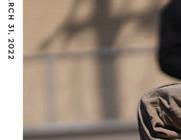



May 1: Grilling with Foodball O.G. Giong Giong @gionggiongpops


May 8: Puerto Rican jibaritos and munchies with Moncho Moncheo @monchomoncheo
May 15: Celebrating four years of Mom’s @momschicago


May 22: School Pizza Night with Chopped alum Crust Fund Pizza @nachosandlager
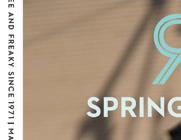

May 29: Memorial Day bye week

June 5: The return of Tasting India and friends @tasting_india

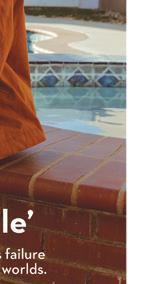


June 12: Roman-style, wood-fired pizza from Bad Johnny’s @badjohnnysgoodtimes

June 19: Tripping Billy’s greatest hits @therealbillyz






June 26: Central Texican barbecue with Heffer BBQ @therealhefferbbq
Head to chicagoreader.com/section/food-drink/monday-night-foodball/ for weekly menus and ordering info.

Awelcoming committee armed with signs and slogans gathered outside Northeastern Illinois University’s iconic El Centro building last Thursday, an hour before the university Board of Trustees was scheduled to meet there.
one sign read. “How much money have you spent hiring outside people to fire our own?” asked another.
Buoyed by suddenly summery weather and a DJ, members of the faculty union, NEIU-UPI (IFT local 4100, which includes librarians and advisors), and students who support them were there to call for action on contract negotiations that began last July and have stalled.

“I don’t want to strike, but I will if I have to,” they chanted. And “Ain’t no power like the power of the people.”
That doesn’t sound like a huge appetite for walking out, but the union put muscle behind the threat, filing an Intent to Strike notice with the state that same afternoon. Union chapter president and NEIU professor Nancy Matthews said 90 percent of chapter members had voted that week on the question of whether to authorize a strike if no contract agreement
can be reached, and 95 percent of them favored striking.
Issues to be resolved, according to the union, include resisting workload increases, encouraging more inclusive pedagogy, and— no surprise—compensation. Like just about every other working American, union members have, in e ect, received a pay cut thanks to inflation.
“The university should care about us as much as they care about their bond rating,” Matthews told the crowd. “We see structural racism at work when the Illinois public universities that serve our communities of color are the ones with the lowest salaries and the worst o ers.”
But a strike threat is only one of multiple problems at NEIU. This venerable institution, which was founded in 1867 as Cook County’s first teacher training school and, as recently as 2012, was cited by Newsweek as the “best university investment in Illinois,” says it is dealing with a multimillion-dollar budget shortfall this fiscal year. Enrollment has dropped from over 11,000 a decade ago to less than 6,000 for the fall 2022 term. The administration wants to consolidate and make cuts in course o er-
ings in response.
Declining enrollment is an industry-wide problem for higher education, as ever-rising costs and consequent student debt have led more young people to question its value. But NEIU’s fall 2022 enrollment drop of 10.6 percent compared to the previous year, and nearly 30 percent since fall 2018, is worse than most. Union members blame years of administrative mismanagement—especially in student recruitment—that have turned the school away from its mission of serving “nontraditional” students, including transfer students and returning adults (many attending part-time) with the flexibility and economy of a “commuter campus.”
Matthews told me that NEIU, which was the first four-year college in Illinois to be designated a Hispanic Serving Institution (Latinx students make up about 40 percent of its enrollment), has “dropped the ball on the students we’ve traditionally served” in a misguided attempt to focus instead on first-time, full-time students. (Former president Sharon Hahs’s 2013 “Decade of Dreams” expansion plan led to the building of NEIU’s first and not-yet-fully-rented dormitory and to its pur-
chase, including seizure through eminent domain, of commercial property on Bryn Mawr that it’s now trying to unload.)
Last fall the faculty passed votes of “no confidence” in both university president Gloria Gibson and the board of directors; the board subsequently decided not to renew Gibson’s contract, which expires June 30. WBEZ reported last month that Gibson complained to the governor’s office of a hostile work environment caused by racial and gender discrimination on the part of the board, and that she accused two board members of retaliating against her by blocking her contract extension after she refused their attempts to get scholarships for three students (including the wife of one of the board members) who weren’t eligible for that aid.
In late March, after it was revealed that Gibson had sought email records between Dan Maurer, a student journalist who’d been critical of her, and one of those two board members, the faculty senate passed a resolution asking the board to remove her immediately. They didn’t, but earlier this month Governor Pritzker appointed five new members to the board, including replacements for the two members Gibson complained about and for several appointees whose terms expired.
When Thursday’s board meeting got underway on El Centro’s third floor—with a standing-room-only crowd of demonstrators filling the room and a composed President Gibson in attendance—it was the need for new leadership that dominated the half hour allotted for public comment.
Just ten speakers were given three minutes each to address the board. Professor Isaura Pulido told them the next university president “must be local,” and faculty senate president Nancy Wrinkle made it clear that the faculty wants “to participate in the process of choosing an interim president.” And, in spite of the fact that Gibson was visibly still in place, four other speakers urged the board to immediately install Vice President of Finance and Administration Manish Kumar as interim president.
English department chair Timothy Scherman put it this way: “Accept that leader everyone is handing you, Manish Kumar. Appointing him this afternoon is your best option.”
That didn’t happen, and at press time no progress in contract negotiations, which are continuing this week, had been announced. That leaves open the possibility of an imminent, if reluctant, walkout. v
@DeannaIsaacs




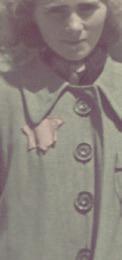
















 By DMITRY SAMAROV
By DMITRY SAMAROV
What if you fall in love with a monster who engulfs your entire world then dies? You’re bound to have questions, and, if you’re a writer, or just a certain type of obsessive, you’ll turn over every rock and upset every applecart looking for answers.
In Catherine Lacey’s immersive new novel, Biography of X, a journalist named CM Lucca goes on a quest that lasts nearly a decade and spans continents to discover the secrets within secrets her wife—last named X—left unanswered and perhaps unanswerable. It’s a book about the art world, American politics, alternate identities, and the unknowability of any one human by any other, told in the form of an epic investigation.
When CM (for Charlotte or maybe Cynthia, names are ever changeable) finds X dead in the office of their remote upstate New York cabin, the latter is at the pinnacle of a career as an artist/writer/musician. The subject of museum retrospectives, winner of awards, and target of envious colleagues and obsessed stalkers, X is a legendary genius committed to taking her true identity to the grave. When a sycophantic young writer named Theodore Smith contacts CM hoping to interview her about X for his forthcoming biography of the
artist, CM refuses—as X instructed her during her lifetime—but when the book comes out, full of errors, according to CM’s view, she begins her own winding quest for answers. Set in an alternate 20th century that has splintered the U.S. into Northern, Southern, and Western Territories after the Great Disunion of 1945, many known political and cultural figures play crucial but altered roles. The anarchist Emma Goldman, for instance, is an influential longtime senator from Illinois; Bernie Sanders is a multiterm president; and the art world is dominated by women as a corrective to male domination in prior centuries. It’s a world a lot like ours with a few important poetic changes, made to suit a 21st-century writer’s point of view. How resonant or familiar these changes come o will depend on each reader’s worldview and experience.
A megalomaniacal shape-shifter, X cycles through names and personas the way an average person rifles through the closet. Before CM goes on her journey, she is aware of a few of these alter egos but is repeatedly shocked as each revelation yields only more splintering, echoing layers. Allowed, under heavy guard, to visit the recently reintegrated Southern Territory, which had been under extreme
theocratic rule until its vanquishing by the North, CM meets X’s birth family and begins to build a timeline based on facts rather than mythology or obfuscation. The trouble is that the more she learns, the less she recognizes the consuming love of her life.
I was reminded of Bruce Wagner’s recent fi ctive oral history, Roar: American Master , while reading Lacey’s book. Both use nonfiction forms and incorporate historic figures and events to fashion a portrait of a great but maddening artist. But whereas Wagner revels and delights in his golem’s exploits, Lacey is cool and judgmental. No matter how brilliant X is creatively or how captivating she is romantically, she is a monster to be cut down to size, a balloon to be burst. X is a serial hoaxer, but is there anyone there once all the masks come o ? The art world is a vapid place full of schemers, climbers, and hangers-on, but I wondered at times whether Lacey thinks the whole idea of art (or writing) is a kind of scam.
Though based in an imagined New York— apparently the center of the art world even in a fictive universe—there are frequent references to Chicago, where Lacey lived for years until 2021. (She has X claiming to have bartended at
the Rainbo Club on a job application.) Being a biography, her book is rich with footnotes and citations—most invented—to real-life friends like musicians Tim Kinsella and Jenny Pulse as well as admired writers like Lucy Sante. A celebrated writer herself, Lacey generously populates her novel with fellow luminaries. By playing fast and loose with time, identity, and facts, Lacey fashions a universe in which creative people are much more important and influential than they are in ours. But in the end, I was left to wonder what the point of all this grafting, embroidering, and shifting of historical material amounts to. X is the love of CM’s life but also the beacon around which dozens of other satellites orbit. Is Lacey saying we’re all doomed to be lesser lights for those who consume and enthrall us? Does making art lead inevitably to destruction and desolation? CM demands a meeting with the coroner, expecting X’s cause of death to be murder or suicide, but the man insists her heart just gave out. It’s not a poetic conclusion but a very true-to-life one. Perhaps all that shape-shifting finally exhausted that inscrutable creature. v
“I keep saying, in this moment, I think we may be one of the bestkept secrets,” says Nicole Clarke-Springer, the artistic director of Deeply Rooted Dance Theater.
The critically acclaimed Chicago-based dance company is beloved for its spectacular storytelling and world-class performers, but still, it’s o en flown under the radar. In 2019, WTTW theater critic Hedy Weiss questioned why the company, which she described as “thrilling,” wasn’t more famous, informing readers, “If you haven’t caught up with this company, now is the time.”
Soon, though, Chicago’s best-kept secret will be secret no more because in 2023, Deeply Rooted is poised to break out in a major way: In addition to producing innovative performances, they’re building a new 30,000 square-foot state-of-the-art dance center at 5345 S. State and increasing their educational programming.
“Everyone needs to know who Deeply Rooted is,” says its executive director, Makeda Crayton. “We’re looking to elevate the status of the company and increase the visibility of the company in the city.”
Deeply Rooted was cofounded in the mid-90s by Kevin Iega Jeff and Gary Abbott with LaVerne Alaphaire Jeff, Diane Shober, and Linda Spriggs and made its public debut in 1996. The company has since performed around the world; in 2013, it became the first U.S.-based dance company to perform at Africa’s leading contemporary dance festival, JOMBA!, which is held in Durban, South Africa.
The company stands out for uniting modern, classical, American, and African American traditions in dance and storytelling. Much of its work centers the Black experience, but its themes are universal.

“We tell our stories, but we tell them so well that they become human stories,” Clarke-Springer says. “We’re all human. We have all those feelings of love, envy—anything that you have going on there’s something there you can identify with.”
Deeply Rooted is currently in the process of raising capital for their new facility, South Side Dance Center. Their plans include six studios—one of which will double as a black box theater—offic-
es, and green space. They hope the center will be used by several dance organizations, dancers, and artists from across the city.
“I wanted to help develop some institutions that would help to develop little Black girls and boys like me coming from the south side,” Crayton says. “I wanted to do it in the neighborhood or in the community that poured into me.”
As Deeply Rooted set its eyes on elevation, it’s connected with like-minded organizations. In 2019, the company joined the Chicago Black Dance Legacy Project, an initiative housed at the University of Chicago’s Logan Center for the Arts that seeks to eliminate inequities within Chicago’s dance landscape by providing funding, operational support, and performance opportunities to some of the city’s most revered Black dance institutions.

Following the Black Lives Matter movement, Crayton says that there’s been an increased focus on the inequity of resources and funding within the arts industry, making the mission of the CBDLP more important than ever.
“There’s been a shi in society,” Crayton says. “What came out of that time period was the realization that equity of resources in many different sectors [has] been lacking.”
The collective nature of CBDLP has felt special, Clarke-Springer says. A er years where some of the city’s Black dance institutions, unfortunately, felt siloed from one another, coming together to amplify Black dance has been a positive change.
“Before CBDLP, there has never been an intentional opportunity for a true sense of collaboration or a space for us to come together as the Black companies in the city to feel as if we were one entity,” she says. “Funding inequities siloed many of our or-
ganizations as we each worked to move our companies forward.”
Along with receiving funding, the companies within the cohort have performed together several times, the significance of which Clarke-Springer says cannot be understated. Last summer, the company performed in a CBDLP-hosted event at Millennium Park, which drew more than 7,000 people.
“I think performances like the Millennium Park performance, and people being able to come and see all eight of these companies, are important,” Clarke-Springer says. “That’s pretty impactful, whether we realize it or not, to see Brown bodies doing ballet, Horton, Graham, West African, and tap all in one space.”
Deeply Rooted has several of its own exciting events coming this year. It’s currently hosting auditions for its six-week dance intensive that kicks off June 5. Then on May 6, the company will honor Jeff and Abbott at its Annual Dance Education Spring Showcase. And this summer, the company will perform in the Chicago Park District’s Night Out in the Parks outdoor arts series.
As Deeply Rooted prepares for those upcoming events and performances, its leaders continue to foster community and provide opportunities for local dancers while centering the importance of storytelling through the art of dance.
“Part of the reason why the organization was founded as Deeply Rooted Productions is because there was always a greater vision than just a dance company,” Crayton says. “There was always more work to this, and that’s ingrained in everything that Deeply does. The dance is the vehicle, but what we’re here to do is to help people.”
The Chicago Black Dance Legacy Project is a program of the Logan Center for the Arts at the University of Chicago. Their current cohort of local dance companies includes Chicago Multi-Cultural Dance Center & Hiplet Ballerinas, Deeply Rooted Dance Theater, the Era Footwork Collective, Forward Momentum Chicago, Joel Hall Dancers & Center, M.A.D.D. Rhythms, Move Me Soul, Muntu Dance Theatre of Chicago, NAJWA Dance Corps, and Praize Productions Inc. For more about CBDLP, visit chicagoblackdancelegacy.org, and chicagoreader.com/special/ logan-center-for-the-arts-at-the-university-of-chicago.
Deeply Rooted Dance Theater reveals itself as Chicago’s “best kept secret” as it looks toward expansionPhoto by Matt Karas
 By JACQUELINE WAYNEGUITE
By JACQUELINE WAYNEGUITE
At first glance, Gio Swaby’s artwork can be deceptively simple. Her portraits are marked by thin, black lines that sketch the images of beautiful, confident Black women. But looking closer, you are drawn into a complex composition of stitched, knotted, and dangling threads and colorful appliqued fabric on a raw canvas background.
Simplicity and complexity coexist in her portraits, and this is intentional. Swaby, who is from the Bahamas and currently lives in Toronto, begins each piece with a reference photo of a Black woman in her life—her sisters, friends, and family members. She translates the photo into a drawing on canvas and uses a sewing machine to trace those lines with free-motion quilting techniques. She achieves this by using the needle like a pen and moving the fabric in any direction to create the image.
Swaby’s work is on view at the Art Institute of Chicago in a solo exhibition titled “Fresh Up.” It is the second location on a multistop journey—it kicked o at the Museum of Fine Arts in Saint Petersburg, Florida, and, in August, it will go to the Peabody Essex Museum in Salem, Massachusetts.
The Art Institute exhibition is a remarkable feat for the 31-year-old artist, who has had a meteoric rise in the past few years. Her 2021 debut solo exhibition, “Both Sides of the Sun,” at Claire Oliver Gallery in Harlem, sold out. Her work is now in several major museum collections, such as the Museum of Fine Arts Boston, the Minneapolis Institute of Art, the
Indianapolis Museum of Art, and the Art Institute of Chicago.
Almost all of Swaby’s pieces are individual portraits, ranging from a depiction from the shoulders up to full-length, practically lifesized images. Most of the portrait sitters stare out at the viewer with confidence and swagger, asserting their right to take up space. They are dressed to impress. For instance, in Another Side to Me Second Chapter 5, (2021), the sitter looks at the viewer over her right shoulder, where an oversized pink plaid coat is strategically draped. Her locks of hair are rendered with detail, and loose black threads emanate from the corner of her mouth and from the crown of her head, creating squiggles against the canvas.
“Aesthetics are important to my work,” Swaby said. “It’s what makes my practice joyful. I try to give each work what it really needs. I try not to prescribe too many rules ahead of time.”
Sometimes she’ll add vibrant patterned fabric, representative of Bahamian life, through applique, in which pieces of fabric are added as decorative elements on top of the background, or freestyle stitch with the sewing machine.
“It depends so much on the person I’m representing what these choices are,” Swaby said. “Does it feel right for their portrait? Is it bringing this work to life, or is it stifling it in some ways? It’s a combination of things.”
Swaby works in series, meaning that she creates art in a grouping that shares concepts,
Through 7/3: Mon 11 AM-5 PM, Thu 11 AM-8 PM, Fri-Sun 11 AM-5 PM, Art Institute of Chicago, 111 S. Michigan, artic.edu/exhibitions, adults $25 ($35 Fast Pass, $22 Illinois residents, $20 Chicago residents), seniors 65+, students, and teens 14-17 $19 ($29 Fast Pass, $16 Illinois residents, $14 Chicago residents), children under 14 free
techniques, and subjects, to create a cohesive body of work. At the Art Institute, the pieces are arranged by series with Swaby’s own words accompanying them on wall labels and in the audio guide. The portraits in “Going Out Clothes” celebrate the stylish clothes Bahamian women wear out. The “Pretty Pretty” series achieves an extraordinary level of stitched detail in full-length portraiture, with one element of the subject’s clothing highlighted in colorful fabric. And the series “New Growth” depicts the silhouettes of Black women in patterned fabric. It is “an homage to the unique beauty of Black hair and celebrates the depth of skill and creativity that gives rise to such a vast and ever-growing catalogue of styles,” Swaby says in the wall label.
“Seeing this show at the Art Institute has been really interesting because I’m seeing stu that I didn’t recognize fully at the time [that I made it],” Swaby said.
The exhibition is a powerful expression of love for Black women and girls. Using an anti-colonialist lens, Swaby aims to represent the Black women in her life as multidimensional and full of life. The care and attention she puts into each piece is also a political act—historically, art museums have rarely exhibited artwork about or for Black women. Her work is in conversation with other Black artists such as Bisa Butler, Ebony G. Patterson, and Kehinde Wiley, who work to reclaim and reimagine how Black people are represented in art, and the writer and theorist bell hooks.
“For me, at the core, it is about expressing love, creating these moments of joy and creating these moments of reflection for Black folks—and especially for Black women and girls coming into the space and being able to see some version of themselves,” Swaby said.
Swaby began her artistic career studying fine art at the College of the Bahamas, in a program based on traditional artmaking ideas, such as painting, drawing, sculpture, and ceramics. But it was at a residency at Popop Studios in Nassau, the Bahamas, when Swaby met the quilter Jan Elliott, that she pivoted from painting and ceramics to an art practice rooted in textiles. Swaby’s mother taught her to sew as a child, but until that moment with Elliott, she hadn’t connected sewing to her artmaking. She made her first fabric-based portrait in 2013. Now it’s the central feature of her practice and an ongoing way to express
her love for her mother.
Another turning point in Swaby’s practice came when she began working on the “Another Side To Me” series. This was the first time she exhibited the back of the canvas, the side typically hidden from view, as the front.
“It’s definitely an exploration of vulnerability. That vulnerability as an artist—to show the part that technically is where the mistakes are, the mistakes and corrections,” Swaby said. “To celebrate those imperfections and understand them as the thing that makes me me.” Swaby later earned a degree in film, video, and integrated media at Emily Carr University. Last year she earned a master of fine arts degree in interdisciplinary art, media, and design at Ontario College of Art & Design University. Despite her academic credentials, Swaby wants her work to feel accessible to the viewer without the pressure to have a highly intellectual experience every time.
“Sometimes you just want to see this work and feel this moment of joy,” Swaby said. “You want to celebrate the beauty of it. And that is perfectly good. Sometimes . . . you do want to have that very strong heady experience and connect with the work in that way. Both of those things are incredibly valid. I don’t want to hold a hierarchy of how the work is seen or received.”
The Art Institute’s installation was a very collaborative process. Melinda Watt, textiles department chair and Christa C. Mayer Thurman curator for the museum, said that the team working on the exhibition wanted to honor Swaby’s intentions, down to the positioning of dangling threads and how her works on unstretched canvases were hung.
“Those little, hopefully invisible distinctions—invisible to the visitor—have been the subject of long conversations with the artist, the conservators, and myself as a curator,” Watt said. “That was . . . really particularly special to us.”
Swaby often works on as many as three to four portraits concurrently. She shifts fluidly between series, letting her formal training and instinct guide her process. She said her practice combines her head and heart, but love always rules.
“I want to be a girl that thinks with her heart.” v
@hourglass
Through 5/7: Wed and Fri 9:30 AM-2 PM, Sat-Sun 10 AM- 4 PM, Chinese American Museum of Chicago, 238 W. 23 rd St., 312-949-1000, ccamuseum.org, suggested admission: adults $ 8, students/seniors $ 5, free for members

Artist Sarah Whyte makes space for transnational adoptees.
 By KOJI TAYLOR
By KOJI TAYLOR
When Sarah Whyte was a child, her parents said it didn’t matter that she was Asian and they were white. What mattered, they said, was that she was their daughter.
That didn’t stop adults from reminding her she was adopted, telling her to be grateful she’d been “saved” from the orphanage in China. Nor did it stop other kids from calling her slurs like “twinkie”—yellow on the outside and white on the inside. “I struggled with the feelings of being too Chinese to be American and yet too American to be Chinese,” Whyte later wrote.
Her first solo exhibition, “What Color Am I?,” on view at the Chinese American Museum of Chicago, expresses her complex relationship with race and identity as a transnational adoptee. “There are so many questions I have that may or may not have answers,” she said. “I use art to explore what I’m thinking and as a way to visualize that internal dialogue.”
Whyte, an MFA student at the University of Illinois Chicago, was adopted from Jiangxi province, China, and grew up in Virginia and Texas. Because she was raised without a cultural connection to her birthplace, many Asian Americans have labeled her “fake” or “whitewashed.” Her best models of authenticity were local Chinatowns; sometimes, she wonders if she’s appropriating Chinese culture while
trying to get in touch.
Her parents’ privilege o ered security and some protection in public but never masked her appearance. “Although my parents are white, their presence cannot erase the fact that I still experience slurs, jokes, and other racial stigmatization as someone who is ethnically Asian,” Whyte said. “These slurs have a ected and shaped my racial consciousness.”
For the exhibition, Whyte embroidered slurs including “GOOK,” “CHINK,” and “F.O.B. (Fresh O The Boat)” onto pieces of fake Chi-
RThe panel “Adoptee Identity: Are We Asian American Too?” will be held April 30, 2-3:30 PM at the Chinese American Museum of Chicago, 238 W. 23rd St.
nese silk, playing on authenticity with the material. Each hand-stitched work, a close study of hateful language, took months to complete.
Also on display are large clouded self-portraits reflecting Whyte’s ambiguous racial identity and obscured personal history. White gesso primer conceals her face and other images from orphanage photographs. Red Chinese characters in one painting question her name; in another, white English text tries to define her race. A closer look reveals more poetry, embroidered onto the canvas and neatly redacted by lines of acrylic paint.

“I think with adoption, there’s a lot of erasure,” said Whyte, who doesn’t fully trust the few photos and documents she has from the orphanage. “By adding a gesso wash, I’m erasing and covering up what was there before. But at the same time, all those layers have a history.”
In March, Whyte spoke about her work at the UIC Women’s Leadership and Resource Center. Associate director Ramona Gupta said that any immigrant or child of immigrants understands the tension between identity and culture, which can be magnified for a transnational adoptee.
“What does it mean to be raised by people who are not of the culture of the home country that I was taken from?” asked Gupta, hypothetically. “How is assimilation approached or handled di erently, versus acculturation—are folks who are transnational adoptees encouraged to learn about and embrace the cultures of their home countries?”
Whyte’s exhibition is the seventh feature in the Chinese American Museum of Chicago’s spotlight series. The recent initiative is designed to revitalize the museum by showcasing local artists from across the Chinese diaspora.
“The spotlight series is an opportunity for the community to expand its voice and embrace not only the past and the present but the future,” said series curator Larry Lee.
As a community organizer, Gupta said she notices Asian adoptees are often excluded from Asian American spaces. “It’s really exciting that the museum is opening the door to these kinds of conversations,” she said. “I really hope it’s well received by the community and that folks are paying attention.”
In her next series, entitled “No Space to Mourn,” Whyte is tackling white saviorism in transnational adoption. When she was a child, people often called her parents “angels” and praised their humanitarianism.
“They would point out how grateful I should be for being saved from the country that is my motherland,” Whyte said. “They placed an invisible debt on my shoulders, the debt of needing to prove my worth as someone given the opportunity to navigate a white reality.”
Ömür Harmanşah, Whyte’s advisor and director of the UIC art history department, noted the role of Whyte’s studies in her work.
“She’s taking classes and mobilizing ideas that she learns about: feminism, transnationalism, immigration, racism,” he said, adding her art is “based on her own experience and trauma but also touches the lives of so many people.”
Funded by a research award from UIC’s provost, Whyte is prioritizing audience engagement and connection in her new series. She’s expanding the conversation through collaborative panels, creating spaces for fellow adoptees to share and unpack their experiences.
“I’m networking, saying hello, and just putting myself out there to meet people—which is really hard as someone who’s a natural introvert,” Whyte said. She’s never had a community of other adoptees but is excited to build and take part in one through her art.
“Whether I had an audience or not, I would be making this work,” she said. “In a way of being true to ourselves, we find community.”
“For Iris and Other Flowers” tends to the memory of Leslie Baum’s first art teacher: her mother.
Is the temporary worthwhile? Gardeners come face to face with this dilemma every day, caring for their plants with exceptional diligence. But the seasons change, and they must confront an inevitable winter. Despite this grief, they return to their plots, routinely tending to the temporary. This is the dilemma that Chicago artist Leslie Baum contemplates in her exhibition “For Iris and Other Flowers,” a meditation on memory and her mother, Iris.
“For Iris and Other Flowers” features several watercolor paintings of garden flowers, a collection of delicately arranged ceramics, and a massive painting installation, conceived in three parts, that ornaments the far wall of Compound Yellow’s gallery space. Baum’s showcase feels temporary, unfixed to the room. Her smaller paintings that decorate the outdoor walls of the gallery will wash away, and eventually, the gallery will invite new art to replace hers. But that is not a detriment to her exhibition. Baum effectively captures the value in transient art, and instead of lamenting futility, she celebrates it.
To frame her exhibition, Baum references author Jordan Kisner’s musings on the ephemeral nature of flowers—an anticipated yet poignant loss. Her artmaking practice is deliberately untethered, embodying Kisner’s meditations. Baum’s art is inspired by a persisting memory of her mother’s artmaking. For instance, her ceramics are imprinted with Iris’s signature using a clay stamp made in the 1970s. Working in her mother’s two primary mediums, clay and watercolor, Baum reflects on loss and attempts to cherish the ephemeral. —MAXWELL RABB
“FOR IRIS AND OTHER FLOWERS” Through 4/29: Sat 2-6 PM, Compound Yellow, 244 Lake, Oak Park, compoundyellow.com/exhibitions
Iceberg Project’s group exhibition, “Tongue & Nail,” balances the line between flesh and material.
The best way to approach “Tongue & Nail” is by starting with the artworks that inspired the ensemble. And you won’t miss them. Kat Bawden’s visceral microfilm, Tongue Tie, is playing on loop on Iceberg’s gallery wall. The black-and-white video displays a tongue, close-up and painfully bound by thin twine. Beneath the video is Tarik Kentouche’s replica of Carlo Mollino’s “Gaudi” chair, one of four featured at the gallery. For those unfamiliar with Mollino’s original design, it is undeniably “tongue-ish,” reminiscent of an open jaw with an extruding tongue. A er they encountered these two pieces, John Neff and Dan Berger were inspired to find other “tongue-ish” art to curate a full exhibition.
“Tongue & Nail” is a modest show, featuring only one or two contributions each from Doron Langberg, Le Hien Minh, Jeff Prokash, David Sprecher, Tom of Finland, and Maggie Wong to accompany Kentouche and Bawden. But what stands out is the variety of mediums that together conflate the body and severity. The result is tender, emerging in Langberg’s erotic and warm oil paintings or Wong’s To Iceberg a naturally dyed linen cloth with a watercolor gradient that is draped (or possibly disposed of) in the gallery’s corner. The eye is drawn immediately to Minh’s Ornamentalism and
its delicate follicles that protrude from the wall, made from wood and traditional Vietnamese handmade Dó paper. Her sculpture blends together the fragility of Kentouche’s sculptures and the discomfort of Bawden’s video. The entire ensemble of “Tongue & Nail” confronts this contradiction, balancing the line between flesh and material. —MAXWELL RABB “TONGUE AND NAIL” Through 4/30: Sat 11 AM-4 PM, Iceberg Projects, 7714 N. Sheridan, icebergchicago.com
Artist Theodora Allen merges the physical world with the metaphysical one.
Artist Theodora Allen’s work has long reminded me of the Major Arcana tarot or a deck of playing cards; her paintings, both intimate and grand, are worlds ripe with hidden meanings. This merge of the physical with the metaphysical produces an uncanny sensation in the viewer. One might reasonably expect The Lovers, The Queen of Hearts, or Fortune itself to emerge from Allen’s picture planes. Her exhibition “Solitaire,” up at Soccer Club Club, continues the exploration of the frictions between the known and unknown, the esoteric and the everyday, that she began in “Saturnine,” her first museum exhibition in Chicago, which occurred last year at the Driehaus Museum.
“Solitaire” traces the idea of “solitaire” through social history, linguistics, and popular culture. Using the word’s Latin origins (“solitarius”) as a springboard, the show’s written materials consider how the word has transformed throughout history; it once named a military tactical maneuver, a jewelry setting for a single stone, and the well-known card game. The exhibition’s epigraph is from Chrétien de Troyes’s tales of King Arthur’s court and describes the solitude of a knight’s quest for honor, enlightenment, and redemption.
In four of the six pieces that compose the show, Allen’s highly mannered compositions detail the heart, the club, the spade, and the diamond of playing card suits in a heraldic crest. The two remaining works are framed scenes of an arctic landscape; one bears a hand holding an orb, the other a drill bit bearing down on a lone heart. There’s a searching quality inherent to each work; through Allen’s exercises with light and tone, her luminescent white against shaded blue, viewers are given cause to wander and search themselves. Heed
Allen’s call: See “Solitaire”—seek, quest, and find yourself. —ANNETTE LEPIQUE ”SOLITAIRE” Through 5/12: Mon-Fri 10 AM-6 PM, and by appointment, Soccer Club Club, 2923 N. Cicero, soccerclub.club
Katherine Simóne Reynolds considers trauma through the Rust Belt landscape.
Unlike a regular scar, a keloid grows far beyond the original wound. Through the buildup of collagen, the body slips under its own cover and piles up, over, and around a loss—a powerful metaphor for Katherine Simóne Reynolds, whose solo exhibition at the Graham Foundation, “A different kind of tender and the practice of overhealing,” explores racial trauma and the attempt to exit the pain of white supremacy. Photographing the “keloidal” Rust Belt landscape, including Brooklyn, Illinois, the oldest incorporated African American town in the United States, Reynolds circles the event horizon of a heavy double negative: “How do you disappear from a world . . . that wants to see your non-existence at all costs?” she asks in her accompanying essay.
In photographs of prickly flatland, brush muddles horizon lines and engulfs road signs. Parking lots and gentlemen’s clubs are abandoned, except for Queen, a recurring character played by the artist dressed in a puffy-sleeved gown. “A different kind of tender,” a two-channel video, follows Queen as she crosses open fields, watches a boat depart from shore, and climbs a sky-blue staircase leading nowhere. Queen is stuck in place, an avatar for an inflamed and restless sore. She walks on a flat treadmill in an empty event hall and sits alone in a blue and purple nightclub to echoes of “Deep Shadows,” Detroit singer Little Ann’s long-unreleased single. Haunting is another healing overgrown.

Reynolds writes about Black womanhood, the puzzling fear of extinguishment and the desire for it. Traps are everywhere. The exhibition is dotted with physical keloids, gummy glycerin lumps that freeze costume jewelry in blackstrap molasses, one pole of the “triangular trade,” sugar for rum, rum for slaves, slaves for sugar. Reynolds rejects the remedy that erases the harm, looking to methods of overhealing to insist that disappearance does not require invisibility. —EMELINE BOEHRINGER “A DIFFERENT KIND OF TENDER AND THE PRACTICE OF OVERHEALING” Through 6/10:
Wed-Sat noon-5 PM, Graham Foundation, 4 W. Burton, grahamfoundation.org
The Newberry Library highlights the evolution of pop-up books.
The act of reading is rarely just a simple matter of decoding text, but as this diverting exhibition demonstrates, book designers have been augmenting blocks of words with fold-out extensions, rotating dials, opening doorways, and 3D elements for almost as long as there’s been a printing press. Composed of objects from the Newberry Library’s own collection, the show charts the many creative ways artists have contributed to books on art, cartography, fairy tales, life sciences, and more. The great pleasure for a viewer in 2023 is to notice how tangible and imperfect so many of these books are. We’re at a moment when bots are edging us out of authorship of any kind, but in these galleries the evidence of the human hand is everywhere.
Highlights include a colorful 1932 pop-up version of Pinocchio, a bookmark from the Middle Ages comprised of string and a paper dial that allows a reader to note how far down the page they last le off, and a variety of mix-and-match illustrations that allow heads, torsos, and extremities to swap out like a very early version of FaceApp.
It may be quaint to admire outmoded technology that can only summon a globe via a lithograph-printed color disc grommeted awkwardly into the pages of an ancient tome, when putting on a VR helmet will simulate flight around the very same sphere. But what these humble illustrated papers allow is engagement of imagination and a chance at physical interactivity rather than the passive submission that is the only reaction to much of today’s multimedia technology.
The show has many facsimiles that allow visitors to flip, pull, and spin elements from these inventive old media. It’s definitely a nostalgia trip but one which causes us to reconsider our relationship with technology and imagine a future in which we might even have some agency in relation to it.
—DMITRY SAMAROV “POP-UP BOOKS THROUGH THE AGES” Through 7/15: Tue-Thu 10 AM-7 PM, Fri 10-Sat 10 AM-5 PM, Newberry Library, 60 W. Walton, newberry.org, free v

Make time to learn something new with music and dance classes at Old Town School! We offer flexible schedules for all skill levels both in-person and online.
oldtownschool.org

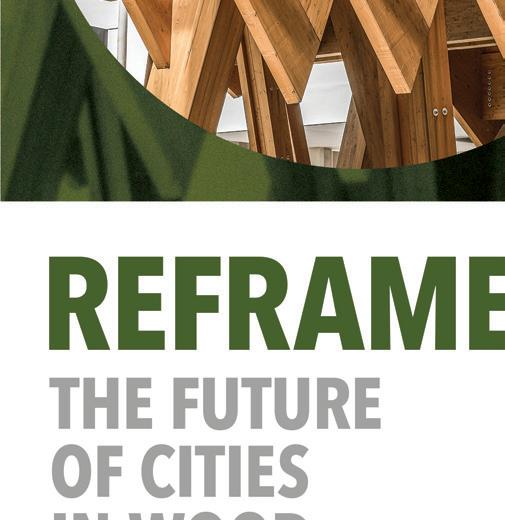


Sign up for classes today at MUSIC CLASSES FOR ADULTS & KIDS

British imports are common enough on Chicago’s stages. The plays of Simon Stephens regularly appear at storefront theaters; Court Theatre will revive Tom Stoppard’s Rosencrantz and Guildenstern Are Dead next season; and Six continues its Broadway reign following its 2019 North American premiere at Chicago Shakespeare Theater. But it’s safe to say that Chicago audiences have never seen a British show quite like London Road , which makes its U.S. debut at Shattered Globe Theatre this month.
After opening to critical acclaim at London’s National Theatre in 2011, London Road was adapted into a 2015 film with an ensemble cast that included Olivia Colman and Tom Hardy. Based on the true story of the 2006 serial murders of five sex workers in Ipswich, England, the musical comprises verbatim interviews that playwright Alecky Blythe conducted with members of the community, set to music by Adam Cork. In other words, it represents a subgenre of a subgenre: the verbatim musical.
The modern genre of documentary theater—which draws from primary source materials, typically in unaltered form—originated about a century ago in the USSR and continen-
tal Europe before migrating to the UK and U.S. The subgenre of verbatim theater specifically employs interviews with the play’s subjects, as in The Laramie Project , a 2000 play by Moisés Kaufman and members of the Tectonic Theater Project about the aftermath of the homophobic hate-crime murder of Matthew Shepard in Wyoming.
In 2019, Chicago audiences saw a memorable example of verbatim theater in the Goodman’s Dana H., a haunting account of the kidnapping of playwright Lucas Hnath’s mother. When the one-woman show later premiered on Broadway, actress Deirdre O’Connell won a Tony Award for her performance, which was entirely lip-synched to the actual interview recordings.
But a verbatim musical? That’s a rare breed. “I’d been familiar with verbatim plays, but never the idea of a verbatim musical,” says Elizabeth Margolius, director of Shattered Globe’s London Road . When she initially watched the film version, “the music itself was just so di erent from anything I’d ever heard before, so that was one of the first things that I found fascinating.”
Music director Andra Velis Simon was
LONDON ROAD
4/22-6/3: Thu-Sat 8 PM, Sun 3 PM; also Wed 4/26 8 PM, Thu 4/27 7:30 PM, no shows Fri 4/28 and 5/19; touch tour and audio description Fri 5/5 (touch tour 6:45 PM); Theater Wit, 1229 W. Belmont, 773-975-8150, sgtheatre.org, previews 4/22-4/26 $25 ($10 students), regular run $52-$45 ($25 under 30)
feel my voice is, and so to have the freedom to stretch it in this way and the freedom to know that if it cracks or if I mess up or if it’s not pretty all the time, that’s how people talk, and that’s how many of these people are talking.”
similarly “mesmerized” by the score. “It’s incredibly complicated and moving and exciting and terrifying all at the same time. And so, I thought, ‘Oh, shoot, now I have to do this.’”
At Shattered Globe, an ensemble of 11 actors plays dozens of characters, including residents of London Road—the site of the murders—and several surviving sex workers. Cast member Tina Muñoz Pandya, who plays neighborhood watch committee member Jan (among others), explains the unique experience of portraying real people in this verbatim format.

“As an actor, you’re often playing a character that’s been crafted to be a certain way or to tell a certain part of the story or to serve a certain function in a story,” Pandya says. “Just to be playing a real human person and speaking literally in their exact voice—it’s such a challenge as an actor, but it’s also really freeing as an actor . . . The humanness is right there.”
Since each cast member plays multiple characters, sometimes they have to switch roles from one line or lyric to the next. The original recordings of the interviews are a constant point of reference as they rehearse. “Even though we don’t have photos of these people, we have their voices, and our actors have been amazing at using that to inform their physical choices,” says Simon.
Another challenge is the music. In Simon’s view, a good piece of musical theater has seamless transitions between spoken text and music, “because the song feels like speech.” London Road represents this in the extreme, she explains. “This is all literally speech that [Cork] then notated as music, but without making any changes to it. Everything that is sung in this musical is something that someone said in that way.”
Verbal tics, repetitions, and “likes” and “ums” are all translated into the score, which features complex patterns and layers that critics have compared to composers ranging from J.S. Bach to Steve Reich. “Every single hesitation is there in an eighth-note rest, and it sounds like they’ve matched almost the exact pitches,” says Margolius. “It’s unreal.”
Previous vocal habits go out the window with this score, Pandya explains. “I’m trying to figure out how to get the cadence and the quality of their voices across via song. I have often been self-conscious about how limited I
The show’s plot centers on the London Road residents who see their quiet street undergo several transformations: first, into a favorite locale for sex workers to pick up clients, and next, into a crime scene and media circus as the murder investigations ramp up. The overall message is one of resilience as the community comes together to heal in the aftermath.
Of course, the residents aren’t the only ones a ected by the serial killer’s crimes. The surviving sex workers are the most at risk, and they stop taking on new clients while the investigation is ongoing. Three of them are featured in the show, but they don’t get their own song until midway through the second act, reflecting their marginalized status in the community.
Additionally, the writers don’t shy away from exploring the complicated views of the London Road residents toward the sex workers, which range from empathetic to shockingly harsh. “I think this piece did a really good job of honoring these women and also being very honest about how the community reacted to them at the same time, which wasn’t very nice a lot of the time,” says Margolius.
While casting the ensemble’s various roles, Margolius and Simon decided to have actors who play the characters that say the worst things about the sex workers double as these women, sometimes in back-to-back scenes. “I think there are rightfully going to be many people who are very uncomfortable with the way these women are talked about,” says Simon. “I know that we all are. So, it’s a way to try to turn that on its head a little bit.”
Ultimately, the show encourages audiences to think about what it means to be part of a community and how one’s actions and language a ect others. “I think it is so appropriate for the moment we are in, globally,” says Pandya. “You see the e ect that a community coming together has, and you see the effect that community care has on a micro level, but you also see what happens when people are left out of that or when people are actively pushed away.
“Community care should apply to everybody, not just the people within your immediate community,” she concludes. “The bounds of community don’t stop at your street.”























SPRINGTEN Fri 4/28 8 PM, Harris Theater, 205 E. Randolph, harristheaterchicago.org or visceraldance.com, $20 -$75
A Harris Theater showcase highlights a decade of progress.
By JT NEWMANEntering Visceral Dance’s new venue, a visitor is struck by its size and the care taken to design a space that suits the company that built it. Tucked away on Rockwell Avenue and nestled up against the North Branch of the Chicago River, the performance space is painted a stark black, with soaring ceilings and hip, classically industrial design touches like frosted-glass garage doors, leather chesterfield sofas and chairs, marble counters, and warmly polished brown cement floors. It looks comfy and elegant.
As you enter the long hallway of studios, you realize that this is not a classic Chicago black box, nor is it an intimidating palace of dance. Every detail was carefully curated to feature artistic space in the industrial building that brings warmth, natural light, and the beauty of the river (through the use of multiple skylights and long walls of glass windows) to this Avondale spot. And it was made to light the human body as it moves through space in dance. It’s a fitting home for Visceral Dance Chicago—which is celebrating ten years this year—and its dance school, now 15 years old. It was an intrepid goal to build out a new space in the middle of the pandemic. But for artistic director Nick Pupillo, dance and community are a higher calling. During an intense period of the pandemic, he reopened his studio and worked the front desk by himself while teaching seven days a week. As he told Reader contributor Irene Hsiao in 2020, “People were pretty hesitant when we reopened in July. . . . I saw everyone come in and everyone leaving, and I saw the di erence, people smiling again, crying because of what it felt like to be part of this again. It revitalized why Visceral exists, why I’ve created it and worked hard for it.”
Visceral Dance celebrates its tenth anniversary with SPRINGTEN at the Harris Theater on April 28. The program will feature Lotus, a world premiere by Pupillo. It will also include
Impetere, Pupillo’s first work for the company, in a return to the Harris stage, where it premiered ten years ago, and Keep (2018), a duet with music by Trent Reznor and Sigur Rós. Rounding out the program are a mainstage premiere of Name It by Israeli choreographer and Ate9 Dance Company artistic director Danielle Agami (with music by Puerto Muerto, Glenn Kotche, Emily Manzo and David Friend, and Elvis Presley) and longtime fan favorite Marguerite Donlon’s Ruff Celts (created for Visceral in 2016 with music by Sam Auinger, De Dannan Luke Kelly, Kíla, Sinead O’Connor, and Claas Willeke). Celts melds the choreographer’s Irish heritage with insights into the dancers’ own relationships with heritage and tribe.
I sat down with Pupillo at the studio and saw rehearsals of sections of Lotus and Keep. As the dancers started to move in the section of Lotus I previewed, I was struck by the natural beauty outside the row of windows overlooking the water, the natural light in the room, as well as Pupillo’s visually interesting original choreography and the rhythmic attention to detail of the dancers as they combined and recombined in solos, duets, and group sections. Slow and lengthy arm extensions in cambre backbends mixed with the complex pretzeling and contrapposto of hips and shoulders, while the dancers simultaneously and effortlessly rolled out of fixed positions. Contrasted with
the more adagio and rhythmic sections, it created interesting and fresh movements.
When asked about the origins of the piece, Pupillo explained, “I didn’t want to do something directly about the pandemic, but I was interested in the idea that the lotus comes out of mud.” “No mud, no lotus” being, of course, an essential tenet of Buddhist belief: something beautiful and intricate can grow in what is essentially muck, and our sorrows can transform into joy through acceptance. Essentially, it says that without pain and su ering, people can find no joy. That feels like a very apt message for a company that, at the height of the pandemic lockdown, built its beautiful new space.
Keep was made expressly for the dancer Braeden Barnes, who is leaving the company after six seasons. It is a connected duet with long extensions, falls and catches, effortless lifts, and a sweet but melancholic feeling. Featuring the interplay of two bodies rolling together, combining, separating, and recombining, it felt deeply wistful and tender. The moments where the dancers embraced each other’s faces gingerly and a floor combination where one dancer rolled their head along the other dancer’s stretched-out body were at once relentlessly original and completely fresh.
It is interesting to revisit the history of Visceral. Pupillo says he started his company with
Ruff Celts is part of Visceral Dance Chicago’s SPRINGTEN program. TODD ROSENBERG

education in mind first. While many dance companies take the reverse approach (building a company for performance and then using dance education classes to financially support the work), Pupillo had a vision of community from the very start. He built the classes in his studio as the foundation of fostering a community for his work and the work of his company.
He envisioned his new space as a top training facility in the country while holding strong to the idea that a dance center can be known for both positivity and excellence. When he talks about his work, Pupillo is quick to mention that he builds it in collaboration with his dancers. And he’s not shy to tell you that he’s interested in audiences knowing his dancers well and being able to pick out their work in the company’s pieces. His company is committed to diversity and being representative and respectful of other viewpoints.
The concept clearly works. In one short decade, Visceral has become a national and global force in contemporary dance. With challenging but accessible choreography, technical prowess and athleticism, and a relentless focus on presenting new artists, Visceral is an important artistic voice that has provided an incredibly vital space for Chicago’s dance community. v
Galileo’s Daughter at Remy Bumppo is smart and poignant.
Jessica Dickey’s world premiere at Remy Bumppo (directed by Marti Lyons) has some echoes of Doug Wright’s I Am My Own Wife: the playwright appears as a character, researching the life of a historical figure as a way to come to grips with her own personal narrative. But unlike the ethically complicated (but still remarkable) Charlotte von Mahlsdorf (an East German trans woman who survived the Nazis and the Stasi) at the center of Wright’s play, Dickey’s historical role model is a star who shines without a hint of tarnish.
Galileo’s Daughter puts Maria Celeste Galilei (played by Emily Bosco with soulful forthrightness) at
the center of the dramatic firmament, where her father (Chiké Johnson) wrestles with his conscience over how to care for his illegitimate offspring while he’s facing his own impending meteoric collision with the church. Placed in a convent for safekeeping, Bosco’s Maria Celeste writes numerous letters to her father and, as Dickey de ly shows, inspired Galileo’s use of a play as a means of arguing heliocentrism vs. geocentrism.
In present time, Linda Gillum’s Writer has come to Florence to research those letters. (Johnson wittily plays various Italian clerks and bureaucrats.) But her own looming divorce adds a touch of personal anguish to her quest. She and Maria Celeste are looking at history through different ends of the telescope over centuries, but their mutual search for truth and connection centers this quietly moving drama about truth and faith. John Boesche’s stellar (pun intended) projections add a sense of grandeur and awe to frame this riveting
story. —KERRY REID GALILEO’S DAUGHTER Through 5/14: Thu-Fri 7:30 PM, Sat 2:30 and 7:30 PM, Sun 2:30 PM; also Thu 5/11 2:30 PM; no show Sat 5/13
2:30 PM; audio description/touch tour Sat 4/22 2:30 PM, open captions Sat 4/29 2:30 PM; Theater Wit, 1229 W. Belmont, remybumppo.org, $32-$40 ($15 industry, $10 students)
Is God Is offers a vivid story of vengeance and trauma.
Aleshea Harris’s What to Send Up When It Goes Down, produced by Congo Square Theatre last year, provided a trenchant and sometimes anguished portrayal of how racialized violence affects Black Americans over generations through a series of vignettes, rituals, songs, and more.
In narrative form, Harris’s Is God Is, now in a local premiere at A Red Orchid Theatre under Marti Gobel’s direction, is more straightforward—but the generational effects of violence are still very much present. Twin sisters Racine (Aja Singletary) and Anaia (Ashli Rene Funches), burned as children when their estranged father broke into their apartment and set their mother on fire, find out years later that their mom is still alive— barely. When they visit her, she commands them to seek vengeance on her behalf. Karen Aldridge’s hypnotic performance as the mother (soon referred to as “God” by the twins) feels like butoh by way of horror film. With carefully calibrated jerking movements and rasping breath, she draws her offspring into her plans for vengeance. “Make your daddy dead, and everything around him you can destroy, too,” she tells them.


And that’s what they do in this disturbing but hypnotic 100-minute play that combines elements of spaghetti westerns, Greek tragedy, and Jacobean revenge dramas. The girls set out to find their father, now living a bougie life in Hollywood with twin sons (Donovan Session and Andrew Muwonge bring Kardashian-like vapid entitlement to their roles, providing some comic relief before the bloodbath). Jyreika Guest’s inspired fight choreography on Red Orchid’s small stage and Daniel Etti-Williams’s jarring and haunting sound design are also standouts. It’s a wild ride, but Harris roots it in painful questions about the legacy of violence in a society whose institutions too o en fail to protect women and children. —KERRY REID IS GOD IS Through 5/28: Thu-Fri 7:30 PM, Sat 3 and 7:30 PM, Sun 3 PM; A Red Orchid Theatre, 1531 N. Wells, 312-943-8722, aredorchidtheatre.org, $30-$40
Last Night and the Night Before examines the limits of love.
Donnetta Lavinia Grays’s play is about the limits of love—both in what it can accomplish, even when it feels infinite, and in what it can tolerate before it disappears.
Monique (the protean Ayanna Bria Bakari) shows up at her sister’s house with her 11-year-old daughter in tow and an undisclosed agenda. (Daughter Sam is played at alternate performances by Kylah Renee Jones, flawless on opening night, and the no doubt equally capable Aliyana Nicole.) In flashbacks, we see the start of Monique’s relationship with Sam’s father Reggie (Steppenwolf ensemble member Namir Smallwood, in a performance of great tenderness and power) as well as Monique’s deterioration from creative ingenue to irresponsible
junkie. When she leaves Sam with her sister Rachel and Rachel’s wife, Nadima (Sydney Charles and Jessica Dean Turner, respectively), another couple comes under acute strain.
Nor is filial love a refuge, as Sam tries to please both parents, be unobtrusive to her aunts, and define herself independently all at once. So many currents and crosscurrents risk leaving the audience at sea, but Valerie Curtis-Newton’s sharp direction creates a through line, so the incidents and relationships are reinforcing rather than muddling. Every character receives a fully rounded and lived-in portrayal, and the motif of childhood handclap chants leavens what otherwise would be too dense an examination of how pain is passed down like a broken double helix.
And the best thing about the experience wasn’t even on the stage but in the audience, which was the most racially inclusive and age-diverse I’ve experienced in Chicago, demonstrating the power of well-chosen art to bring us together. —KELLY KLEIMAN LAST NIGHT AND THE NIGHT BEFORE Through 5/14: Tue-Fri 8 PM, Sat 3 and 8 PM, Sun 3 PM; Wed 5/3, 2:30 PM only; no performance Sat 5/13; open captions Thu 4/27 8 PM and Sat 5/6 3 PM; audio description and touch tour Sun 5/7 (touch tour 1:30 PM); ASL interpretation Fri 5/12 8 PM; mask-required performances Wed 4/19 8 PM and Wed 5/3 2:30 PM; Steppenwolf Theatre, 1650 N. Halsted, 312-3351650, steppenwolf.org, $20-$88
An ensemble of Black performers keeps Saturday night lively at iO.
The phrase “white spaces” evokes quite a few strong images. Kohl’s. The LDS Church. Late-night talk show desks. Bar Harbor, Maine. And, for too many comics, improv clubs. It’s no secret that the sketch, stand-up, and improv worlds have long been incubators for exclusion and toxicity as much as laughter, and clubs have—to varying levels of sincerity—been working to answer calls for accountability. So it would be reasonable to feel some anxiety on behalf of the cast of Satirical Race Theory, a new all-Black troupe whose primetime Saturday night run at iO must come with some degree of rep sweats or undue pressure.
If the confident performance by the opening night cast of Andrew Baldwin, TJ King, Kim Whitfield, Cyntisha Coats, Coco Fernandez, and Elim Almedom is to be any indication, though, audiences should feel those concerns assuaged. It’s an all-around strong showing from an ensemble that very much has the goods and functions as a creative unit more seasoned and matured than its recent formation would suggest. They even function well in the most harrowing and uncanny of comedic assignments: the local news affiliate daytime lifestyle show promo hit.
Of course, the mettle of a troupe isn’t tested when the bits are flyin’ free and easy but rather when they aren’t, and even when they’re navigating the premise-woods, Satirical Race Theory’s ensemble keeps its momentum apace. Charming and affable, Baldwin excels when he steps in as host, and at opening, Whitfield and King had particularly memorable sets. Even the opening hype act by dance ensemble The Puzzle League feels like a fresh take. —DAN JAKES SATIRICAL RACE THEORY Through 7/1: Sat 8 PM; iO Theater, 1501 N. Kingsbury, ioimprov.com, $30 ($40 VIP/$15 student) v
BLESSINGS OF CINEMA: APICHATPONG WEERASETHAKUL 4/24 -4/28, Block Cinema and Gene Siskel Film Center blockmuseum.northwestern.edu/cinema siskelfilmcenter.org/apichatpong-weerasethakul
1999.) In 2017 the internationally acclaimed exhibition “Apichatpong Weerasethakul: The Serenity of Madness” was on display at SAIC’s Sullivan Galleries; he visited then, too, in conjunction with that transcendent multimedia experience.
SCREENINGS

The SAIC alum appears in person at several upcoming screenings.
By KAT SACHSOrchids are beautiful but require great patience; once germinated, the flower can take several years to bloom. But though they may seem fussy, it is actually quite easy, I’ve read, to tend to them as long as you exercise that most significant (and trying) of virtues. I have never had the inclination myself, but there are certainly other ways I apply what little patience I do have.
One of those is with cinema—specifically with films that challenge my ability to focus on something I don’t understand for an extended period of time. Mainstream movies nowadays have almost too much plot; one can’t see the new superhero movie without first seeing all its predecessors, other films in the multiverse, and even a television series or two, to understand a never-ending story that’s continuously blooming, thereby compromising the potential of its full e ect. To such films understanding is integral. When one purchases a ticket, it becomes an investment of more than just time; it becomes a commitment to the labyrin-
thine narrative set forth, with even one lapse a threat to spoil it all.
But the films of preeminent Thai director Apichatpong Weerasethakul eschew the necessity of understanding. They require not just a suspension of disbelief but a near-total abandonment of preconceptions. This isn’t done aggressively or, as may sometimes be the case, pretentiously—rather, Weerasethakul does so languidly. Like orchids, his films require immense patience, and the reward is appreciation, the wonderful awareness of being in the moment with no pressing desire to fathom.
Weerasethakul—sometimes called “Joe,” a nickname he adopted—was born in Bangkok. After completing undergrad in Thailand, he came to Chicago to study at the School of the Art Institute of Chicago, where he received a master of fine arts in filmmaking in 1997. It’s long been a source of pride for Chicago cinephiles to claim such a singular, rarefied talent as one of our own, owing to his brief tenure here. (He returned to Thailand in
Between Monday, April 24, and Friday, April 28, Weerasethakul will again appear in person, this time at several screenings of his films (most on 35-millimeter) between Block Cinema at Northwestern University and the Gene Siskel Film Center. On Monday at Block is Tropical Malady (2004), the first Thai film ever to screen in competition at the Cannes Film Festival, where it also became the first such film to win a major prize. Both this and Syndromes and a Century (2006), which closes the week of screenings on Friday, April 28, have two-part structures wherein the second part is something di erent than the first.
Influenced by his Buddhism, this structure represents a sort of filmic reincarnation. The first half of Tropical Malady follows a soldier and a villager as they embark on a sweet, tentative romance (queerness is prevalent in Weerasethakul’s work, as he himself is a queer man). In the second half, the same soldier pursues a tiger shaman, potentially the village lover transformed. Such bilaterality represents the relationship between the natural and mythical worlds, which are simultaneously discrete and interwoven, especially in the fabric of Weerasethakul’s imagination.
Five short films made between 2005 and 2018 screen in “Blessings of Cinema: Short Films with Apichatpong Weerasethakul” on Tuesday, April 25, at the Block. The connecting theme is that each short is somehow metacinematic in nature. For example, in Thailand, the royal anthem is played before all film screenings. In The Anthem (2006), Weerasethakul creates his own homage to the communal experience; three women chat happily on a porch along the water’s edge, discussing a new album that one of them likes and says she’ll play at the theater where she works. In another instance of diremption, it then cuts suddenly to some sort of shoot, where people are engaging in various recreational activities. To what end I’m not sure, but the relationship between the tranquil conversation and the joyful exuberance of the production puts one in a mindset ready for just about any kind of movie.
A companion piece to Weerasethakul’s
acclaimed 2010 film Uncle Boonmee Who Can Recall His Past Lives, another of the shorts—A Letter to Uncle Boonmee (2009)—is part of his larger Primitive project, wherein he explores Nabua, a border town on the divide between Thailand and Laos, with a history of migration and related violence. It was once also a red zone occupied by Thai soldiers in an attempt to thwart communist insurgents. Composed of shots of abandoned houses with only a group of Nabua teenagers playing soldiers to comprise a cast, it’s as much a feeling as it is a film. It’s not only metacinematic in its connection to the feature film, but it also prefigures Memoria (2021) with the Spaceship of Nabua, an installation visible in some exterior shots. Other shorts in the program include Mobile Men (2008), Worldly Desires (2005), and Blue (2018).
At the Film Center, as part of the Conversations at the Edge series, his most recent feature, the aforementioned Memoria, screens on Thursday, April 27. It’s a staggering work, perhaps the apotheosis (at least currently) of Weerasethakul’s tremendous vision. His first film in English and the first set outside Thailand, it centers on Tilda Swinton as Jessica, a Scottish woman based in Colombia. She’s awoken by a loud noise in the night, the lure of which compels her to pursue its mysterious source. Weerasethakul’s own experiences with exploding head syndrome—which involves the sufferer hearing an inexplicable loud noise (most often during the transition between sleep and wake)—inform the film’s uncanniness.
Swinton’s character is an orchid farmer; another semi-autobiographical detail is that Weerasethakul’s mother had an orchid garden. Orchids also factor into Syndromes and a Century, the latter of the two bifurcated narrative features, here centered on the happenings of two hospitals across several generations. Weerasethakul’s parents were physicians, and as such, the film is loosely based on their experiences. In the first part, a young army doctor both pursues and is pursued by potential suitors (one of whom cultivates orchids). It’s set in a rural hospital, whereas the second half takes place in a more urban location, the events of the former happening again in this parallel narrative. The duality of rural and urban spaces is another of Weerasethakul’s abiding concentrations; much like an orchid, he seems to suggest that with patience, it’s possible to bloom anywhere. v
June 1, 2023 · 7 PM METRO/sMARTBAR

Best of Chicago Celebration is back! On June 1 at Metro Chicago, the Chicago Reader is thrilled to host its iconic event of celebrating the Best of Chicago–nominated and voted by YOU.

Learn more below or scan the QR code >>> chicagoreader.com/bocparty

Sponsors

Get showtimes and see reviews of everything playing this week at chicagoreader.com/movies
Cage, who’s vamping it up with his singular brand of unhinged glee. Renfield leans right into the campy, homoerotic side of things; instead of leaving the hapless lunatic gibbering in an asylum, this Dracula took Renfield into high society and even gave him a taste of his power and strength as his familiar.
True, there are drawbacks like any addiction, in that it harms both Renfield and the people around him, and forces him into a relationship that’s as toxic as it is codependent. It’s also wickedly funny, with Cage absolutely selling the gaslighting nature of Dracula’s insistence that Renfield is the true monster, and that the one who openly craves innocent blood and world domination is the true victim.
The life and work of Swedish abstract art pioneer Hilma af Klint (1862-1944) is tailor-made for a biopic. Mostly ignored in her lifetime, af Klint has been rediscovered and celebrated to such a fever pitch that a recent retrospective at the Guggenheim in New York was the best-attended exhibition in that museum’s history. Her work looks fresh and contemporary today, but they did not have much of a chance in the first decades of the 20th century, when, guided by spiritual visions and an unusual hunger for knowledge of the inner workings of the natural world, she produced some of the first nonobjective paintings in Europe. Without institutional or familial support, af Klint retreated into obscurity just as male peers like Kandinsky and Malevich claimed credit for freeing the art form from the limits of seen reality.
Unfortunately, what Lasse Hallström has made is a schmaltzy, sentimental ode to his wife, Lena Olin, and daughter, Tora Hallström, who play the titular role at different ages. The film spends too much time speculating on af Klint’s sexuality and too little on the art that has justifiably, if belatedly, made her an icon. In a Q&A a er a recent screening, Olin admitted that they only learned about the painter a couple years before making this film. It shows. Watch the excellent 2019 documentary Beyond the Visible: Hilma af Klint, or better yet, just look at the paintings. There’s a lot more there than you’ll see in this Hallmark version of a misunderstood artist’s life. —DMITRY SAMAROV 120 min. Limited release in theaters
Mafia Mamma has the makings of a cult classic. On paper, that is. Toni Collette plays the mild-mannered Kristin, an Italian American mother whose husband cheats on her immediately a er her son leaves for college. Not to mention, her misogynistic bosses barely acknowledge her existence. This timeless story sets up
the justification for a drastic midlife crisis so that Kristin can eat, pray, and love. And that’s when she receives a call to attend her estranged grandfather’s funeral . . . in Italy.
Kristin escapes her mundane life and arrives in Rome where she is welcomed by Bianca, her family’s most trusted advisor, played by Monica Bellucci. When her grandfather’s funeral suddenly turns into an absurd shoot-out, Kristin learns that her grandfather was not a winemaker, but the head of the Balbano crime family. And his dying wish was that Kristin takes over as the Don. Or Donna
Despite this enticing premise, it’s doubtful that Catherine Hardwicke’s ludicrous and gory comedy will be remembered. Mafia Mamma’s only true achievement is its shock factor. Kristin’s transformation from “Suburban Mom to Mafia Don” is packaged with several laughs and twists in this frantically paced movie. It moves tactlessly from scene to scene, adorned with outrageous shoot-outs and lousy jokes, producing a feverish cinematic experience.
Renfield had already begun desiring something different for himself by the time he meets and saves the life of idealistic straitlaced cop Rebecca (Awkwafina). Unfortunately, their paths crossing means the Lobo crime family she’s obsessively pursuing, headed by matriarch Bellafrancesca (Shohreh Aghdashloo) and son Tedward (a standout Ben Schwartz), also come into contact with Dracula, and it’s a true meeting of the monsters.
Action-hungry audiences can count on getting their fix long before the final showdown, with limbs flying in a fashion that owes much to Sam Raimi, along with plenty of salutes to Dracula’s onscreen history, which have been seamlessly digitally altered to include Hoult and Cage in a contribution that will likely stand the test of time even as it embodies our current moment. Let the laughs and the darkly comedic bloodshed flow, because there’s no shortage of either in Renfield —ANDREA THOMPSON R, 93 min. Wide release in theaters
to make these guys more real, because that was never the point. The more human the brothers and their Princess Peach are made to be, the more dull. Let ’em fight! Let ’em fly! When the movie focuses on this, it’s fun—a movie that only focuses on this, closer to YouTube-able speedruns than paint-by-numbers IP origin story chum, would be better.
The lone exception to its failures at cramming in charisma? Jack Black as Bowser; he gets to sing lovesick incel ballads, mewling about how Peach doesn’t love him enough, angry that the tiny courageous Italian has her heart instead. Black remains a performer who, no matter the stakes, brings the full experience. Bless him for doing that when no one else could. —JOHN WILMES PG, 92 min. Wide release in theaters
“Who among us is the most dead?” a Black zombie asks a young white soldier who has wandered out of his own time. The answer, in Carlos Conceição’s not-really-war-film Tommy Guns, seems to be that colonialism inters colonizer and colonized in the same cycle of murder and death, staggering around in moldering circles together.
It’s hard to describe the plot of Tommy Guns, in part because avoiding spoilers is tricky, and in part because there just isn’t that much narrative. But most of the film is set in an indeterminate time in an indeterminate country that may be Angola under Portuguese rule. Coronel (Gustavo Sumpta) spends his days training a troop of soldiers, including our sort-of protagonist, Zé (João Arrais). The soldiers have been in the same barracks, surrounded by a huge wall, for a long time—long enough that they don’t remember their mothers’ names.
—MAXWELLRABB R, 101 min. Wide release
Mafia Mamma’s frenetic momentum is not necessarily a drawback. In fact, it’s Hardwicke’s greatest achievement and what makes the movie the most engaging. That said, the film is cyclical, relentlessly playing on the same jokes and Godfather gags. Mafia Mamma mostly fumbles the absurdity that could make the film rewatchable, emerging as a hollow comedy instead of a self-aware and possibly beloved romp. But if you find yourself wanting to watch this movie, make sure it’s with friends.
in theatersGet ready, because there’s yet another new take on Dracula. But no need to brace yourself, because Renfield feels surprisingly fresh.
Nicholas Hoult (The Menu) is the tortured title character and loyal servant to the Count, played by Nicolas
It’s a sacred text, but not one with any depth. The saga of Super Mario, told through dozens of video games over roughly four decades, should not be plumbed—yes, that’s right, plumbed—for richness that does not exist. In its surface-only fairy tale is a perfect simplicity, regularly used as framework for interactive platforming adventures that are, since they’ve existed, some of the most broadly shared experiences of joy on earth.
As a movie, the whole Mario thing will probably never work, but it would be interesting to see a version that makes no effort to explain what everyone already knows—that he’s a fast little dude in an inexplicable psychedelic hollow earth called The Mushroom Kingdom, jumping his way to Jesus status as he topples monsters and restores innocence. Among the many errors of The Super Mario Bros. Movie, screenwriter Matthew Fogel (formerly of Minions: The Rise of Gru and The Lego Movie: 2 repute) plops him and his brother Luigi into a milquetoast Brooklyn family that doubts them and disrespects their small-business dreams.

Who cares? Boring stuff. Get to the action. Don’t try
The movie rambles here and there, introducing characters—and for that matter, genres (a Romeo and Juliet riff, for example)—only to abandon them. But it’s structured by a series of rhyming scenes in which sex, desire, and/or recognition are shattered by violence and death. Colonialism here is less a history than a dreamed primal scene, in which intimate brutality is enacted and reenacted by imperial cat’s-paws who barely know who they are, much less what they’re doing or why.
Tommy Guns doesn’t entirely escape the Western colonial war film’s characteristic obsession with the heart of the colonizer at the expense of the material conditions of the colonized. But it manages to make war look not just ugly and pointless, but embarrassing, dull, and humiliating in a way that, say, Full Metal Jacket—which it at times seems to consciously parody—does not. Conceição has created a smart, strange film that is disjointed because colonialism is a thing of disjointed desires, histories, and deaths. —NOAH
BERLATSKY118 min. Limited release in theaters v































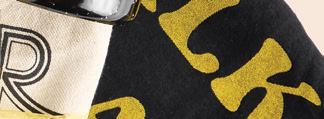

that, I want to know how he got to be so down with the cause. How did he pick that slogan?
“I am living it, we are living it,” he says, “as people, as a family, as artists, as Brown people living in Brighton Park. Nothing is fancy. We are living a simple life and trying to just make it every day. I went to the food pantry yesterday so we could save some money, so we could try to do what we love. We also feel the inequality, the fact that we’re basically lower-income Brown people.”
Ledezma is a musician and producer, and he’s part of a tropicalia-influenced Latine psych-rock band called Allá with his wife, Lupe Martinez, and his older brother, Angel. He and Lupe also have a six-year-old daughter named Oona. “We’re a family and trying to do all these things as a family, and you realize all the things that are stopping you from just trying to make art and connecting with your community and having a family that has dinners together and weekends. I know so many Brown kids that didn’t have that. Lupe and I didn’t have that. My brother Angel and I didn’t have that, because my father worked all night. So we value that stu .”
By SANDRA TREVIÑOMusicians such as Woody Guthrie, Victor Jara, and Chuy Negrete have championed the working class in their struggle for dignity, justice, and fair pay by telling their stories in song. In Chicago, Brandon Johnson’s victory in the mayoral election demonstrated the power of the working class (and of young people), and he’s named his transition committee “Chicago for the People.” In the world of indie music, “working class” is sometimes
just a costume worn by kids with rich parents or trust funds, but on May 1—also known as May Day or International Workers’ Day—the Empty Bottle hosts a celebration for the working class with music from the working class. That celebration is a showcase of artists on Brighton Park-based label No Sé Discos.
My interview with label cofounder Jorge Ledezma is supposed to dig into the history of No Sé Discos and what he calls its “cosmic sounds from the working class.” But before we do
Of course, our society doesn’t value those things—at least not for working-class people. “They don’t say it, but there are policies and other things in place that you’re like, ‘This job doesn’t pay much, so I have to work more, but that means less time with my kids,’ and it just becomes this cycle,” Jorge says. “I feel that. We’re not immune to it. So that’s why I’m down with the cause.”
Jorge, Angel, and Lupe launched No Sé Discos in 2021, having arrived at the idea of starting a label the year before. But that idea had been incubating for years—at least since 2017, when Jorge got to talking music with his friend Chebaka, an up-and-coming Mexican hip-hop artist from Waukegan who worked with him at Whole Foods. They confided in each other about feeling like outsiders with their out-of-the-box music and art concepts.
Allá’s music, Jorge explains, isn’t necessarily Latine, and its strong experimental bent further confuses listeners who expect something specific from Brown artists. “It’s not Latin rock; it’s not alternative Latin music. It’s a kaleidoscope of all kinds of music, some in Spanish,” he says. “We felt like the weirdo Brown people.”
Chebaka suggested collaborating with Allá. “This is all happening while we’re at work,” Jorge says. “This is where the working-class part happens. We’re not emailing each other about it—we’re working.” He started sending Chebaka unreleased Allá music to play around with. “Even though we don’t do hip-hop, we’ve always wanted to,” he says. “Plus we have so much music, a library of stu —so I sent him some tracks, a little bit of everything. I was shocked at what he did with it.”
Chebaka used his phone to rap absurd, philosophical verses over those Allá tracks. Ever since the sessions for the band’s 2008 album, Es Tiempo , Allá had been recording mostly
Allá, Chebaka, and London pop maestro Nayfo. It included two tracks that also appear on Hard Working Mexican
But before Jorge, Angel, and Lupe could start the label together, they needed to make some big changes in their lives. For one thing, Jorge couldn’t keep working nights at Whole Foods while Lupe worked mornings in retail. The situation reached a breaking point in late 2020.
“Basically, during the pandemic, we were there, all working,” Jorge says. “It just became a quality-of-life thing. It was a good-paying job and all that stuff, so we had to do soulsearching. We had not made music in a long time, so it was tough.”
At that point, Jorge had held down one job or another at Whole Foods for 27 years, but he wanted to be there for his family and also have time for music. “I remember thinking, ‘This is my last holiday at this company.’ It became impossible, and it felt like we were living in a weird lockdown of retail nonsense,” he says. “I snapped and thought, I can’t do this.”
at home, but Jorge knew Matt DeWine at Pieholden Suite Sound through Angel, and he helped Chebaka book studio time. With Jorge on electronics and Angel on drums (among other musicians), they recorded on and off throughout 2018 and 2019, piecing together Chebaka’s album Hard Working Mexican. It’s finally coming out May 1, and it’s one of three releases No Sé Discos is celebrating at the Bottle.
“It was awesome being back in the studio,” Jorge says. “Chebaka was so prepared. He embodies what we’re into—respecting the process and enjoying the process of writing music. He’s the past, present, and future. He’s willing to experiment and work hard.”
After Chebaka finished his album in 2019, he and Allá discussed their options for releasing it. The band had withdrawn from performing and studio work, and because their network in the music community was all but gone, they decided that a DIY approach would be the best way to maintain the control they
wanted. “That’s when the concept began about creating a label so we could put music out ourselves,” Jorge says.
The pandemic ended up delaying Hard Working Mexican , and then other projects inter vened. In early 2021, the National Museum of Mexican Art invited Chebaka to do a presentation as part of its streaming series. He asked Allá for help, and they came up with the idea of using his older recordings to create a video album. Titled Everything Will Be Streamed, it ended up nearly an hour long, and it debuted on the museum’s YouTube channel on February 13, 2021.
“It’s DIY, shot all over Pilsen, Little Village, Brighton Park, my backyard, my house and basement, the laundromat, even Discount Mall,” Jorge says. “We really wanted to give it flavor.”
The first formal No Sé Discos release ended up being an October 2021 compilation called You Are Essential, which featured musicians who were working risky jobs during COVID:
With support from Angel and Lupe, Jorge quit Whole Foods and used what would’ve been his retirement funds to buy a two-flat that would serve as the family’s home, studio, and rehearsal space. They call their enclave Allálandia. Lupe committed to keeping the job she had, and Angel agreed to help them a ord the building by renting the basement. Everyone knew they were taking a risk, but they also wanted to get their music—and the music of other working-class musicians—out into the world.
That transition also made No Sé Discos a reality. “It’s been a huge adjustment but also made us stronger, for us and for other people,” says Jorge. “I regret not leaving sooner. You don’t just do it for yourself—you do it for your family.”
Jorge didn’t stop working, of course—he got a new job as a support sta er at Brighton Park Elementary. Because his hours are similar to the hours Oona spends in school, he gets to see a lot more of her—the four of them can even have family dinners. “Next thing you know,” he says, “I’m doing after-school art and music programs, supervising all recess and fun activities, and even doing some student outreach. It’s fun!”
Jorge and Angel Ledezma were both born in Chicago in the late 70s and grew up in Rogers Park. Their first exposure to music was through their father’s love of the Beatles, especially Sgt. Pepper’s Lonely Hearts Club

Band . “Early on, the Beatles knocked us on our asses, and we were hooked,” says Jorge. “My brother and I would stare at the cover for hours. That shit blew us up. We wanted to hear more music like that. And we were really young, maybe five or six.
“My brother and I made little tape loops where we would sample stu o TV and movies and then create a collage,” Jorge continues. “We figured out how to do it with a microphone so we could make these little cassettes of all these weird TV shows that we would cut up, and we would laugh and laugh. Then we’d play it backwards and laugh some more.”
This would lead them to create imaginary bands and later join real bands. In high school, Jorge played drums in an avant-garde trio called Jazz Discharge. In 1999, Angel drummed for established punk group the Vindictives. For much of the 90s, Jorge played in spacerock band Defender, and both brothers were involved with that group when they started Allá in 2001.
The brothers were working on music for Allá when they first met Lupe Martinez at an open mike at Subterranean in 2004. (At the time, and for a few years afterward, she was in the band Almost Rosario.) Her golden voice seemed like a match for their compositions, and soon she made Allá a trio of young Mexican Americans.

Allá’s debut album, Es Tiempo , came out on Belgian label Crammed Discs in 2008, and they spent more than just seven years of their lives on it—it eventually cost a total of around $40,000 to produce. It features nearly two dozen guest musicians, and its intelligently crafted songs combine electronica, jazz, Kraut rock, pop, funk, and other sounds. To help pay for the album, Jorge got a promotion to manager at Whole Foods, gave up his apartment, and moved in with his parents in Wheeling.
Allá didn’t have the time or the money to make another Es Tiempo , but they released the covers collection Digs in 2009 (also via Crammed) and a homemade electronic album called Feed the Dragon Volume One in 2013. That period was a prolific one for Allá, but most of the material they recorded (including the other two volumes of Feed the Dragon ) never came out. Their attempts to break into the music business petered out after they lost their publicist in 2016. No Sé Discos has issued some of the band’s work from that time, and the label has plans for further such releases. But You Are Essential remains the clearest
expression of its mission statement.
“It’s something we are proud of,” Jorge says. “Being working-class people—Nayfo is a teacher in the UK, Chebaka and I worked retail—we dedicated the project to essential workers. There’s a whole manifesto in it too, written with all of us. We handmade the covers at home. We worked with as many people as we could who we felt were on our side.”
No Sé Discos hasn’t sought out artists. Either artists approached the label or they met organically. “The artists we enjoy working with, they have to be working-class people,” Jorge says. “Meaning they have to earn everything they do. They have to really want to actively learn how to do every part of it, you know, not just make the music.”
The label values artists who like collaborating and enjoy every part of writing, recording, and releasing music. “Those are the people we want to work with,” Jorge says. “We need less talking and more making.”
No Sé Discos’ current roster consists of Allá, Chebaka, and Nayfo, of course, as well
as four acts that aren’t on You Are Essential Bilingual producer and rapper Sorcerer, who recently moved to Chicago from Venezuela, leads Kaczynski Composite Sketch, and he’ll release the album Deviled Ham on Rye via No Sé Discos on May 21. Electronic artist 2 Butch, who came to Chicago from East Los Angeles, dropped a collection of ten tiny tracks called Wrestling With Pigs (made with a micro keyboard and an old laptop) in March 2023. Santrio is a Latine artist from Little Village who began releasing R&B-flavored dream pop as Mán Cub in 2018, and he’ll make his album debut with No Sé Discos later in 2023. Firstwave Chicago postpunk group Stations, now based in Tennessee, issued a long-lost single last year that they’d recorded in 1982 with the legendary Martin Hannett, and they have plans for a bigger release called Ghostland . The label will announce at least one more signing later this year.
Allá had previously worked with Nayfo, and they met Santrio playing shows. Jorge got to know David Stowell of Stations when Stowell
tended bar at Whole Foods. Kaczynski Composite Sketch and 2 Butch—the other two artists celebrating releases at the Empty Bottle showcase—heard about No Sé Discos online. They’re both making their live debuts.
Allá and No Sé Discos have created a tiny but self-sufficient subculture, a rich cultura alternativa. “Our biggest influence is Asco, young Chicano artists in the early 70s from Los Angeles,” says Jorge. “They felt they would never be accepted by the art world, and they created their own public art shows and art spaces.”
Being Chicano, of course, involves constantly negotiating between Mexican and U.S. identities. “Chicano means looking at things, letting go of some traditions, bringing in new ones, and holding on to the ones that make sense for you,” Jorge says. “We are Chicano futurists. Chicano, for me, means creating your own culture with the two worlds you’re living in.”

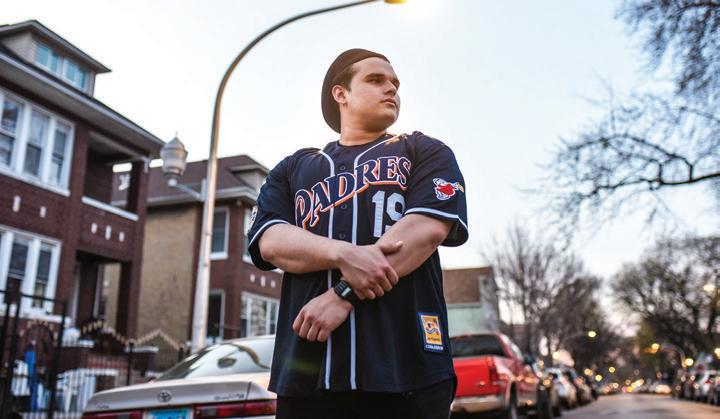



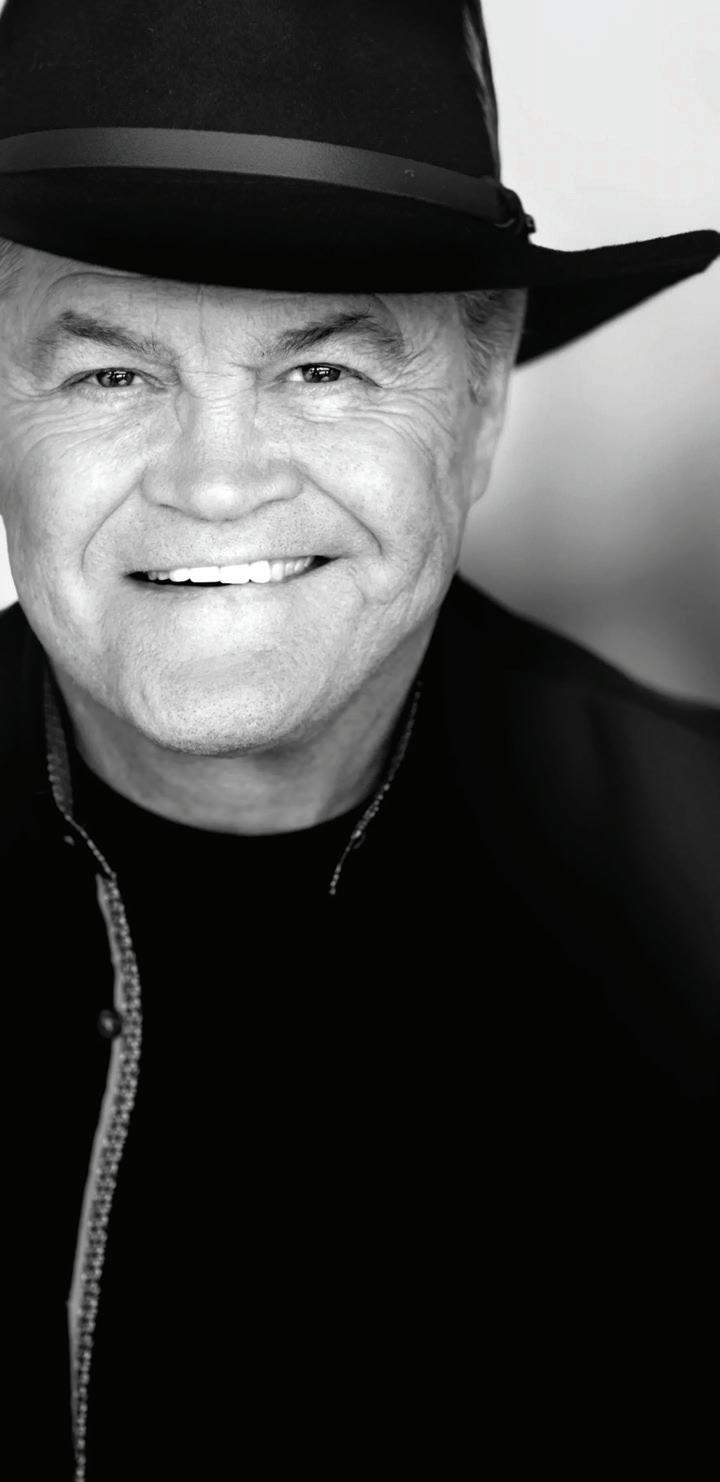
Le to right: FRSH Williams, John Jones of Huey Gang (smoking), TRUTH of Mother Nature (seated), Mani Jurdan of Huey Gang, Jrny Gz, $imba P (seated on fl oor), DJ Cymba (seated), Love Day of 3V Agency (denim jacket), Klevah Knox of Mother Nature (blue Vans), Gr8Sky (both arms raised), Cat (bucket hat), Heavy Crownz (overalls), Jimmy Park of Classick Studios (standing in sunglasses), Jeff K%nz (seated in sunglasses), Tea Murda of 3V Agency THOUGHTPOET
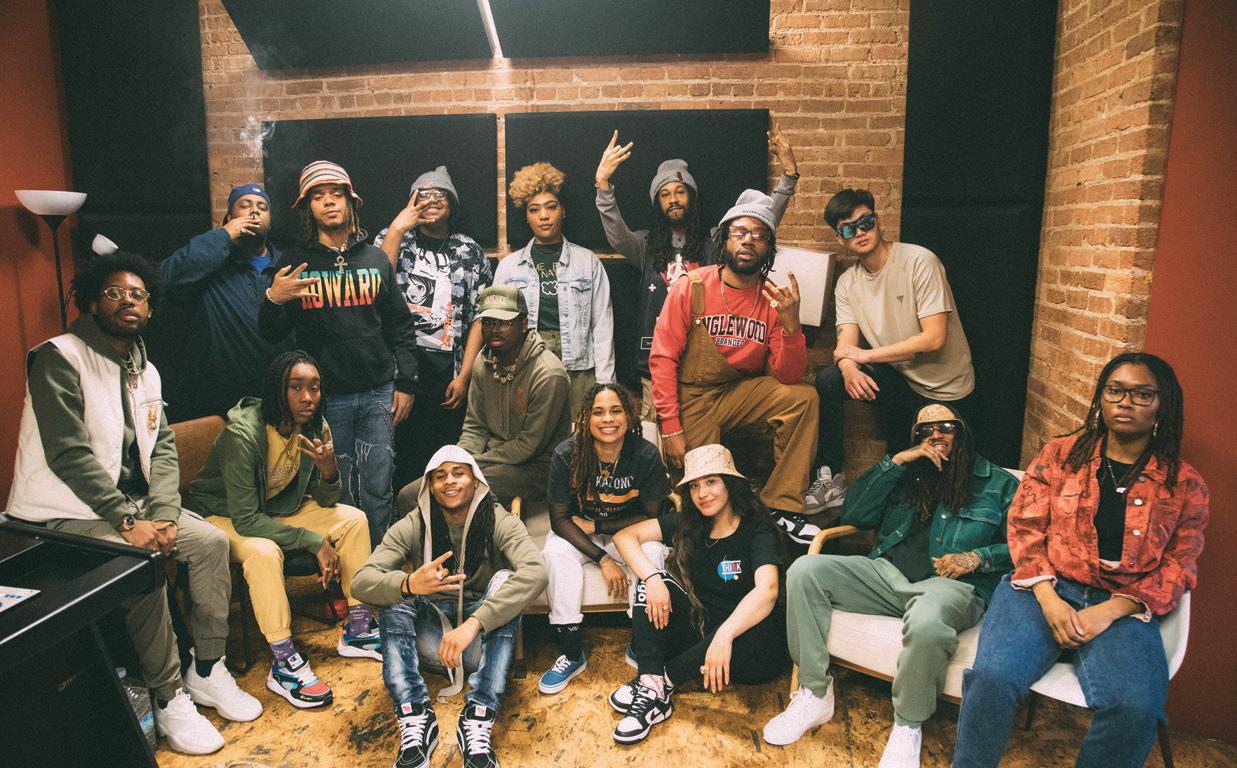
This Chicago hip-hop collective—whose members include Gr8Sky, Heavy Crownz, and Mother Nature—apply their divine principles across all aspects of life.
By ALEJANDRO HERNANDEZIt was a cloudy March day when I walked into Classick Studios to conduct my next interview for this series on Chicago artists impacting their communities. I was greeted by one of the purest forms of hip-hop: a bevy of rappers freestyling together, rhyming to the classic instrumentals of Mike Jones’s “Still Tippin’” and the Wu-Tang Clan’s “C.R.E.A.M.” For a moment I just sat back and soaked in the unadulterated joy of watching them trade intricate bars and perfectly pearled blunts. This type of camaraderie and community is the true beauty of hip-hop, and the rappers living
it out that day were Chicago collective the Gr8 Thinkaz.
The Gr8 Thinkaz can be described as a local supergroup that includes more than ten members, including blossoming stars Mother Nature and Heavy Crownz, plus a litany of a liates both within music making and outside it. The group was born in Champaign-Urbana in 2009, then spread to Chicago and even Houston. Together they embody the five elements of hip-hop culture: rapping, beat making, breaking, gra ti, and knowledge.
“The Gr8 Thinkaz was formed by our dear
producer Rokmore,” says rapper Jeff K%nz. “He created the name, and from there he spread it and created a group out of it. Jay Moses is also one of the founders and CEOs of the group, and found MCs like himself. And it basically exploded into what it is now.”
The name “Gr8 Thinkaz” has a multitude of meanings.
“To be a Gr8 Thinka, you push yourself past your limits until you become limitless,” says rapper and graphic designer Gr8Sky. “You start to become a believer of yourself. Ain’t no obstacle you can’t push past, you just feel
yourself elevate and then you continue to play o of the elevation. Taking notes from those that were great before us and bouncing off that, continuing that lineage. . . . Our mantra is, ‘God is in everything, so therefore everything is gr8.’”
The number eight itself also has spiritual meaning. It’s often associated with infinity due to its similarity to the infinity symbol. In Supreme Mathematics, a system of numerological principles developed by the FivePercent Nation, it represents both building and destruction—in order to build something
great, first you must destroy what’s blocking the realization of that potential, whether it be a negative mindset or an oppressive structure.
The Gr8 Thinkaz do more than just make music together. Many of the members have their own brands in the fields of holistic health and wellness, such as the FreshAssMonk healing- crystal jewelry that Klevah Knox of Mother Nature sells and Gr8Sky’s organic Gr8Juice. Mother Nature also run a nonprofit through which they offer the Miseducation of HipHop, a musicbased curriculum that uses hip-hop culture to foster scholarship, self- acceptance, and entrepreneurship.
As a collective, the Gr8 Thinkaz host a community- based event they call the Gr8 Cypher every few months, inviting people to come and participate in the five elements. Cyphers happen at different venues around Chicago—and even elsewhere in the country, whenever members of the group tour—and they provide an opportunity as well as an audience for artists looking to hone their craft, whether it be rapping, dancing, or visual art.
“The Gr8 Cypher is a space in which people can exchange ideas, let go [of trauma], and pick up gems,” says Klevah Knox. “It’s brought out a lot of homies, a lot of people we never knew. Shorties come through, get connected, and it’s just an exchange of knowledge. I think that each person takes what they can from that, but with our culture being ‘Everything is gr8,’ I believe that work in the community really helps to elevate the minds of our entire community.”

The music of the Gr8 Thinkaz often draws











comparisons to the Wu-Tang Clan, because they’re also a large group that incorporates higher knowledge into their lyrics. While the Gr8 Thinkaz definitely credit Wu-Tang’s influence as students of the game, they’ve formed their own distinctive sound and identity that can’t be put into a box.













In February the collective released the collaborative album Thinkaz Only: Vol. 2, where they flex their versatility from top to bottom. The opening track, “Texturez,” starts with a classic soul sample as Gr8Sky, Mother Nature, Jay Moses, and Jeff K%nz gracefully and intentionally articulate every heartfelt syllable to help it hit home. The vibe of the next track, “Risk Takerz,” is much more in-your-face and up-tempo, with members trading bars and spitting a thousand words per minute over a trap-style beat.
“This whole thing is divine,” says Heavy Crownz, one of the newer members of the squad. “With any other crew, people will say, ‘Q-Tip is the main one because he raps and produces.’ In this thing of ours, everyone is really amazing in their own way, hands down. It’s a unique sound, but there’s an energetic cohesion. . . . It’s definitely gonna be a Thinkaz Szn—apologies—a Thinkaz Decade. There’s about to be a lot blooming fasho.” v


This idiosyncratic, sophisticated trio ought to be better remembered—and they might finally give their own legacy a boost by compiling their demos and live recordings.
By STEVE KRAKOWSince 2004 Plastic Crimewave (aka Steve Krakow) has used the Secret History of Chicago Music to shine a light on worthy artists with Chicago ties who’ve been forgotten, underrated, or never noticed in the first place.
The early history of Chicago punk is a tough nut to crack. Because the scene here isn’t seen as groundbreaking or cohesive, it hasn’t been nearly as thoroughly researched or documented as the scene in New York City. The 2007 documentary You Weren’t There , directed by Joe Losurdo and Christina Tillman, tried to pick up the slack by shedding light on the likes of the Mentally Ill, Tutu & the Pirates, and Skafish. Those local acts still aren’t celebrated as progenitors of punk, though—and the issue isn’t just that they aren’t from New York. Contemporaneous west-coast bands such as the Germs, Black Flag, and X get more props.

Chicago trio Poison Squirrel have their
roots in the city’s nascent late-70s scene, and they’re even more obscure than the groups at the center of You Weren’t There. In an attempt to rectify that, the Secret History of Chicago Music spoke to Poison Squirrel guitarist King Cormack.
“I was raised in the Chicago suburbs and went to Oak Park and River Forest High School, in the same early-70s classes that included members of other local bands such as Pezband and O Broadway,” Cormack says. “I went to a state university for a little bit, then
the School of the Art Institute.”
While at SAIC in 1976, Bob Cormack (King’s name at the time) participated in basement jams at the school that involved students, sta , and faculty. At those sessions he met a fellow student from Louisville named Jaime Gardiner, who played bass. The two of them joined forces with guitarists Fred Endsley and George Siede, who’d already started playing together on their own.
With the addition of drummer Larry Miller and singer Rochelle “Ro” Goldberg (not the
only vocalist, but the only dedicated vocalist), the fledgling band took the name Immune System. In late 1977, they began rehearsing at Miller’s Wicker Park loft, and soon they started gigging out. The punk and new-wave scene at the time was very small, and receptive venues were scarce, so Immune System ended up playing lots of loft parties—though they did land a memorable show in Cleveland with protopunk band the Pagans.
Critics likened them to Television, the B-52s, and Talking Heads, but Immune Sys-
tem simply called themselves a “new wave rock ’n’ roll dance band.” They loved 60s pop, reggae, and film noir music, and they even attracted comparisons to the Grateful Dead, doubtless because of the interplay among their multiple guitarists.
After the band’s first few gigs, Endsley left to form brainy pop group the Dadistics, so he doesn’t appear on the lone Immune System single, the herky-jerky, new-wavy “Ambivalence & Spark Plugs” b/w “Submerged.”
Recorded by Andy Waterman at Shade Tree in Lake Geneva, Wisconsin, it came out in 1979 on the band’s own DIY label. The single got good airplay on WXRT, but before it even hit stores, Cormack and Gardiner had also left the group. By the end of the year, they’d recruited Logan Square drummer Marty “Mars” Mroz to form Poison Squirrel.
Immune System continued as a band for several more years—in fact, they outlived Poison Squirrel—and for a few months Cormack was replaced by a very young Al Jourgensen (later of Ministry). Immune System played the last show at the Quiet Knight on Belmont before it closed in 1979; the venue had hosted bands as varied as Steeleye Span and the Velvet Underground, and it would soon be reborn as the second location of punk and new-wave club Tuts. Immune System kept touring the midwest and east coast, including a gig at the legendary Danceteria in New York, and they recorded a few demos for A&M and San Francisco new-wave label 415 Records. Before the band could capitalize on that interest, though, they imploded.
Fortunately, Immune System did last long enough to benefit from the growth of Chicago’s underground music scene. Mother’s on Division had started hosting a “Punk Night,” Gaspars (now Schubas) had branched out into new wave, and Tuts had opened in the future Smart Bar space on Clark (later occupied by the club Waves) a year or so before taking over the Quiet Knight. Poison Squirrel formed during this heady period.
“Poison Squirrel was able to break the house attendance record at the original Tuts, according to the late owner Vel Kolar,” Cormack says. They also played at O’Banion’s, Exit, and Park West, though they gigged most often at Gaspars. Poison Squirrel’s biggest
7/6
shows included opening slots for punk elders such as Iggy Pop, the Ramones, the Cramps, and John Cale.
“The band’s name was taken from an actual family anecdote wherein a child misheard the phrase ‘boys and girls,’” Cormack says. The theory that it came from Rocky and Bullwinkle —Boris Badenov supposedly said to Natasha Fatale, “I poison moose, you poison squirrel”—is entertaining but unfortunately untrue. Poison Squirrel played ChicagoFest in 1980 and ’81 and toured Indiana, Wisconsin, Michigan, and Iowa.
The Illinois drinking age for beer and wine legal had been 19 since 1973, and Cormack suspects that when it was raised to 21 in 1980, it delivered a blow to the punk and new-wave scene—one from which it wouldn’t recover till all-ages hardcore shows became a phenomenon in the mid-80s. But as much as that timing might’ve hurt Poison Squirrel, the band did catch some lucky breaks.
“In the pre-MTV era the band was fortunate in being chosen for the premiere broadcast from the then-new Triton College video studios,” Cormack says. “Triton then developed a local music series, and the band returned a year later, giving it a video archive unusual for the era.”
I stumbled on that Triton footage while doing my initial research on Poison Squirrel, and it’s what sold me on them. The band had a smart new-wave look, with ties and buttondown shirts, but their sound combined classic, efficient power pop, intricate garage rock, and lyrical postpunk—in the same ballpark as similarly hard-to-pin-down contemporaries such as the Vertebrats, Orange Juice, or the Go-Betweens. “We also brought our art-school influences to bear: noise, odd meters, and dissonance,” Cormack says. “Sometimes we took ourselves a little too seriously and wrote dirges. But that was the ‘new wave’ part of that era: experiment and find your own style, be distinct.”
Cormack unpacks some of Poison Squirrel’s less obvious influences: “We loved the 50s rockers like Jerry Lee Lewis and Little Richard and what we now refer to as Americana: New Orleans, rhythm and blues, et cetera. The covers we did included Otis Redding and Graham Parker.”
The band’s sophisticated songcraft is in evidence on their only 45, the 1980 release “Step by Step” b/w “It’s All Fire.” They cut it at Acme Recording on Southport, opened in 1971 by Michael Rasfeld, and it became the first release on the famed studio’s in-house label. “Well-known local journalists such as Moira McCormick, Don McLeese, Cary Baker, and Lloyd Sachs were publishing supportive reviews of the band in mainstream publications such as the Sun-Times , Reader , and Chicago magazine,” Cormack says.
Poison Squirrel seemed to be picking up steam, but they ended their short life as a band in 1981, just as they were working on their second single. They’d been working with Iain Burgess (Ministry, Effigies, Naked Raygun) at Hedden West, and they had an o er on the table from Paul Broucek (who’s now president of music at Warner Brothers Pictures) to finish the recordings at the Record Plant in Los Angeles, where he was working at the time.
“The band members reached an impasse in their personal relationships,” Cormack says. “The group split after the second appearance at ChicagoFest in 1981.” Poison Squirrel played a well-received one-o reunion at Gaspars in 1989.
Gardiner later recorded with Stockyard (alongside Mroz) and the Denizens of the Mighty Deep, and Cormack and Mroz started the band Glass Planet with Endsley. Cormack moved to New York, where he’s provided sounds to theater and performance art. In the 90s he changed his name legally to King Cormack, and he’s still active as a musician. Mroz moved on to the group Blue Room with Bob Painter (Painterband) and Frank “Jocko” Brodlo (C*nts, Painterband, Stations).
Cormack’s YouTube channel is full of stray Poison Squirrel demos and live recordings, and the band have long threatened to compile those odds and ends for release. I’d certainly welcome such a development—preferably in the form of an LP!—and Poison Squirrel definitely deserve the reassessment it would provoke.

The radio version of the Secret History of Chicago Music airs on Outside the Loop on WGN Radio 720 AM, Saturdays at 5 AM with host Mike Stephen.
Steve Poltz In Szold Hall
SATURDAY, APRIL 22 8PM
Ivan Neville
with special guest Nicholas Tremulis 4 In Maurer Hall
SATURDAY, APRIL 22 8PM
Alasdair Fraser & Natalie Haas In Szold Hall SUNDAY, APRIL 23 7PM
David Howley
(of We Banjo 3) In Szold
THURSDAY, APRIL 27 8PM
Shana Cleveland
(of La Luz) In Szold Hall
FRIDAY, APRIL 28 7PM
The Seldom Scene In Szold Hall
FRIDAY, MAY 5 8PM
Joe Henry
with special guest Macie Stewart • In Maurer Hall
FRIDAY, MAY 5 8PM
May Erlewine In Szold Hall
SATURDAY, MAY 6 8PM
Alex Cuba In Maurer Hall
SUNDAY, MAY 7 7PM
Lisa O'Neill
with special guest Eli Winter • In Szold Hall
TUESDAY, MAY 9 8PM
The Microphones/ Mount Eerie
An Evening of Songs and Conversation In Maurer Hall
Recommended and notable shows and releases with critics’
insights for the week of
Debby Friday Godly the Ruler and Beloved (DJ set) open. 9 PM, Empty Bottle, 1035 N. Western, $15. 21+
Debby Friday kicks off the title track that opens her debut album, Good Luck (Sub Pop), with a fiery declaration: “Get it while it’s hot!” The Nigerian-born, Toronto-based artist sounds commanding atop the song’s lurching electro-industrial beats, but even as she confidently seizes our attention, there’s a sense that she’s tormented too. When she exclaims “Don’t you fuck it up,” it’s as if she’s singing it to herself, and the following track, “So Hard to Tell,” suggests the same: Friday’s knowing vocals cascade through the swirling atmospherics of its dreamy R&B as she reflects on a younger, more naive self who’s going through the wringer. Then all at once, we’re thrown into the highs and lows of her tumultuous journey of self-discovery: on the acerbic, imposing house track “I Got It” she announces her “red blood libido,” while “Hot Love” tosses us in a noisy cyclone suffused with desire and disappointment.
On Friday’s previous EPs, 2018’s Bitchpunk and 2019’s Death Drive, she reveled in messy synth-punk exuberance. That energy is amped up on Good Luck. “Wake Up” is a frenetic, scatterbrained instrumental where soaring vocals and electric pulses create an ecstatic gothic reverie. She’s more chameleonic than ever too: on “Pluto Baby” she employs twisted beats that recall Peruvian producer Arca, while on “What a Man” she channels the glam-rock theatrics of Yves Tumor, searing guitar solo and all. Friday compounds her stylistic turns with varied vocal deliveries. She’s flirtatious on “Heartbreakerrr,” a bouncy synth-pop track that bobs around like someone happily dancing a er too many drinks. But she’s brooding and moody on “Safe,” where she confesses to breaking down over an old lover whose memory she can’t shake. Packed into a succinct, live-wire 33 minutes, Good Luck is testament to how effectively Friday can capture life in all its dense, unpredictable emotions.
—JOSHUA MINSOO KIMIT’S AN UNWRITTEN LAW that anyone who talks about a new musical project involving a member of the Kinsella family has to mention one of four Kinsella-related bands. First there’s the ur-group, Cap’n Jazz, which vocalist Tim Kinsella cofounded as a teenager in 1989 with his younger brother, Mike, on drums; the most recent reunion tour by these mythical miscreants of midwestern emo brought cousin Nate Kinsella aboard on guitar. Then there’s Mike’s college band, American Football, whose autumnal self-titled album grew a cult after its posthumous 1999 release, eventually leading to a reunion—which also brought in Nate as a full-time member. Mike and Nate cycled in and out of Tim’s uncategorizable project Joan of Arc, whose flinty experimentations have perplexed practically everyone who’s heard at least two of their wildly divergent albums. Formed in 1995, JoA broke up just a couple years ago and will reunite next month to perform their original score for Carl Dreyer’s 1928 silent film, The Passion of Joan of Arc, at the Music Box. Lastly there’s Owen, the name Mike has used for his evocative and often confessional solo indie-rock recordings, which can be sparse or lushly arranged.
Mike and Nate’s new collaboration, Lies, is definitely a Kinsella-related band, but its most crucial reference point isn’t any of those groups— rather it’s the o -kilter, winsome indie pop that Nate makes as Birthmark. The project’s debut album, Lies (Polyvinyl), buries galloping, elegant guitar patterns à la American Football beneath synth drones and charmingly out-of-place electronic blurps and chirps. The album has a whi of late-2000s indie quirkiness about it, but the Kinsellas are generally purposeful when it comes to such eccentricities—the clattering on “Broken” is the only thing that gets to be a bit much. Nate’s colorfully symphonic electronic production emphasizes joy and euphoria, so that even his cousin’s yearnsome singing and doleful lyrics manage to communicate wary optimism. Mike’s magnetic performances range from self-deprecating to self-flagellating, but musically Lies covers a lot more ground: ambient, glitch, electro-pop, even chamber music. The four-on-the-floor pulse powering “Summer Somewhere” makes it a rare Kinsella song I can imagine hearing in a dance club. —LEOR
 GALIL
GALIL
Hell Meth. and Lijde open. 8 PM, Cobra Lounge, 235 N. Ashland, $18.03. 17+
emotional range of his music, so that every time he announces a new release, I look forward to getting lost in its twists and turns. M.S.W. still writes and records everything on his own, but in a live setting (the best way to experience such music) he brings a band: the current lineup includes guitarist Sheene Coffins, new bassist Andrew Black, and drummer Liam Neighbors (aka Mizmor founder A.L.N.). Hell’s shows aren’t for the faint of heart, in the best possible sense of the term. On this tour, the band will perform Hell’s 2017 self-titled album in full—if you’re in need of something bleak, brutal, and beautiful in your life, don’t miss it. —JAMIE
LUDWIGSeth Parker Woods’s Difficult Grace
6 PM, Harris Theater, Millennium Park, 205 E. Randolph, $15. b
Cellist Seth Parker Woods didn’t compose the music on Difficult Grace, but you’d be forgiven for second-guessing that. By his admission, this expansive multimedia project, recently adapted into an album for Chicago’s Cedille Records, is semiautobiographical; its repertoire list nods to Woods’s spiritual forebears (Coleridge-Taylor Perkinson and Alvin Singleton contribute the closest things to “canonical” works on the album) as well as to his Rolodex of collaborators. Pierre Alexandre Tremblay (asinglewordisnotenough) and Monty Adkins (Winter Tendrils) composed their featured pieces for Woods early in his career; choreographer and dancer Roderick George, who appears with Woods at this Harris Theater event, is a childhood friend.
Since Woods began performing Difficult Grace as a unified concept in 2020, he’s made the music therein utterly his own. He sings or intones text on three of the album’s seven compositions, including The Race: 1915 by former Eighth Blackbird flutist Nathalie Joachim (which churns and whistles under Woods’s recitation of Chicago Defender columns from that year) and Ted Hearne’s suite Freefucked,

which features devilishly distorted selections from the poetry collection Against Heaven by Chicagobased Kemi Alabi.

Like other live iterations of Diffi cult Grace , this Harris Theater performance will feature projected visuals, including works by late painter Jacob Lawrence and his protégé Barbara Earl Thomas, whose art adorns Difficult Grace ’s album cover. All the works on the program were premiered by Woods, save for “Cavalry Ostinato,” a haunting, entirely pizzicato movement from Perkinson’s 1973 composition Lamentations: Black/Folk Song Suite. In its curated cacophony, Difficult Grace elicits the same kind of awe you feel perusing your smartest friend’s bookshelf: Here are the ideas, artists, and words that shaped Woods, arranged in plain sight. Luckily for us, his library is ever growing.
—HANNAH EDGARNo Men Heet Deth and Bussy Kween Power Trip open. 8:30 PM, Schubas, 3159 N. Southport, $15. 21+
When Chicago punk trio No Men issued their 2016 debut, Dear God, Bring the Doom , they proved to me they could hurl noise with crushing force. Their new third album, the self-released Fear This, proves that they can also make that bracing racket groove like hell. Bassist DB saturates No Men’s songs with thick, melodic riffs that provide plenty of swing at any speed. Front woman Pursley sings in a wrought-iron holler with intense but tightly controlled vibrato, and sometimes she also plays a floor tom and snare to double or punctuate Eric Hofmeister’s whirlwind drums. Fear This also spotlights No Men’s range: they could easily play loud and fast from wall to wall, but their frequent midsong shi s leave a deeper mark. The doomy “California Rocket Fuel’’ alternates between a seesawing grind and

continued from p. 45
a sinister, plodding drone, and its sloshing rhythms will rattle you worse by hitting you both ways. Steve Albini engineered Fear This, and it sounds great— but just as important, his famous name might bring more underground rock fanatics to their new favorite band.
—LEOR GALILLies See Pick of the Week, page 44. Aitis Band open. 9 PM, Sleeping Village, 3734 W. Belmont, $22, $20 in advance. 21+
Kokoko! 9 PM, Empty Bottle, 1035 N. Western, $16. 21+
On Kokoko!’s first and only Chicago visit till now, the Congolese group put on the most bonkers fun show of the 2019 World Music Festival. Decked out in their signature yellow jumpsuits, they moved like they were sunk in trance or electrified by emergency, and their bracingly cosmopolitan junkyard beats—which they call “hot temperature music”—had the crowd dancing so hard that sweat fogged the air. The band’s setup included a table of metal rods, pots, plates, and trays, a row of plastic bottles tuned to different notes with water, and a steel air-duct box that served as their relentless kick drum. This bustling matrix of trash percussion meshed with hooky, acidic ostinatos on homemade one-string guitars to form rickety rhythmic contraptions that barreled like locomotives, cushioned by plush electronics and inflamed by rousing chants and singalong melodies.

Kokoko! are oddballs even in their hometown
of Kinshasa, whose population of around 16 million leaves room for every kind of human. The collective formed in 2016, when French producer Débruit (aka Xavier Thomas) visited the city’s Ngwaka neighborhood. He met lead singer Makara Bianko, who brought aboard instrument builders Boms Bomolo, Dido Oweke, and Love Lokombe to complete the five-piece lineup that performed in Chicago in 2019. Kokoko! share the practice of recycling discarded objects with many other avant-garde Kinshasa artists, including the band Fulu Miziki and the costumed collective Ndaku Ya La Vie Est Belle, and it isn’t just a response to privation. While it’s true that professional instruments are so expensive for Congolese musicians that most will only see them in church, creating music with garbage is also a comment on extractive postcolonialist practices in a country where censorship suppresses explicit political expression. The coltan in your smartphone was probably mined in the Congo, but the country is one of the five poorest in the world.
“Our raw materials are stolen; all our riches are taken from us. They’re used to build technologies elsewhere,” a member of Kokoko! says in a French voice-over from Renaud Barret’s 2019 documentary Système K. “When the world is done with our products, they come back here worn out. We use the trash to create instruments. There’s no need for words—our instruments are the message.”
Homemade instruments complicate touring— road cases don’t exist, of course, and when something wears out or breaks, replacement parts may not either. But they have clear advantages too.
“You may have an instrument that nobody else has, and nobody else knows how to play,” Thomas told Exberliner in 2019. “That makes you the only person who can do what you can do, and that is very empowering.”
Kokoko! have only one album so far, 2019’s Fongola, which Noah Berlatsky described in the Reader at the time: “The mix of smooth grooves and rusted, serrated beats is weirdly accessible and
accessibly weird—a soundtrack for a hole-in-thewall party with guests from everywhere.” Their most recent release is a two-song EP from last summer, Elongi Na Elongi , but in January they teased what might be a forthcoming album called Bazo Banga. (I couldn’t get a reply from the band’s publicist or management to confirm.) At home in Kinshasa, Kokoko! shows get even wilder than the gig I caught in Chicago—their block parties bring out the parts of the collective that don’t tour, including dancers and costumed performance artists— but I’ve found evidence online that the band have had to slim down on the road since 2019. Photos and video from European dates late last year appear to show a trio, with no one-string guitars or homemade drums—I could see three rototoms, a snare, and sometimes the plastic bottles and metal scrap from the old setup. But even when Kokoko! rely heavily on Thomas’s synths and programmed beats—as they do on many of their recordings— they can have a crowd hanging from the ra ers in 20 minutes flat. —PHILIP
MONTOROGlow in the Dark Flowers Midwife and Desert Liminal open. 8:30 PM, Constellation, 3111 N. Western, $15. 21+
It’s hard to believe it’s been 11 years since Jessee Rose Crane and Philip Lesicko le Chicago for the teeny downstate town of New Douglass (population: 350 as of the 2020 census), partly because you can still feel their influence in our underground rock scene. With their old duo, the Funs, they’ve played noisy but comforting rock in Chicago venues; they’ve released music by Chicago artists on their Manic Static label; and they’ve recorded plenty of locals at Rose Ra , the rehabbed funeral home they’ve transformed into an arts hub and studio.

And if you’ve heard the Funs (if you haven’t, you definitely should), you’ll be able to hear their bracing minimalism reflected in the work of Dehd and Lala Lala—the latter recorded their outstanding 2018 album, The Lamb, at Rose Ra . I find it appropriate and even touching that local indie label Born Yesterday, one of the scene’s mightiest emerging forces, is releasing Crane and Lesicko’s new selftitled album as Glow in the Dark Flowers. The duo’s best work together has long had an alluring sparseness, and Glow in the Dark Flowers doubles down on that approach. Sonorous guitars envelop the funereal “When the Leaves Have Fallen” with simple, spacious lines, while Crane’s murmured vocals dri across skeletal drums; at eight minutes, it’s the longest track on the album, but I wish it were as long as a Peter Jackson movie.
—LEORGALIL
Suba Trio Suba Trio consists of pianist Omar Sosa, kora player Seckou Keita, and percussionist Gustavo Ovalles. 7:30 PM, Epiphany Center for the Arts, 201 S. Ashland, $25-$200. 21+
Cuban pianist and composer Omar Sosa has spent nearly 30 years exploring different facets of African music. He’s recorded more than two dozen albums, and each one is a journey of discovery and wonder. Among the most sublime are his collaborations with virtuosos from Africa and the African diaspora, including his two most recent, 2017’s Transparent Water and 2021’s Suba , where the lineups include Senegalese kora player Seckou Keita and AfroVenezuelan percussionist Gustavo Ovalles.
Under the name Suba Trio, Sosa, Keita, and Ovalles deliver performances rich with affectionate instrumental dialogue, effervescent dynamics, and jazz improvisations. Sosa alternates between grand piano and Fender Rhodes, Keita plays talking


continued from p. 46
drum as well as kora, and Ovalles adds the deep, full sounds of gourds, the rich rattle of maracas, and a mix of syncopated beats from numerous AfroVenezuelan and Caribbean drums.

Like their recordings, the trio’s concerts offer moments of mystical lyricism and quiet beauty. But live, they also erupt into joyful, raucous abandon. The musicians seem to delight in revelations of their common musical roots—much like distant family members meeting for the first time and happily recognizing shared traits and features. At Suba Trio’s show at the Jazz Showcase last September, they o en danced as they wove an elegant tapestry of sound, using a leitmotif of West African rhythms. Their upcoming concert at Epiphany promises to be a healing experience: their bright, shining tunes suggest the possibility of connection, optimism, and hope. —CATALINA
MARIA JOHNSONDorthia Cottrell, death Folk Country

Relapse
dorthiacottrell.bandcamp.com/album/deathfolk-country
Singer-songwriter Dorthia Cottrell hails from King George, Virginia, a rural town about an hour and a half from Washington, D.C. Best known as front woman of underrated Richmond doom-metal band Windhand, Cottrell also makes solo recordings that recall the beauty and terror of the music of her youth—the folk songs she heard with family as well as the goth and alternative rock she gravitated to on her own. Her new second album, Death Folk Country (Relapse), is mesmerizing and beautiful. It explores death as a source of horror and of comfort (underpinned best by its opening and closing tracks, “Death Is the Punishment for Love” and “Death Is the Reward for Love”) in a gothic folk style that feels like doom metal stripped down to its barest bones. The record’s first single, “Family Annihilator” (released with an evocative video), has tight,
intense murder-ballad energy and uses a slow rocking rhythm to build ritualistic power. Its second single, “Take Up Serpents,” is based on the Bible verse that has inspired churchgoers in Pentecostal Holiness denominations to handle snakes and drink poison, and its joyous country-gospel sound makes it one of the album’s most soothing songs—if you don’t think too hard about its themes. “Midnight Boy,” with its slinky, smoky, crunchy guitar, celebrates a demon lover with delirious horniness. Cottrell’s sly, gritty vocal delivery is so absorbing that it feels like the blink of an eye before the song fades into “Hell in My Water,” a bitter bluesy ballad about alcoholism and regret. Though Cottrell leans hard into death and sorrow, some of the album’s best moments are its most yearning. On “Eat What I Kill,” she sings: “Stop your crying and castin’ on runes / Once a bad girl, a bad girl for good / I think we both know, we’ve done more for worse / So why are you saying my name like a curse?” The same day Cottrell releases Death Folk Country, Relapse reissues Windhand’s self-titled 2012 debut album in a remastered edition with five previously unreleased bonus tracks—juxtaposing two sides of Cottrell’s remarkable career.
—MONICA KENDRICKFrom the moment Jesus Piece issued their selftitled 2016 debut EP, the Philly metalcore five-piece were clearly the real deal. Slamming together the most intense parts of hardcore and death metal into something guttural and ferocious, the band arrived like a manifesto nailed to your forehead, declaring that they could bring it as hard and heavy as the best of their ilk. They’ve since put out their first album, 2018’s Only Self (Southern Lord), along with a handful of singles and EPs. On their brandnew second LP, . . . So Unknown (Century Media), Jesus Piece have only gotten heavier, meaner, and more resolute. With pummeling Sepulturastyle guitar, Godflesh levels of dissonance, heinously unhinged vocals, and crushing breakdowns, every song feels like a mix of the most bonkers
shit you’ve ever heard—and each track feels more deranged than the last. If ridiculously heavy beatdowns, caveman-core arrangements, and monstrous death-metal growls make you as happy as they make me, prepare for total elation as . . . So Unknown demonstrates just how much damage crushing riffs can do.
—LUCA CIMARUSTISolarFive and Custom Made, Paved with Good Intentions
Filthē
solarfive.bandcamp.com/album/paved-withgood-intentions
Quentin Cole, who makes music as SolarFive, has given a lot to modern Chicago hip-hop. The diligent rapper, beat slinger, and engineer has made superb albums with his beat collective, OnGaud, and he’s collaborated with some of the city’s brightest hip-hop artists, including Defcee, Mick Jenkins, and Pivot Gang’s MFn Melo.
SolarFive flexes his soulful, gritty chops on Paved With Good Intentions, his latest project with Chicago producer Custom Made (full disclosure: Custom Made also produced my 2022 release Bigg


Perrm ). SolarFive likes to float his voice across dark, brooding, melodic tunes with a rumbling, locomotive flow, and he continues that trend here, with Custom Made handling his heavy raps with care. Custom incorporates a broad mix of sounds, including dusty-sounding vintage hardcore hiphop and bright, dreamy tracks accompanied by live instrumentation—it’s no wonder he’s one of the more sought-a er beat makers in the city.
On “In the Wind,” which features smooth synths and a wistful vocal sample, SolarFive considers moonlighting in revenge. His vocal performance shifts from lucid and bluesy to blistering and aggressive on lines like “I smell fear when I inhale hope” and “I’m stocking up on ammo just so I can feel at peace.” On “Shogun” he’s joined by freakishly talented Chicago MC IAMGAWD, who adds an expert, refreshing jolt of energy over horror-tinged piano keys. Paved With Good Intentions is SolarFive’s reminder that while he’s an amazing producer in his own right, he’s also power ful with the pen. This is grown-man rap full of cathartic, existential lessons from a person with no shortage of war stories. It’s perfect for latenight drives and contemplative smoke sessions.
—CRISTALLE BOWEN v




Myylo, Kate Yeager 7/30, 8:30 PM, Golden Dagger NF, Cordae 7/14, 8 PM, Allstate Arena, Rosemont b
Nurko 8/12, 10 PM, Concord Music Hall, 18+
Angel Olsen, Kara Jackson
12/1, 8 PM, Thalia Hall, 17+
Angel Olsen, Natural Information Society 12/2, 8 PM, Thalia Hall, 17+
Angel Olsen, Joanna Sternberg 12/3, 8 PM, Thalia Hall, 17+ Paradise Fears 8/22, 8 PM, Subterranean, 17+
Pardoner, National Photo Committee 7/6, 9 PM, Empty Bottle
Peyton Parrish 6/10, 7 PM, Bottom Lounge b
Tom Paxton & the DonJuans
9/23, 8 PM, Maurer Hall, Old Town School of Folk Music b
Alix Perez 7/28-7/29, 9 PM, Chop Shop, 18+
Bethany Pickens Trio 6/29-7/1, 8 and 10 PM; 7/2, 4 and 8 PM, Jazz Showcase b
5/28, noon, Grant Park, 18+
SZA 10/10, 8 PM, United Center b
Eddie Taylor 100th birthday celebration and the Taylor Family CD release 6/18, 7 PM, FitzGerald’s, Berwyn
Taylor Fest Eras Tour preparty
6/1, 9 PM, Bottom Lounge, 17+
Teen Suicide 6/30, 6:30 PM, Cobra Lounge b
Thrice, Holy Fawn 6/9, 8 PM, House of Blues, 17+
Tómarúm, Volcandra 7/27, 8 PM, Cobra Lounge, 17+
Harry Tonchev Trio 6/21, 8 PM, Phyllis’ Musical Inn
Joey Aich 7/20, 8 PM, Golden
Dagger
Airborne Toxic Event 8/9-8/10, 8 PM, Lincoln Hall, 18+
Anavitória 9/24, 8 PM, SPACE, Evanston b
Angel 8/22, 8 PM, Reggies Rock Club, 17+
Arpa Cafe 6/28, 8 PM, Maurer Hall, Old Town School of Folk Music Fb
Arrows in Action 7/22, 8 PM, Subterranean b
Babymetal 9/21, 7 PM, Aragon
Ballroom, 17+
Bad Omens 9/21, 7 PM, Salt
Shed
Benny Sings 9/27, 8:30 PM, Lincoln Hall, 18+
Binki 7/30, 8 PM, Sleeping Village
Black Duck 6/30, 9 PM, Hungry
Brain
Carsie Blanton 9/13, 7:30 PM, SPACE, Evanston b
Blessd 6/16, 8 PM, Radius
Chicago, 18+
Blkbok 10/12, 8 PM, City Winery b
Blue Meanies, Tossers, Weaker
Youth Ensemble, DJ Chuck
Wren 7/22, 6 PM, Concord Music Hall b
Bollweevils, Dopamines, Reaganomics, Rad Payoff, Butchered 5/27, 8 PM, Chop Shop, 18+
Bones, Xavier Wulf, Eddy Baker 5/26, 7:30 PM, House of Blues b
Bread & Butter Band 5/13, 9 PM, Hungry Brain
Jimmy Brown, Sweet the Kid, Rovv 5/22, 7 PM, Chop Shop b
Chicago House Music Festival featuring DJ Roy Davis Jr., DJ Psycho-Bitch, Noshaluv, DJ Emmaculate, DJ V, and more 6/24, noon, Humboldt
Park Fb
Conway the Machine, Sauce
Walka, Jae Skeese 5/26, 8 PM, Patio Theater, 18+
Charlie Cunningham 10/26, 8 PM, Lincoln Hall, 18+
Iris Dement, Ana Egge 7/15, 7:30 PM, Park West b
Deslondes, Esther Rose 7/2, 8:30 PM, Hideout
Diggin Dirt 8/13, 8 PM, Schubas
Dikembe, Michael Cera Palin, Arcadia Grey 10/13, 7 PM, Cobra Lounge, 17+
Disinter, Everscathed, Abraded, Derangement 7/8, 9 PM, Reggies Music Joint
Cian Ducrot 10/2, 7:30 PM, Lincoln Hall b
Electric Frankenstein, Handcuffs, Brian Krumm & His Barfly Friends 6/2, 7 PM, Liar’s Club
Eydís Evensen 10/8, 8:30 PM, Constellation, 18+
5 Seconds of Summer 8/23, 8 PM, Huntington Bank Pavilion b
Freedom Affair 7/2, 8:30 PM, Golden Dagger
Gogol Bordello 7/27, 7 PM, Concord Music Hall, 17+

Ha Ha Tonka, Me Like Bees 6/29, 8:30 PM, Hideout
Joshua Hedley, Lauren
Morrow 6/3, 8:30 PM, FitzGerald’s, Berwyn
Her Only Light: The Songs of Connie Converse featuring 5th Wave Collective, Sara Coral 5/19, 8:30 PM, Constellation, 18+
Marquis Hill 9/27, 6 PM, Harris Theater b
Icewear Vezzo 6/23, 6:30 PM, the Promontory b
Ida y Vuelta 5/19, 9 PM, Hungry Brain
Iguanas 7/20, 8:30 PM, FitzGerald’s, Berwyn
Nabihah Iqbal 6/7, 9 PM, Empty
Bottle
Gregory Alan Isakov 10/1, 7:30 PM, Chicago Theatre b
Jimmie’s Chicken Shack 8/31, 8 PM, Beat Kitchen
Jimmy Whispers 6/24, 9 PM, Empty Bottle
Josephine, Chillona, Tommy Bravos 5/23, 8:30 PM, Sleeping Village
Jupiter & Okwess 6/21, 7:30 PM, Martyrs’
Kiltro 7/8, 8 PM, Beat Kitchen, 17+
Kings of Convenience 10/28, 8 PM, the Vic b
Klingande 7/1, 10 PM, Prysm Nightclub
Kneecap 10/9, 8 PM, Beat Kitchen, 17+
Marielle Kra 7/19, 8 PM, Schubas, 18+
Jenny Lewis, Jenny O., Hayden Pedigo 7/7, 8 PM, Salt Shed, 17+
Little Simz 9/20, 7:30 PM, Riviera Theatre b
Love and Rockets, Vinsantos 6/6, 7:30 PM, Riviera Theatre, 18+
Lyle Lovett & His Large Band 6/18, 7 PM, Chicago Theatre b
Magic City Hippies 9/1, 8 PM, SPACE, Evanston b
Masonic Wave, Rollo Tomasi, Burned or Buried 6/1, 7 PM, Liar’s Club
Madilyn Mei 7/13, 7:30 PM, Schubas b
Metallica, Pantera, Mammoth WVH 8/9/2024, Soldier Field b
Metallica, Five Finger Death Punch, Ice Nine Kills
8/11/2024, Soldier Field b
Moon Walker 7/15, 7 PM, Cobra Lounge b
Mustard Plug, Toasters, Half Past Two, Malafacha, DJ
Chuck Wren 9/7, 8 PM, Reggies Rock Club, 17+
Lido Pimienta 7/27, 8 PM, Subterranean, 17+
Q101 Piqniq featuring Incubus, Badflower, Beach Weather, Giovannie & the Hired Guns, Paris Jackson 7/30, 4 PM, Huntington Bank Pavilion b
Idan Raichel 6/11, 5 and 8:30 PM, City Winery b
Rainbow Kitten Surprise, Indigo De Souza 10/21, 7:30 PM, Credit Union 1 Arena b
Hania Rani 11/30, 8 PM, Thalia Hall, 17+
Rotten Mouth, Blaqrock, Los Black Dogs, Swabs 6/17, 7 PM, Bottom Lounge, 17+ Sadies, Jon Langford & Sally Timms 8/24-8/25, 8 PM, Hideout
Seal, Buggles 5/27, 8 PM, Chicago Theatre b Seasaw, Scarlet Demore, Trenchies, Sick Day 7/21, 6:30 PM, Subterranean, 17+ Shortparis 8/16, 9 PM, Sleeping Village
JJ Smith, Wheel of Giants, Heather Styka 7/27, 8 PM, Golden Dagger Squid 2/18/2024, 8 PM, Thalia Hall, 17+ Macie Stewart & Lia Kohl, Eliza Niemi, Dorothea Paas 5/27, 8:30 PM, Constellation, 18+
Sueños Music Festival day one featuring Wisin y Yandel, Feid, Arcangel, Chencho Corleone, El Alfa, Gera Mx, Ivy Queen, Paopao, Yovngchimi, DJ Gordo, DJ Miriam, Sorry Papi 5/27, noon, Grant Park, 18+
Sueños Music Festival day two featuring Grupo Firme, Nicky Jam, Becky G, Eladio Carrion, Myke Towers, Junior H, Ryan Castro, Chanell, Young Miko, DJ Chava, DJ Dynamiq, DJ Fredy Fresco, Sorry Papi
T-Pain, Tobi Lou 6/14, 8 PM, Riviera Theatre, 18+
Thaddeus Tukes Quartet 7/20-
7/22, 8 and 10 PM; 7/23, 4 and 8 PM, Jazz Showcase b
Tweet 5/15, 8 PM, City Winery b
Water From Your Eyes, Floatie, Anita Hart 6/22, 9 PM, Sleeping Village
D.S. Wilson 7/14, 6:30 PM, the Promontory b
Wombats 9/27, 7:30 PM, the Vic b
X 7/6, 8 PM, Maurer Hall, Old Town School of Folk Music b
Yo La Tengo 6/24, 7 PM, Metro, 18+
Masiwei, Spence Lee 5/23, 8 PM, Bottom Lounge, venue changed, 17+
Ausberto Acevedo, Jim Baker, Dan Bitney, and Keefe Jackson 5/6, 8:30 PM, Constellation, 18+
Conan 5/5, 8:30 PM, Reggies Rock Club, 17+
GZA, Fouronezero, Jaeti, Demko 5/4, 7:30 PM, the Promontory, 18+
Kali Uchis, Raye 5/15-5/16, 7 PM, Aragon Ballroom b
Off!, Die Spitz 5/13, 9 PM, Lincoln Hall
Dougie Poole, Tobacco City
5/5, 10 PM, Empty Bottle
Ringo Deathstarr 5/7, 7:30 PM, Bottom Lounge, 17+
Si Dios Quiere, Bovice, Break the Cycle, Soledad, Cold Case, Los Skin 5/5, 8 PM, Beat Kitchen, 17+
Winona Forever, Modern Nun, Sick Day 5/5, 8 PM, Schubas, 18+ v

THE MEMBERS OF Chicago jazz-fusion sextet Cordoba drive an inventive creative community with their many overlapping projects. Vocalist Brianna Tong , for instance, also sings in funky experimental ensemble Je’raf and punky trio Bussy Kween Power Trip, both of which also feature prolific Cordoba bassist Khalyle Hagood . Hagood, meanwhile, also plays in soul outfit the Devonns and synth-pop duo Gilt Drip. Vocalist and saxophonist Eric Novak makes rambunctious records under the name Dissonant Dessert , and they appear on the forthcoming debut EP from Karma Fête—a project whose core members include Cordoba keyboardist Zach Bain-Selbo. Anyway, on Wednesday, April 19, Cordoba drop their accomplished second album, In Hell , whose sumptuous textures, proggy shifts in mood and arrangement, and artsy, reflective lyrics make it one of the best Chicago albums of the year. On Friday, April 21, Cordoba headline a record- release show at Constellation.
In 2021, Gossip Wolf praised local singer-songwriter Hannah Sandoz for a series of handmade, self-released cassettes whose “hushed and atmospheric folk” deftly deployed “rustic charm and sweeping feelings of melancholy.” In late March, Sandoz released their first fulllength, a cassette called Leaving the Party Early , which they describe as “a coming-of-age story about graduating college in 2021 and moving here to build a life in the city.” The tape’s 12 songs surround their glorious melodies with found sounds that impart a specific sense of place: jostling along in a seat on the CTA on “Miss My Train,” for instance, or being stuck in the late dregs of a bogus party on “I Wanna Go.” Sandoz already has songwriting chops and command of some compelling production techniques, and now they’ve clearly mastered the art of tapping into universally relatable emotions— they’ve got a bright future ahead of them.
—J.R. NELSON AND LEOR GALILGot a tip? Tweet @Gossip_Wolf or email gossipwolf@chicagoreader.com.







JOBS
GENERAL REAL ESTATE RENTALS FOR SALE
NON-RESIDENTIAL
PROFESSIONALS & SERVICES
CLEANING RESEARCH COMMUNITY PERSONALS

Sr Process Engineer (Bensenville IL) Sr Process Engineer (Bensenville IL) Complete chem. eng’g for ClO2 solut’ns. Must have bachelor in chem. eng’g, rltd/equiv & 5 yrs progressive post-baccalaureate exp. in process eng’g, incld work’g w/ pumps, tanks, rotat’nal equip, pip’g, heat exchangers & material movement. Domestic travel rqd 4-6 days/month. Internat’nal travel rqd up to 2x/year. CV to PureLine Treatment Systems, at lucy.sutton@ pureline.com.
Sr Electrical Engineer (Bensenville IL)
Sr Electrical Engineer (Bensenville IL) Complete electrical eng’g incl proposal, design, install & test. Must have bachelor in electric/electronics eng’g, rltd/equiv & 2 yrs exp. as electrical eng. incl program’ng PLCs & utiliz’g AutoCAD & e-plan. Domestic travel rqd to client sites up to 2 days/ week. CV to PureLine Treatment Systems, at lucy.sutton@pureline. com.
Chicago Station Manager Chicago Station Manager w/Milkyway
International Chemical Supply Chain in Chicago, IL needed to communicate Head Office strategy & directions into bite-size bits to be implemented in region. Initiate & dev business opportunities within new or existing markets. Budget (CAPEX/ OPEX) Management. Procure & consolidate strategies to meet reqs of local market. Dev SOPs/ process to meet local operating environment.
tion of Nursing Assistant (NA23): Provide physical support to assist patients to perform daily living activities. Mail resume with job ID# to Ayowale Alao, 6640 W. Touhy Ave., Niles, IL. 60714. Unanticipated worksite locations throughout U.S.
Neocol Inc seeks Director, Integrations w/ bach or for deg equiv in CS, SE, CIS, math or rel fld & 3 yrs exp in job offer or MuleSoft Archit or Devp or w/MuleSoft. Also accepts 3 yr deg or studies/crswrk & 4 yrs exp. Must have exp in data integ & mig prin & data archt des. Telecom perm. May reside/wrk anyw in US. Apply to: HR, 20 W Kinzie, Chicago, IL 60654
Quantitative Researcher Aquatic Group is seeking a Quantitative Researcher in Chicago, IL. Identify and execute complex investment strategies on listed equity markets across the globe. Up to 50% working from home allowed. Must live within commuting distance of office. Email resume to HR@Aquatic. com and reference code 191979 in subject line.
Assistant Professor Loyola University Chicago is seeking an Assistant Professor in Chicago, IL to teach seminars for graduate students in the MA & Ph.D. Programs & serve as a committee member for doctoral dissertations, MA theses, & honors theses in the areas of moral philosophy, moral psychology, & experimental philosophy. Please send res to Jscott6@luc.edu & ref job 121393.
LGBTQ community center dedicated to advancing community and securing the health and well-being of the Lesbian, Gay, Bisexual, Transgender and Queer (LGBTQ) people of Chicagoland. Center on Halsted is an Equal Opportunity Employer
Neuropsychology
Technicians Ann & Robert H. Lurie Childrens Hospital of Chicago seeks Neuropsychology Technicians for Chicago, IL to administer & score psych & neuropsych tests & questionnaires of pediatric & adolescent patients. Bachelors in Psychology/related field +2yrs exp reqd. Reqd skills: Exp must incl: administering & scoring neuropsych tests of pediatric & adolescent patients; working w/children & their parents in clinical neuropsych capacity; supervision & training of neuropsych assessment procedures. Background check & health screen reqd. Apply at Careers (myworkdayjobs. com) Tracking code: JR2023-953
JSSI – Manager Strategic Marketing in Chicago, IL. JSSI is seeking a Manager Strategic Marketing in Chicago, IL. Research, develop and communicate strategic marketing plans. Up to 100% working from home allowed. May live anywhere in the U.S. Apply on-line at https:// jetsupport.com/careers/.
ADULT SERVICES
Req Bach (U.S. or FDE) in Business, Logistics & Supply Chain Management, or closely rel field +5 yrs management exp at international logistics company involving managing implementations (across multi-functional business units & countries) of strategic, comprehensive, & complex projs & ensure smooth start-up; facilitating development of Standard Operating Procedures; training staff on SOP reqs; reviewing existing customers’ operation flow & optimizing the process; reviewing, standardizing, translating, & documenting all existing operating procedures; communicating w/overseas employees, management & customers/ vendors & maintaining & developing business relationship w/existing & prospective clients. Send resumes to HR Manager at marciamurillo@mwclg. com
Multiple Openings Serenity Home Healthcare Inc. in Niles, IL. has multiple openings for the posi-
Bi-Lingual Health Educator Center on Halsted is seeking to hire several Bilingual Health Educators. Once hired, individuals will be trained to provide HIV and HCV testing, pre- and posttest counseling, PrEP education, linkage to care and client referrals. Health Educators are responsible for delivering both reactive and non-reactive test results to clients. Health Educators work with clients to decrease their risk for contracting HIV and STIs and provide health education related to safer sex practices. Applicants must be bilingual in Spanish and English. Training for this position will be administered through reading, online training modules, and hands-on training activities. This position requires a working knowledge of Microsoft suite programs. This is a full-time, On-Site position with benefits. Candidates can apply at the following website: https://www. centeronhalsted.org/ careers.html Center on Halsted is the Midwest’s most comprehensive
Data Analyst/Developer
Data Analyst/Developer: Back-test trade ideas & implement trading models & signals in a live trading environment. Provide app/analytical support to traders on valuations/data. Dvlp core analytical capabilities or model libraries.; time-series analysis & machine learning techniques to conduct data analyses on financial derivatives & other financial products. With knowledge of SQL databases & analytical packages in R, Matlab & Python, use unconventional data sources to test build & refine trading systems. Research on academic publications to provide insights & innovative ideas for developing trading strategies. Reqs knowl: Data analysis techniques incl running regression analysis & Monte Carlo simulation w/programming packages in R, Matlab, & Python; Advanced statistical/ economic techniques in developing time series models, using autoregressive/moving-average/GARCH models, & interpreting error measures specifically designed for time-series forecast. Bach\’s Deg in Mathematics or Math Methods in Social Sci & Economics is req\’d. Send the resume to Lakeview Investment Group & Trading Company LLC 444 W. Lake St, Ste. #1900, Chicago, IL 60606
Medical Laboratory
Federal Home Loan
Bank Chicago is seeking a Lead Risk Analyst in Chicago, IL. Perform leading role on design process or modeling development to implement new initiatives or keep up with market trends. May work from home 3 days per week. Must live within commuting distance of office. Apply on-line at fhlbc.com/careers.
Assistant Professor Loyola University Chicago is seeking an Assistant Professor in Chicago, IL to teach seminars for graduate students in the MA & Ph.D. Programs & serve as a committee member for doctoral dissertations, MA theses, & honors theses in the areas of phenomenology, continental philosophy, aesthetics, & hermeneutics. Please send res to jscott6@luc.edu & ref job 111690.
Analytics Developers Northwestern Memorial Healthcare seeks Analytics Developers for Chicago, IL location to deliver data warehouse & analytic solutions.
full lifecycle SAP implementations; & (ii) 1 of the SAP Modules (Source to Contract (S2C) or FICO). Exp may be gained concurrently. Telecommuting allowed from any location within the United States. Apply online at https:// www.bakermckenzie. com/en/careers.
AArete a fast-growing global management consulting firm is recruiting for the following positions:
their experience also willing to participate will be paid to complete a confidential online research survey for the Women’s Dyadic Support Study. Contact Dr. Sarah Ullman of the University of Illinois at Chicago, Criminology, Law, & Justice Department at ForWomen@ uic.edu, 312-996-5508. Protocol #2021-0019.
Law Clerk Law Clerk – C-K Law Group; Law Offices of Chicago Kent –Legal research, drafting, litigation support, client comms, manage caseload. Fluent oral/written Spanish, JD or foreign equivalent, license not required. Mail res, cov. let. to T. Kish, 565 W. Adams, Suite 600, Chicago, IL 60661.
Neuropsychology Technicians Ann & Robert H. Lurie Childrens Hospital of Chicago seeks Neuropsychology Technicians for Chicago, IL to administer & score psych & neuropsych tests & questionnaires of pediatric & adolescent patients. Bachelors in Psychology/ related field +2yrs exp req\’d. Req\’d skills: Exp must incl: administering & scoring neuropsych tests of pediatric & adolescent patients; working w/ children & their parents in clinical neuropsych capacity; supervision & training of neuropsych assessment procedures. Background check & health screen req\’d. Apply at: https://careers. luriechildrens.org/ Tracking code: JR2023-953
Scientists Northwestern Memorial Healthcare seeks Medical Laboratory Scientists for Chicago, IL location to perform test procedures in a clinical lab & convey results to physician/designee in an accurate & timely manner for the purpose of patient diagnosis & treatment. Bachelor’s in Med Tech or Lab Sci/Clinical Lab Sci/Chem/Bio or Allied Health field qualifying applicant for ASCP certification examination req’d. Req’d: ASCP MLS/ MT req\’d (ASCPi also accepted). Drug test & background check req’d. Must be willing to work 3rd shift. Apply online: http://jobseeker.nm.org/ Req ID: REF48705Z
Software Engineer (Oakbrook Terrace, IL and unanticipated client sites) Design and development of cloud-based applications using Java 1.8, Spring boot, Angular 8, and Maven. Master\’s Degree in Technology, Computer Science, or related field required. Mail resume to XIT Solutions Inc., Attn: HR, 18W140 Butterfield Road, Suite 1500, Oakbrook Terrace, IL, 60181
Bachelor’s in IT/ Analytics/Med Sci/related field +2yrs exp req’d. Req’d Skills: 2 yrs w/ coding lang; relational databases; SQL for data extract, manipulation, & report; work w/business users in dev analytical solutions; SQL query; stored procedures; data visualization w/ Power BI/Tableau; Crystal Reports/SSRS; structured programming.
Background check req\’d. May telecommute in the Chicago area w/ ability to commute to HQ Chicago office as req\’d. Apply online:http:// jobseeker.nm.org/ Req ID: REF49754Y
Senior SAP Fiori/Adobe Forms Developer Senior SAP Fiori/Adobe Forms Developer, Baker & McKenzie Global Services LLC, Chicago, Illinois: Customize standard SAP Fiori tiles & enhance new functionality efforts to meet requirements. Develop customized applications to meet business needs for utilities using both classical & object oriented ABAP programming. Design, test, debug, implement, enhance, & support SAP modules. Must have a Bachelor\’s in Information Technology, Engineering, or related field & (i) 6 yrs exp with ABAP programming & performance tuning in SAP; (ii) 4 yrs exp working with Fiori development, including Odata & UI5 development; & (iii) 4 yrs exp working with design, development, & administration of Adobe Forms. Must also have exp working with: (i) 4
WANT TO ADD A LISTING TO OUR CLASSIFIEDS? Go to classifieds.chicagoreader.com
-Associate’s Degree in Computer Science, Computer Information Systems, Information Technology, or Mathematics, plus 5 years\’ experience in: C#, Asp.Net, and SQL. Must be willing to work in unanticipated worksite locations. (Job Code 202302) -Master’s Degree in Computer Science, Information Technology, or Computer Information Systems plus 2 years’ exp. in Java, SQL, Selenium, Kafka, and Healthcare products - NASCO, Facets, QNXT. May telecommute from any location in the United States (Job Code 202303) Multiple positions are available. Please send resume to HR AArete, LLC., 200 E. Randolph Street, Suite 3010, Chicago, IL 60601. Please refer to job code in your cover letter.
Software Developer (Multi Openings) Software Developer (Multi Openings) – Design, develop, test and implement application s/w using HTML5, CSS, JavaScript, Angular, SQL, GIT, Bootstrap. Must be willing to travel & reloc to unanticipated client locations throughout the US. Reqs BS in Comp Sci, Sci, Engg or rel w/5 years exp. Mail resumes with JOB id # SD 01 to Cyberbridge International, Inc. d/b/a Creospan, Inc.,1515 E Woodfield Rd Ste 370, Schaumburg, IL 60173
TECHNOLOGY CollectiveHealth, Inc. has the following job opps. in Chicago, IL: Sr. Backend Engineer [Req. #SBK23]. Dsgn & dvlp SW services for healthcare prdcts. Salary: $123,320 to $133,320 per year. Data Analyst, Advanced Analytics [Req. #DTA33]. Drive advncd analytics projects. Salary: $98,900 to $108,900 per year. To apply email resumes referencing Req. # to recruiting@ collectivehealth.com
Have you had an unwanted sexual experience since age 18? Did you tell someone in your life about it who is also willing to participate?
Women ages 18+ who have someone else in their life they told about
CLEANING SERVICES
CHESTNUT ORGANIZING AND CLEANING SERVICES: especially for people who need an organizing service because of depression, elderly, physical or mental challenges or other causes for your home’s clutter, disorganization, dysfunction, etc. We can organize for the downsizing of your current possessions to more easily move into a smaller home. With your help, we can help to organize your move. We can organize and clean for the deceased in lieu of having the bereaved needing to do the preparation to sell or rent the deceased’s home. We are absolutely not judgmental; we’ve seen and done “worse” than your job assignment. With your help, can we please help you? Chestnut Cleaning Service: 312-332-5575. www. ChestnutCleaning.com
MJM 52 SEEKS JEWISH FEMALE MJM 52 SEEKS JEWISH FEMALE LIKES WINE ANTIQUES ORAL HOT OIL MASSAGE SPANKING BONDAGE CAN HOST CALL 224-292-9899.
Danielle’s Lip Service, Erotic Phone Chat. 24/7. Must be 21+. Credit/ Debit Cards Accepted. All Fetishes and Fantasies Are Welcomed. Personal, Private and Discrete. 773-935-4995
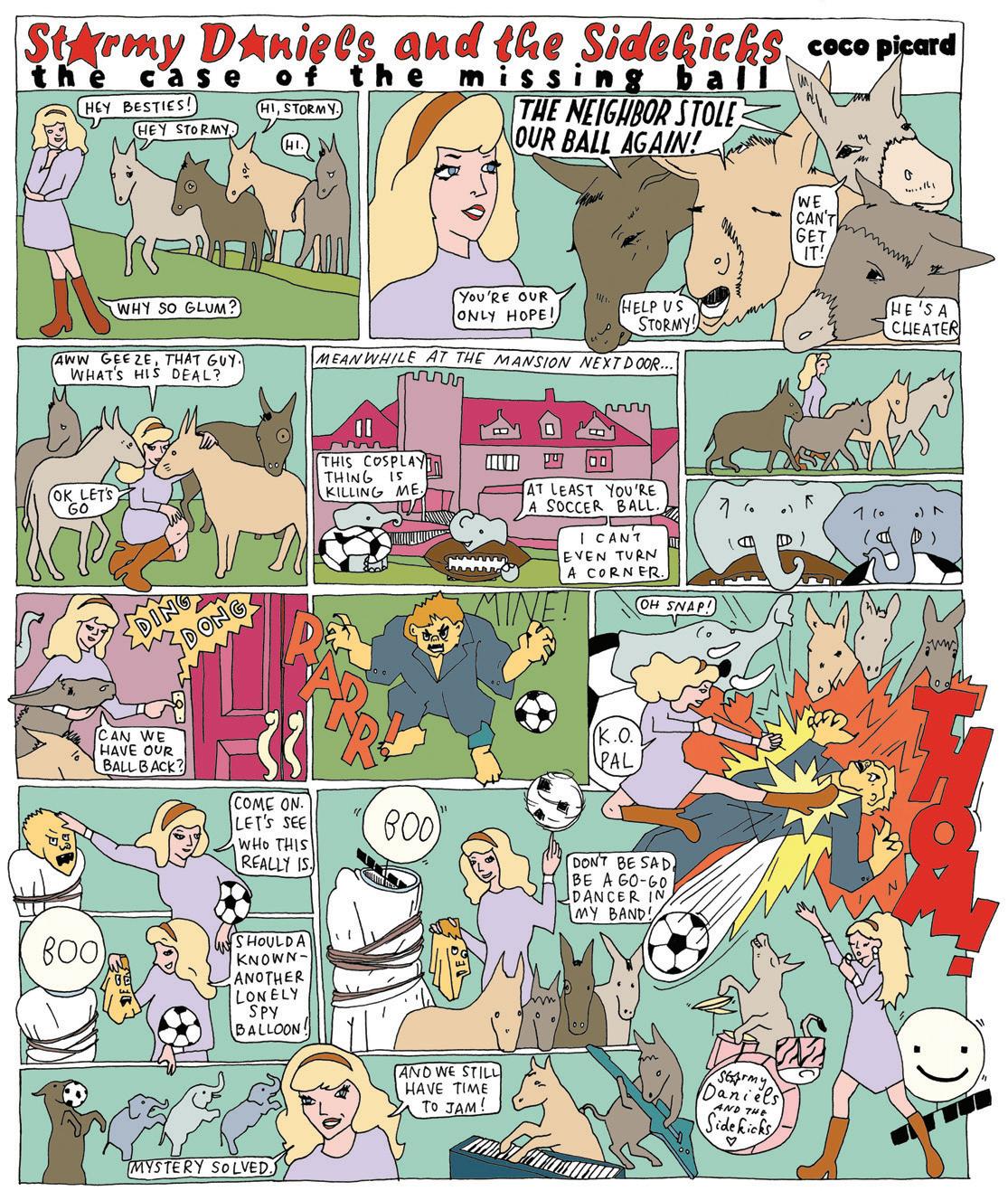
Q : My partner wants me to give him a ruined orgasm. Where do I go to learn that?
a : Ruined orgasms are pretty easy. They’re so simple, in fact, that people sometimes give them to (or inflict them upon) their male partners by accident.
Here’s how you do it: bring your partner to the point of orgasmic inevitability— get him to that point where there’s no stopping his orgasm: even if Marjorie Taylor Greene were to burst in the room, he’s going to come—and then cease all stimulation. Take your hand off his dick, take his dick out
of your mouth, li your pussy or ass off his dick—whatever you were doing to get hiim close, stop. He’ll come, but it won’t be anywhere near as pleasurable or intense as his usual orgasms, i.e., the orgasms he has when his cock is stimulated to and through the point of orgasm.
Q: How can I be more fuckable? I put myself out there, but no one bites. I’m done being a 31-year-old gay virgin. I am a clean person, shower every day, wear clean clothes, and was voted “most likely to brighten up a day” in school.

a: Maybe you’re doing something wrong—but I couldn’t tell you what that might be without meeting you, getting to know you, and making polite inquiries about your voting history. But I can tell you what I would do if I were in your shoes: I would hire a brutally honest “life coach,” a personal trainer, and a hooker, but in reverse order.

Q: What’s your number one tip for someone who has never been to a sex party before? It includes a wide range of ages, genders, orientations, and proclivities, and many nervous newbies on the invite list.
a: Bathe.
Q: Can a person who has always had open sexual relationships become monogamous?
a: Yes.
Q: I never visualize having sex with my husband anymore. In my mind, it’s always someone else. Is that bad?
a: No.
Q: Why is anonymous sex— in places like bathhouses and glory holes—so enticing to queer people like me?
a: Lesbians aren’t exactly crowding into bathhouses or around glory holes—nor are asexuals, demisexuals, sapiosexuals, etc., etc., etc. So, I’m going to assume you’re a gay man. Before I write another word: not all gay men find anonymous sex and/or public sex environments enticing. But the ones who do . . . they’re not doing it because they’re gay. They’re doing it because they’re men. I mean, if you told straight men there were placees where walls had holes in them and women were kneeling on the other side of those walls waiting to suck them off, straight men would go to those places There’s nothing gay men do that straight men wouldn’t if straight men could but
straight men can’t because women won’t. As for why women won’t . . . the answer is equal parts disinterest (on the part of most women) and an entirely reasonable fear of male sexual violence (on the part of all women).
Q: What do you do when you’re bored with the sexual smorgasbord and just want a few nights in?
a: You spit the dick out and go home.
Q: Quick etiquette question: Can I use my fucking machine in a hotel room?
a: You’re allowed to fuck in hotel rooms. But fucking machines—at least the ones I’ve been in the same room with—are pretty fucking loud. They start loud, they stay loud. People fucking, on the other hand, typically only get loud toward the end of the fucking; once you can hear two people fucking in the room next to yours, you know it’s almost over. So, while I think we all have to put up with a little noisy fucking in the next room from time to time, I don’t think it’s reasonable to expect the
guests in the next room to put up with the noise of a fucking machine.
Q: I’m in love with my roommate. I think he likes me too. I just fear losing his friendship if I tell him. Any thoughts on how I should handle this?

a: If you don’t open your mouth . . . your roommate can’t stick his dick in there. Just don’t open your mouth and say, “I’m in love with you,” as that will instantly dial the emotional stakes up to 11. Instead, tell your roommate you’re attracted to him and reassure him—before he can even respond—that you will get over the awkwardness (and him) if he doesn’t feel the same way about you.

Q: How can I help a quick shooter have a slower draw? This D isn’t lasting long enough for me!


a: Some medications seem to help premature ejaculators—excuse me: some medications seem to help persons experiencing premature ejaculation (PEPE). Additionally, some PEPEs can train themselves to last longer by jacking off a few hours before sex with a partner, strengthening their pelvic floors, and edging themselves endlessly. But if nothing helps—and sometimes nothing does— and delaying penetration until a er you’re satisfied doesn’t work (because only a good, long, hard fuck can satisfy you), and your guy isn’t insecure about how his dick works, you should get a strap-on dildo. They’re suddenly everywhere in gay porn . . . and we all know what that means. (It means straight people will be giving each other strap-on dildos as wedding presents by next summer.)
Q: Top tips for being a good/smart third when playing with a couple?
a: Be clear about your expectations—what you’re into, what you’re not, what you’re comfortable with, what you aren’t—and politely decline if they aren’t clear about their expectations.
Q: Why do people say “ethical non-monogamy” when they just mean “dating”?

a: Because they mean different things. While some ENM people do date, some people in ENM relationships aren’t interested in dating (or allowed to date) outside sex partners; they don’t describe themselves as “dating” because 1. they aren’t dating, and 2. they don’t want to (or shouldn’t want to) mislead potential outside sex partners. And while people who ultimately want a committed ENM relationship can and do date, lots of people who date— lots of people out there fucking around with multiple partners—ultimately want a committed monogamous relationship and identifying as ENM would be misleading.
Q: I love sex, but I don’t enjoy getting off or seeing come. Is that weird?
a: Yes.
Q: Any queer-cuck related porn that you’d recommend?
a: Jack Hornwood’s erotic novellas (jackhornwood.com) are highly recommended. v
Ask your burning questions, listen to podcasts, read more columns, and more at savage.love!

@fakedansavage

Renowned photographer and activist Shahidul Alam exposes the resilience of Bangladeshi people and their continued struggle for freedom over four decades.

An immersive experience tracing the epic journey of legendary Chinese poet Qu Yuan to a cyberpunk future; part comic book, part animated film, part meditation on history, Kongkee takes you back to the future.


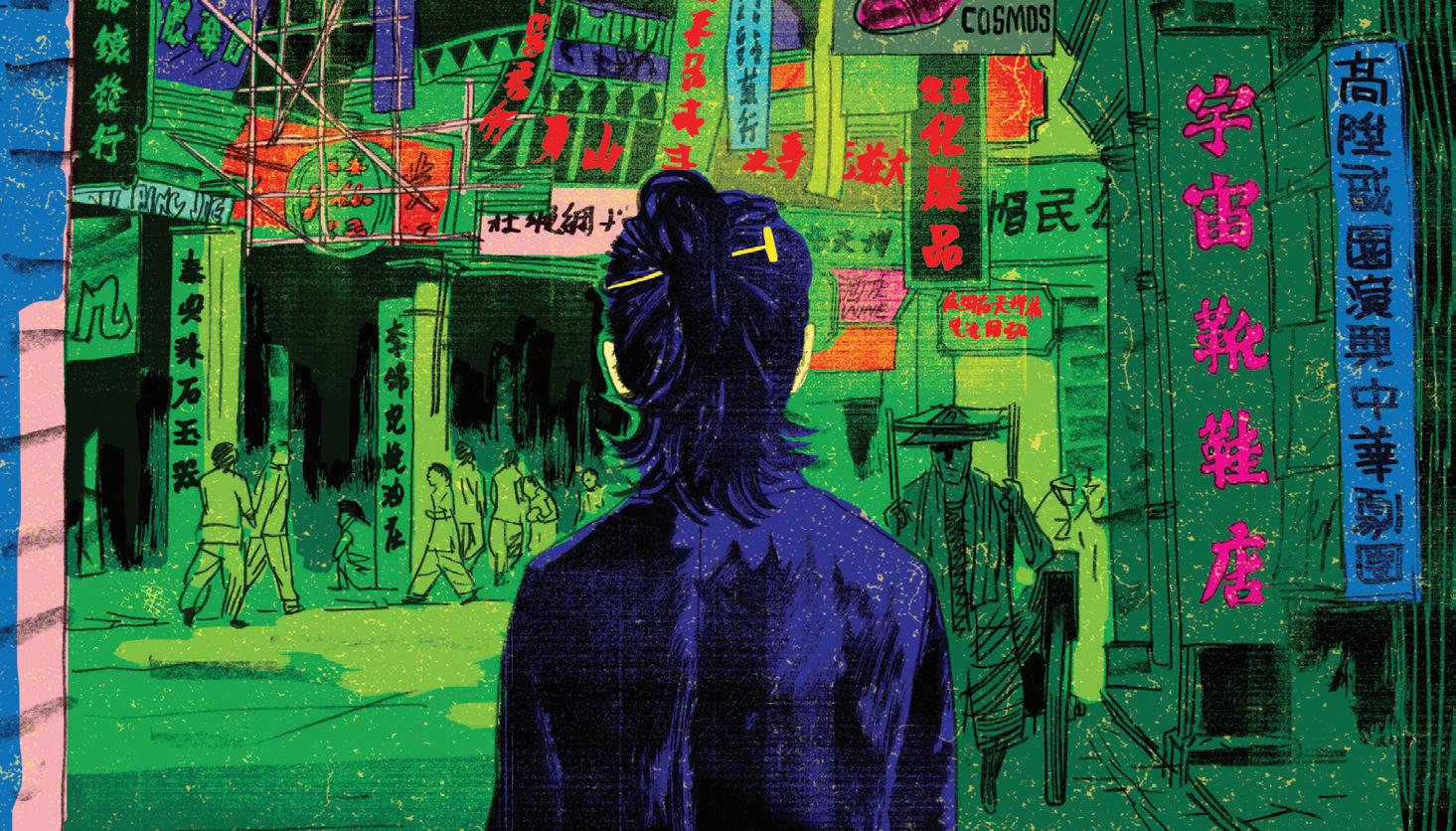
Traveling Chicago by bike, always with his camera, Patric McCoy captures 1980s Black gay Chicago, creating a poignant marker of place, time and memory.
